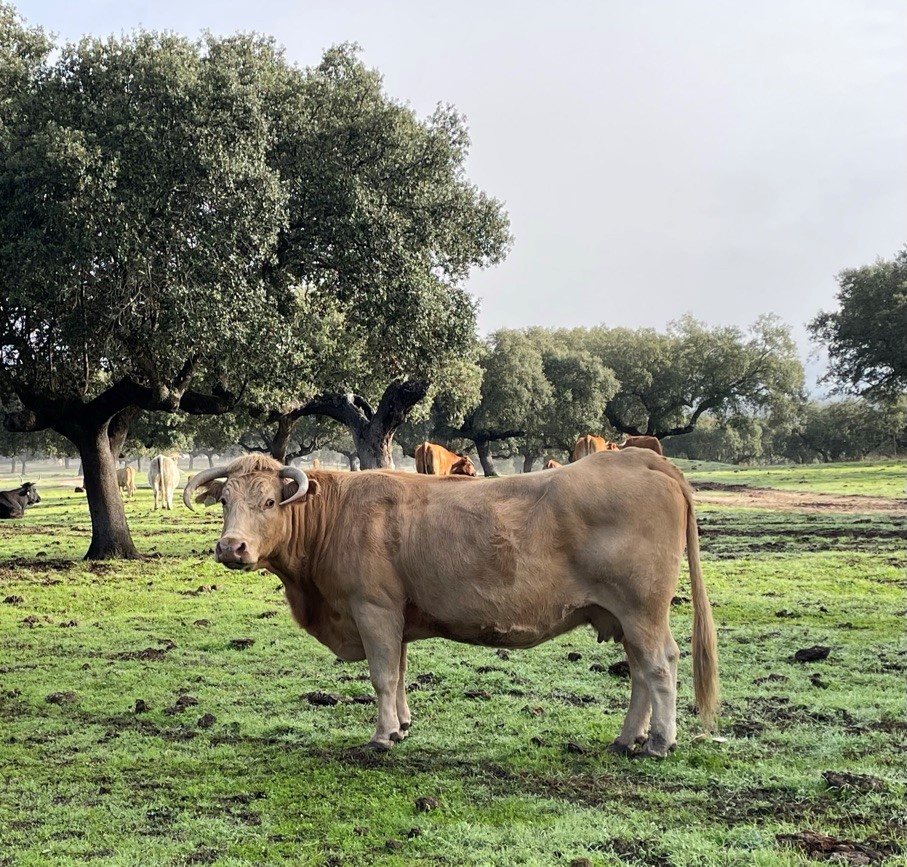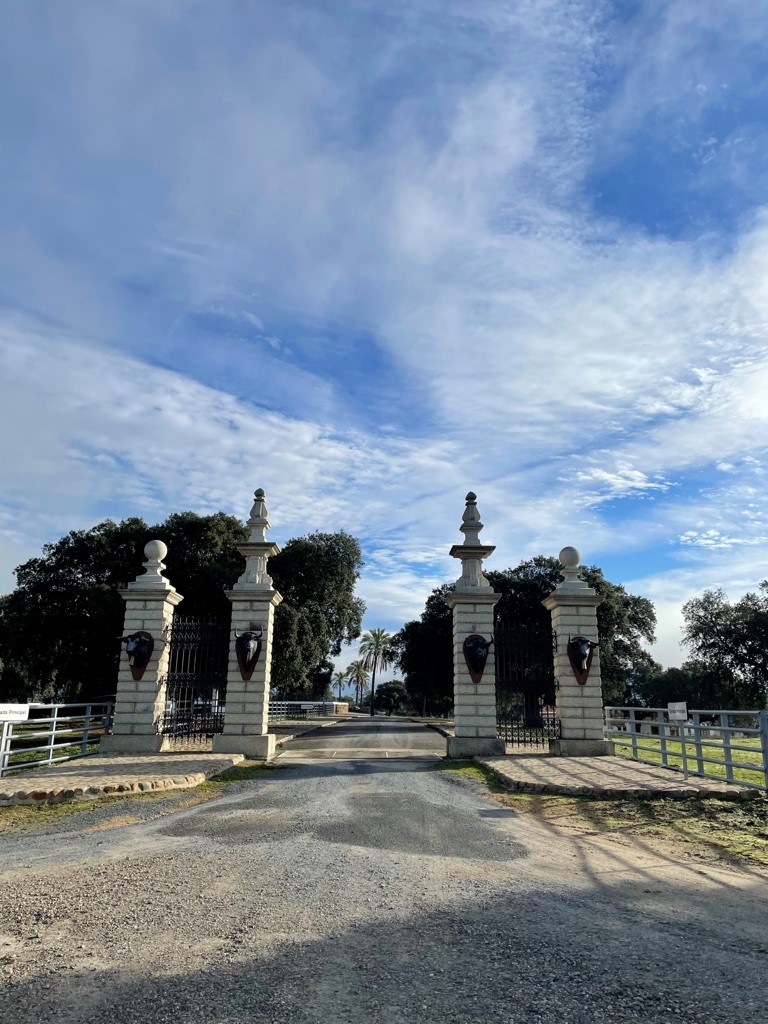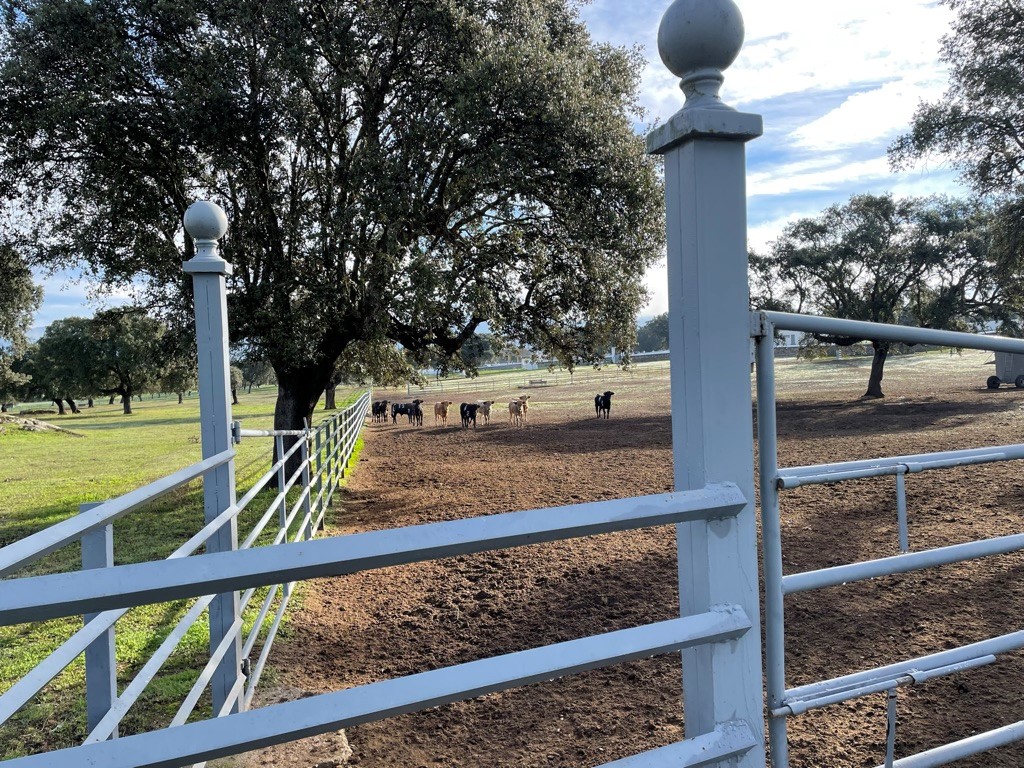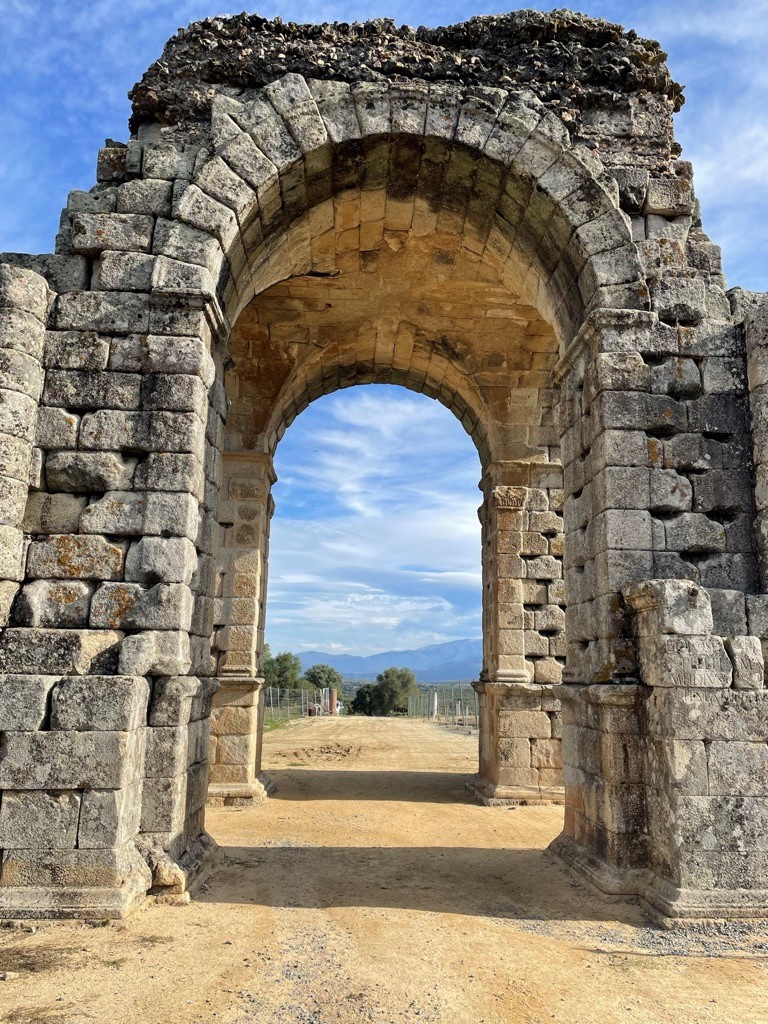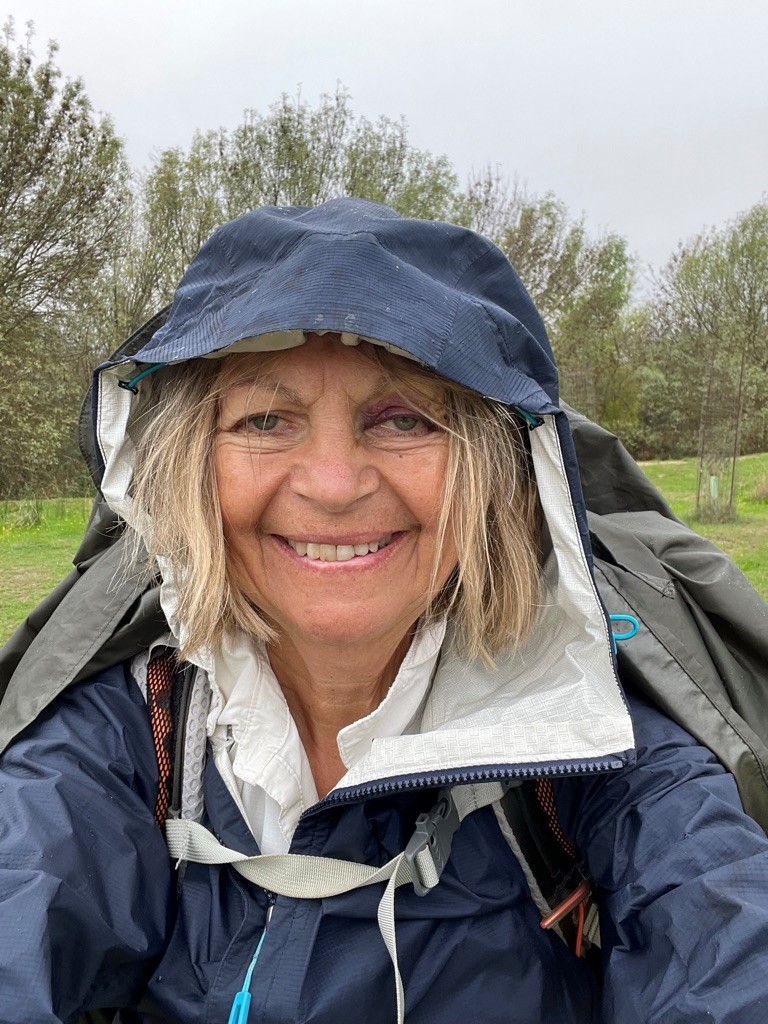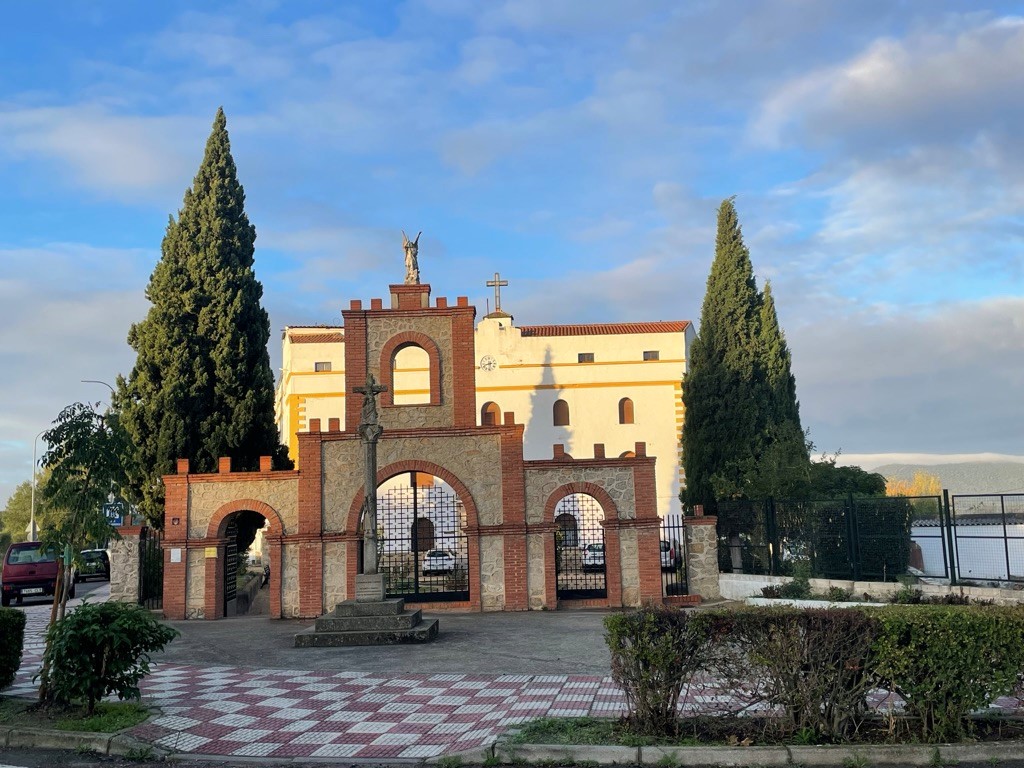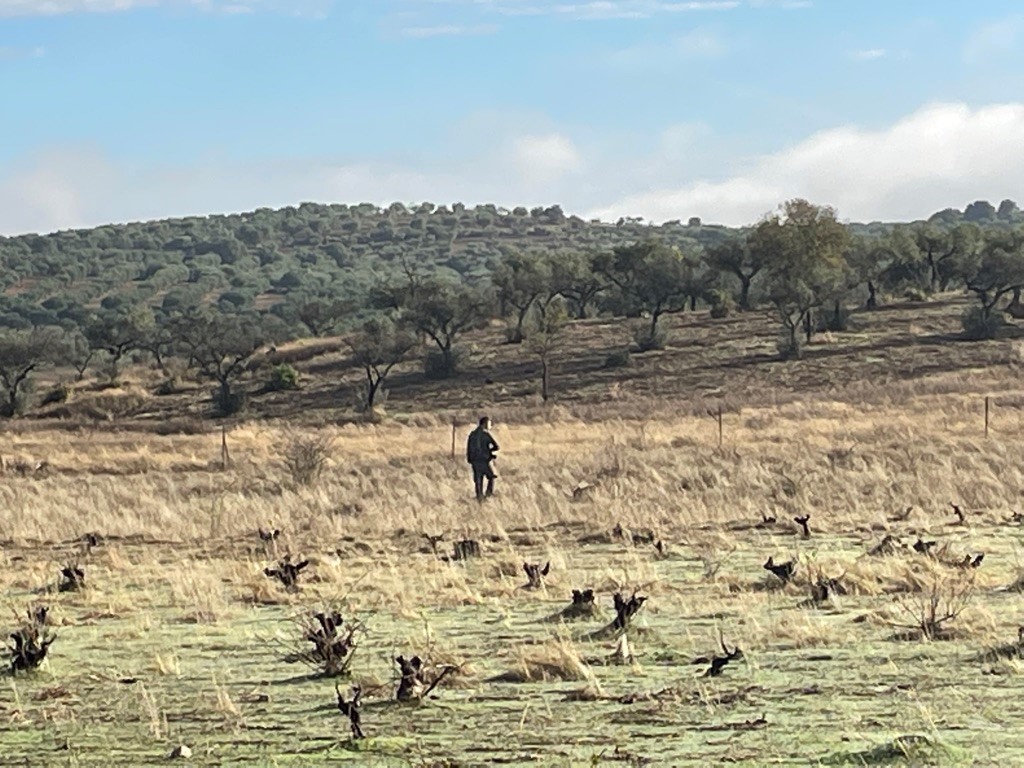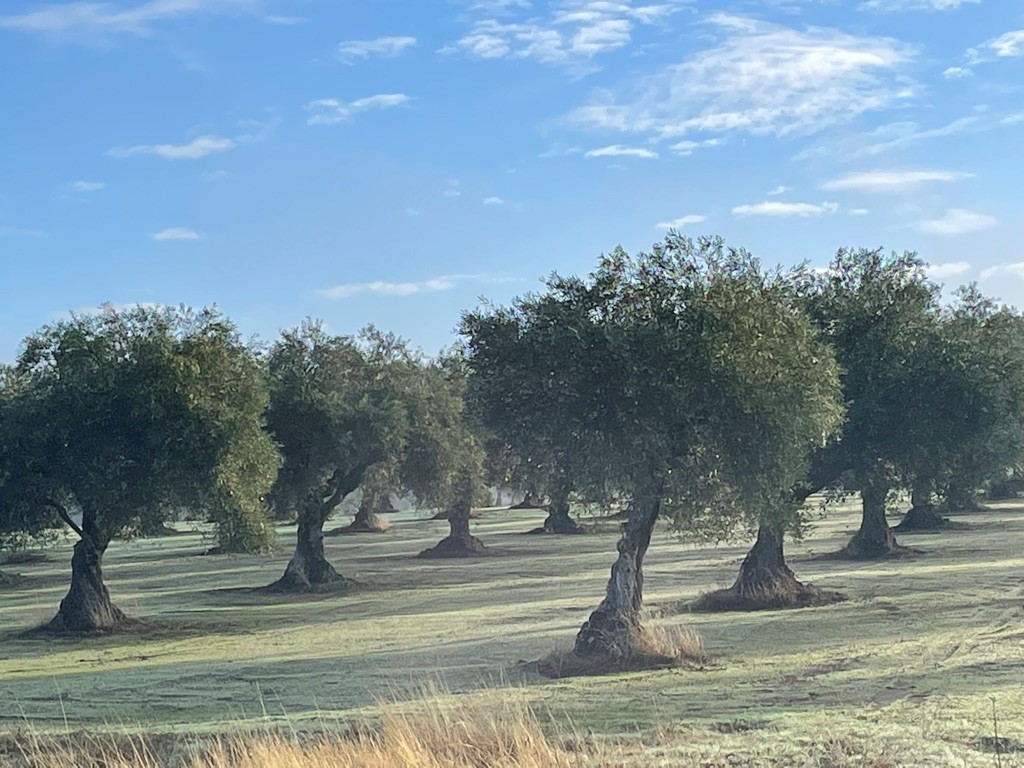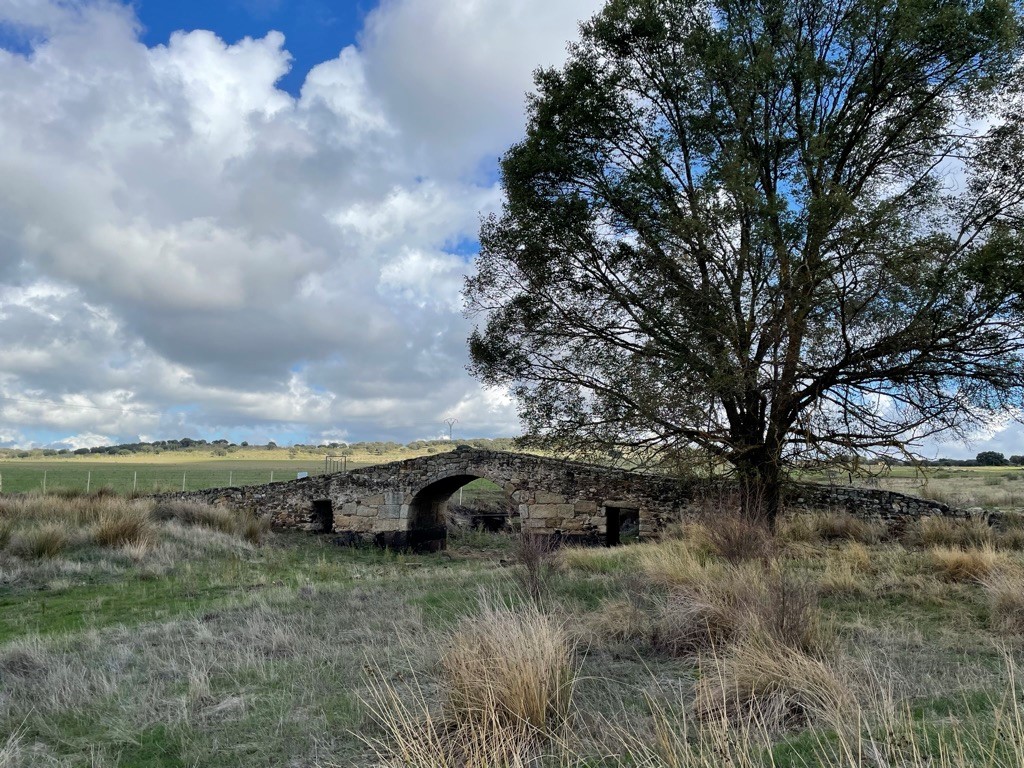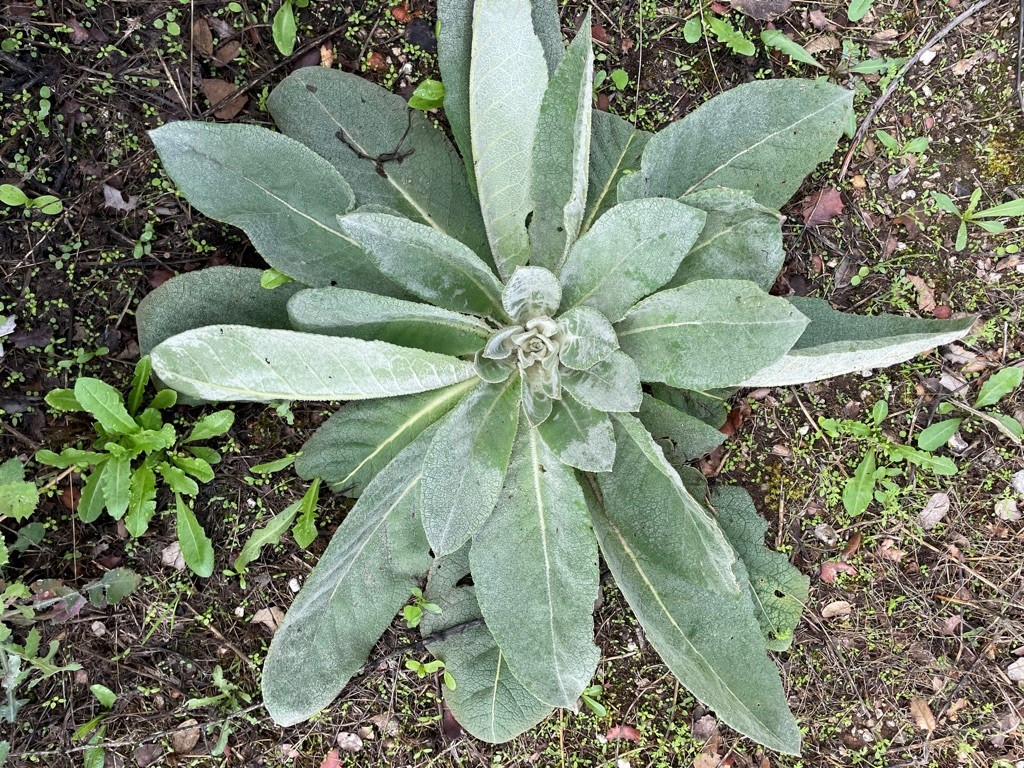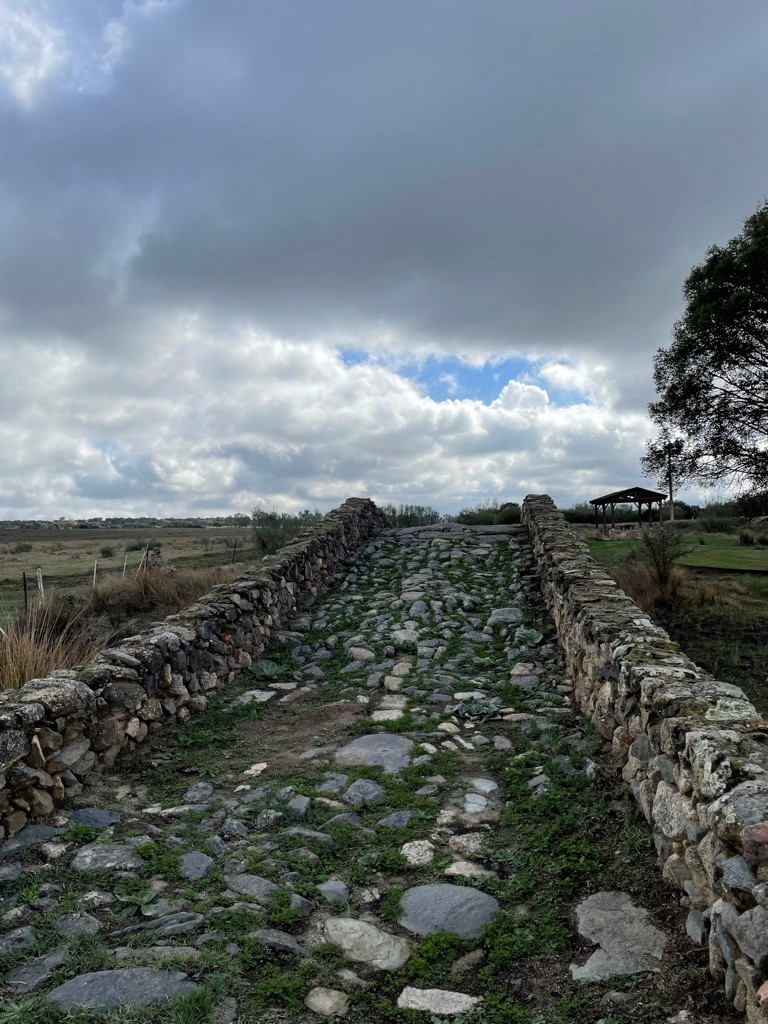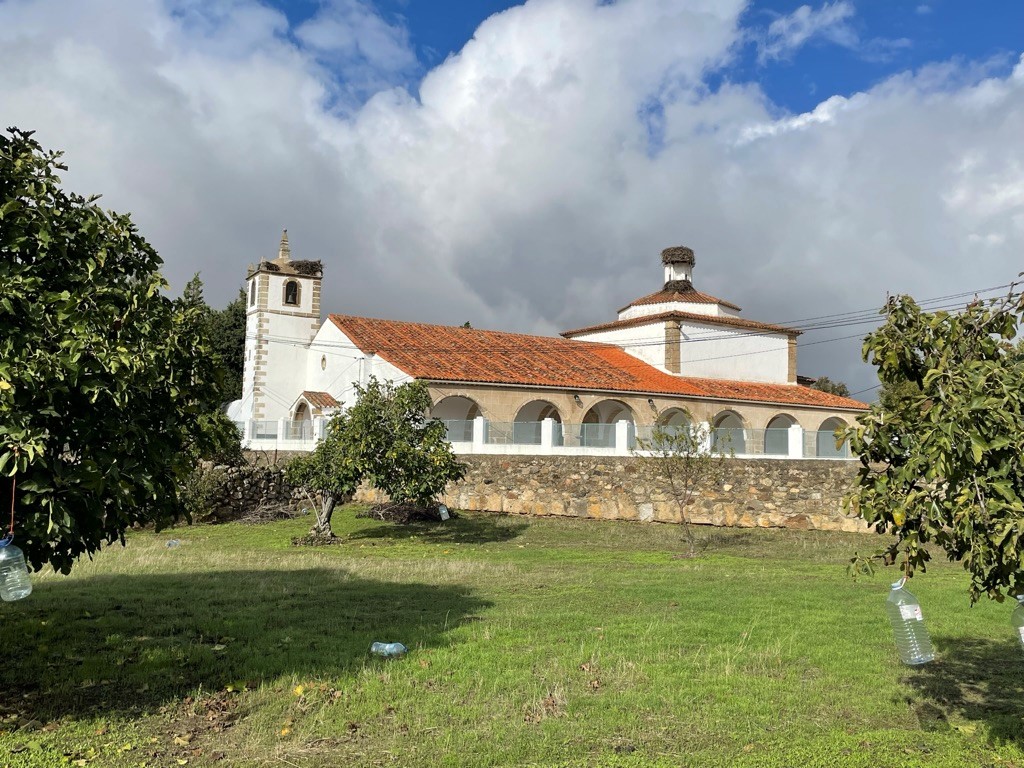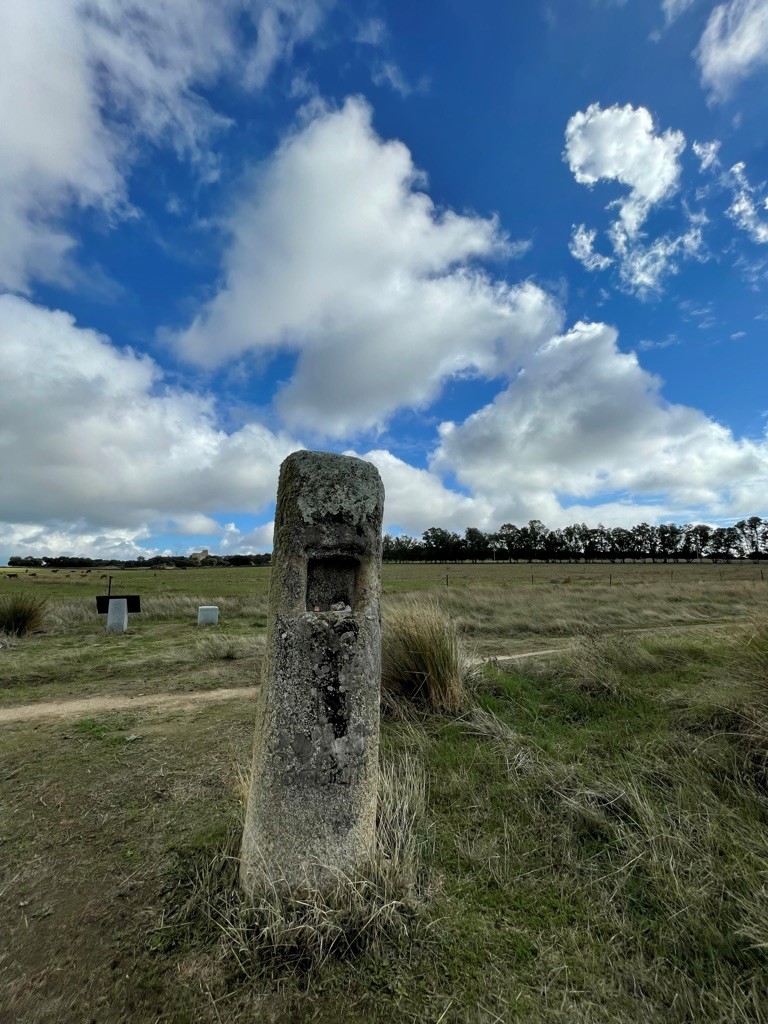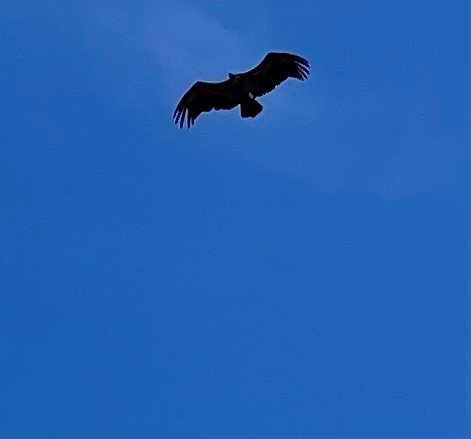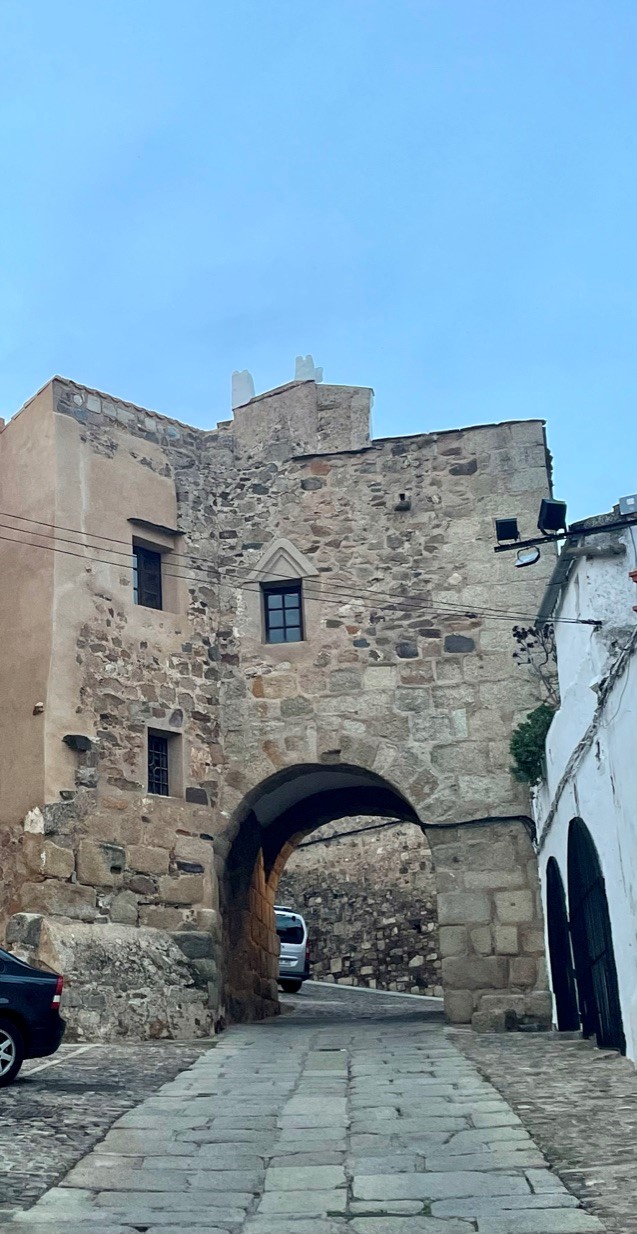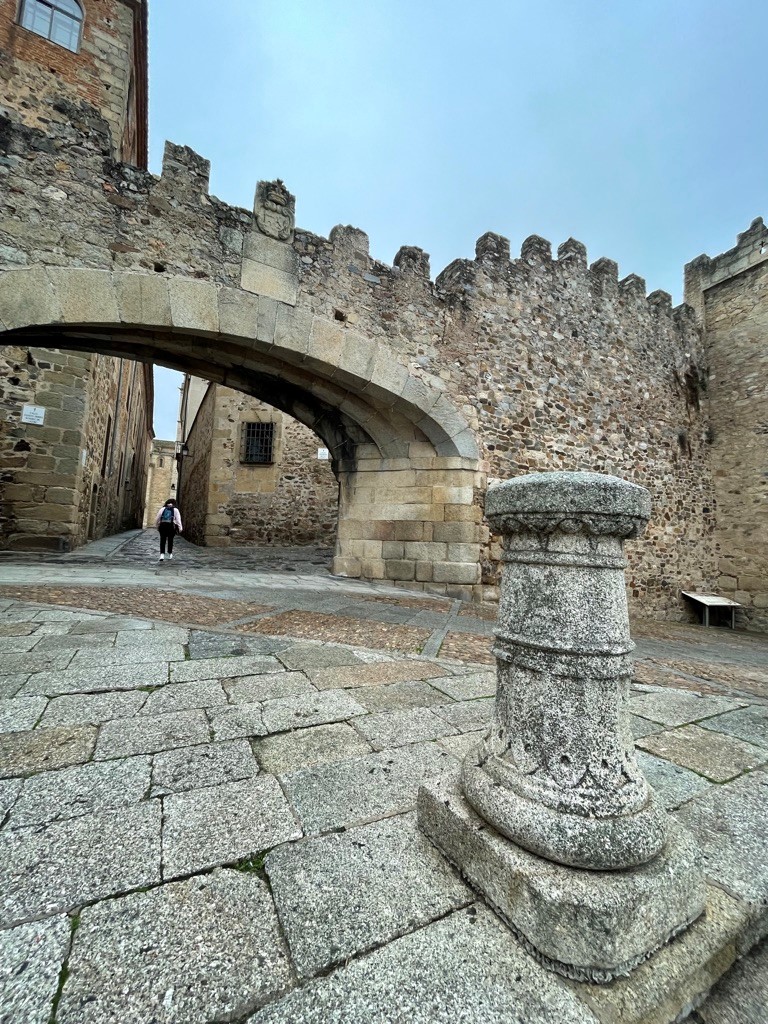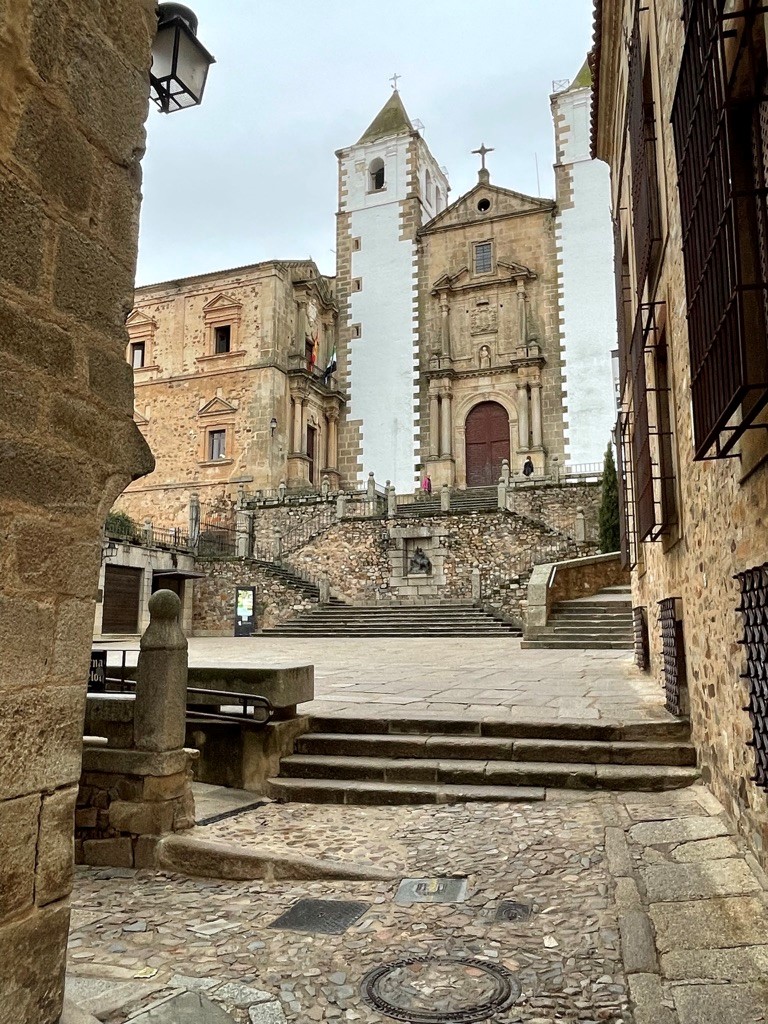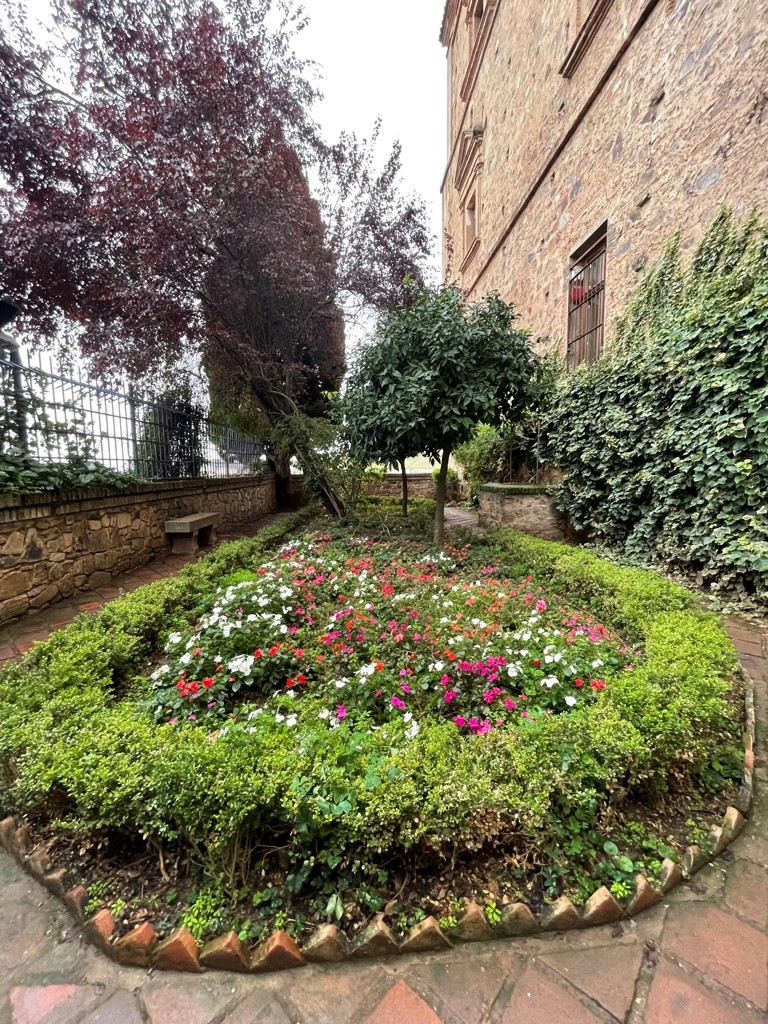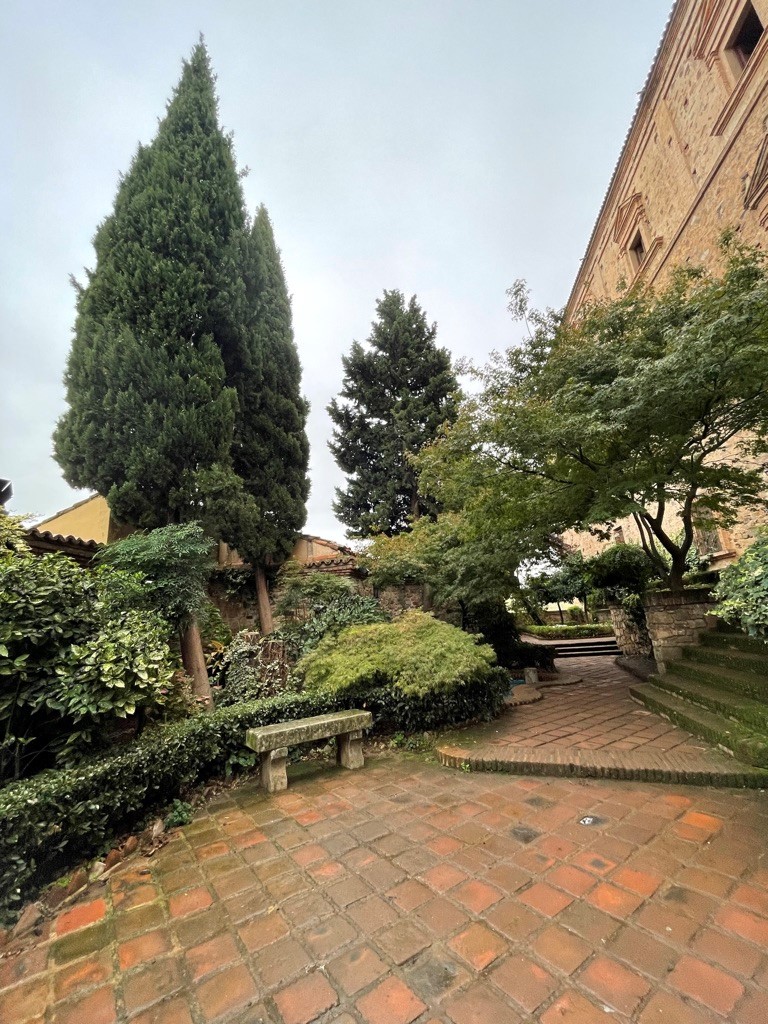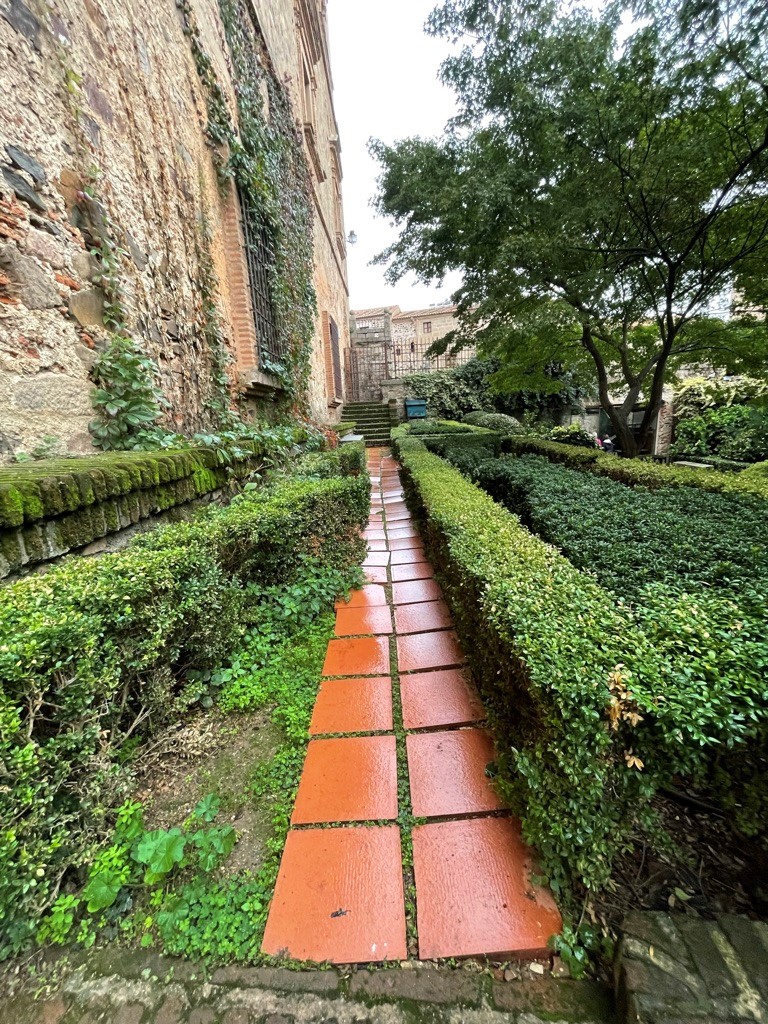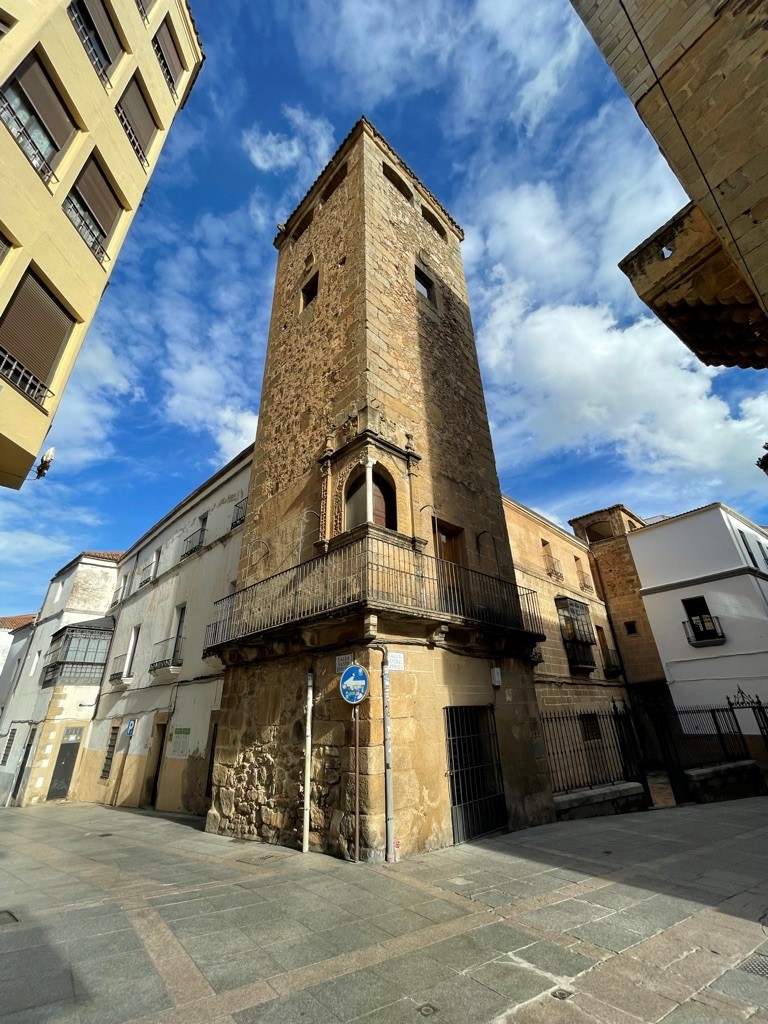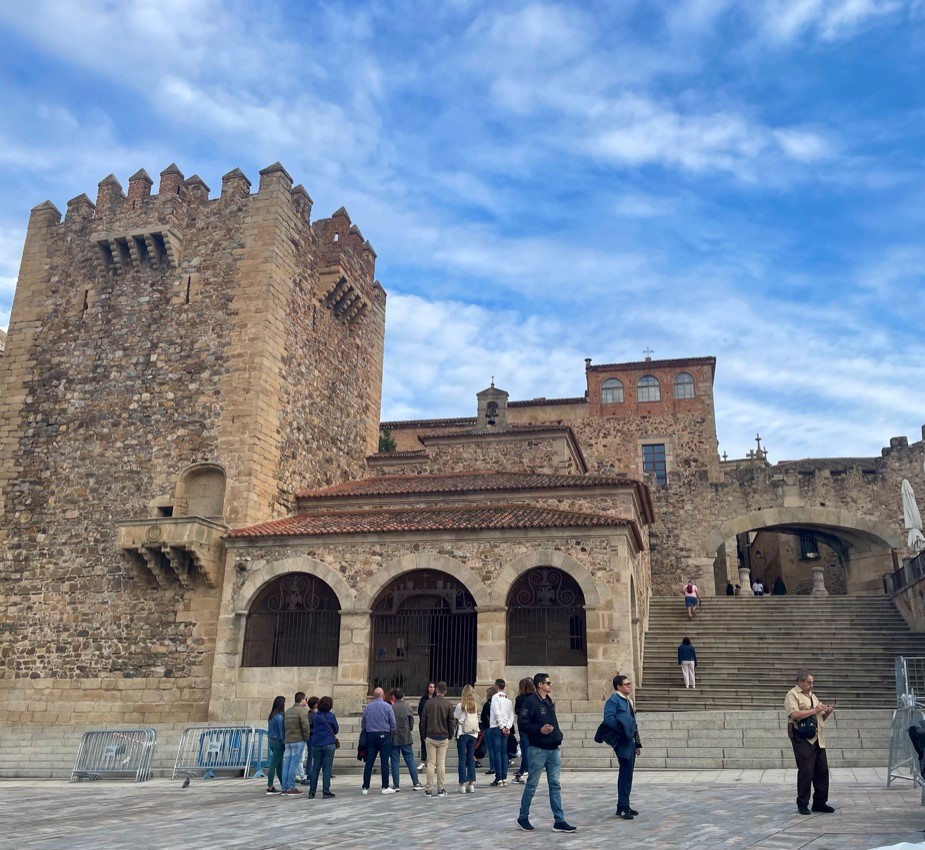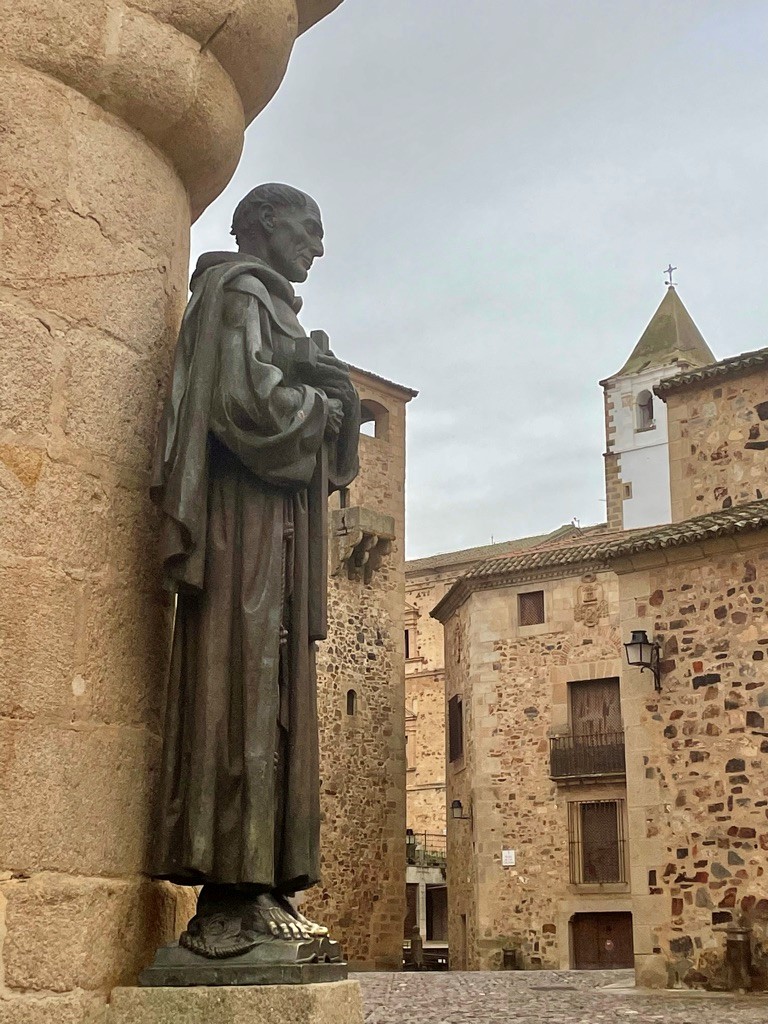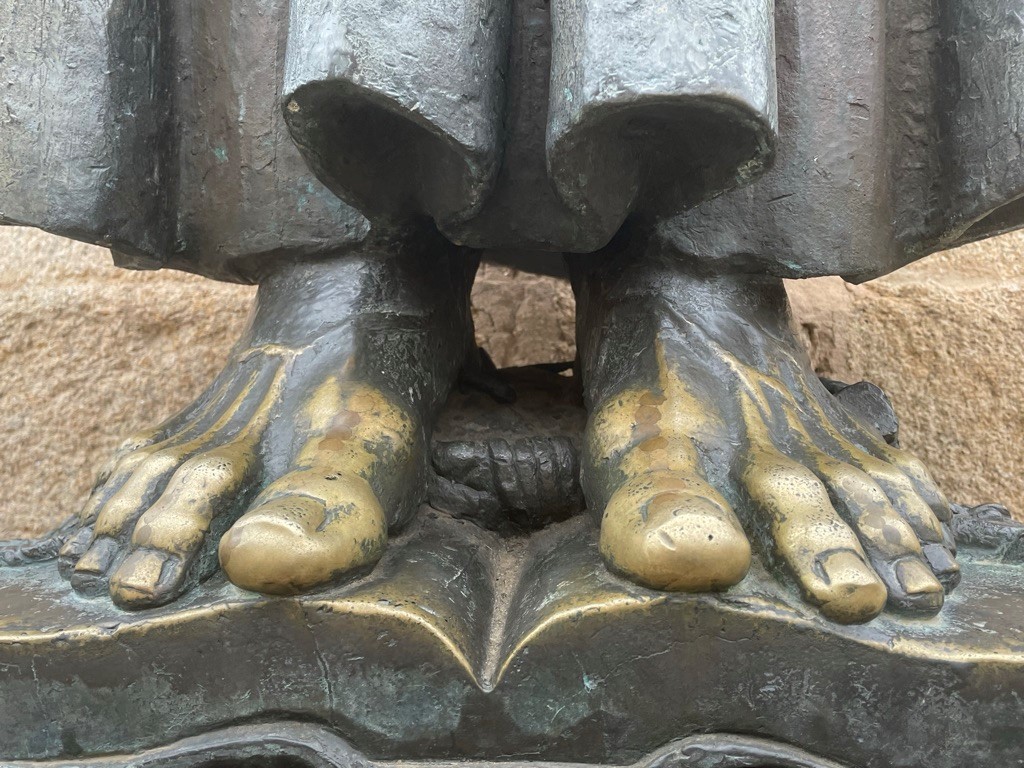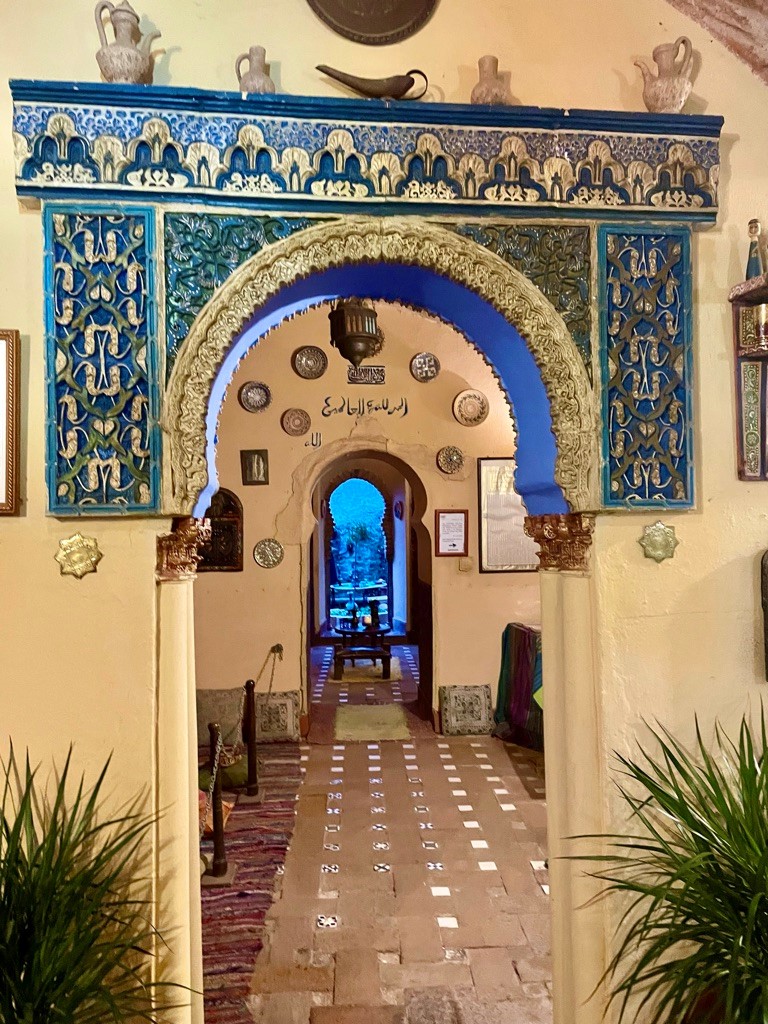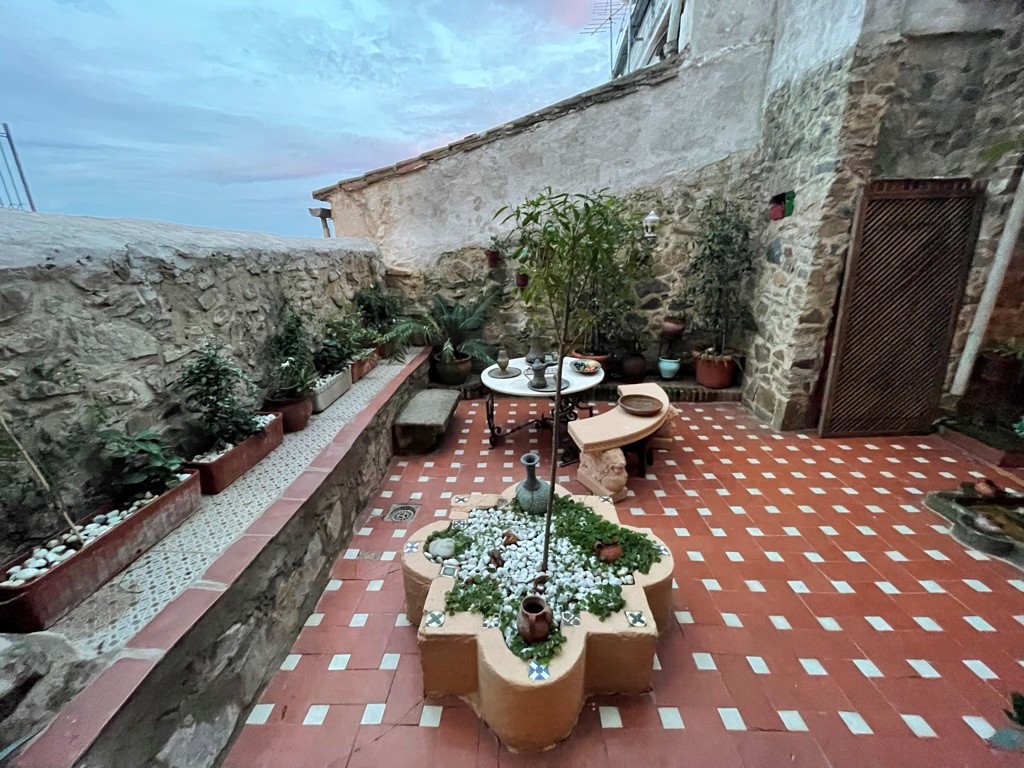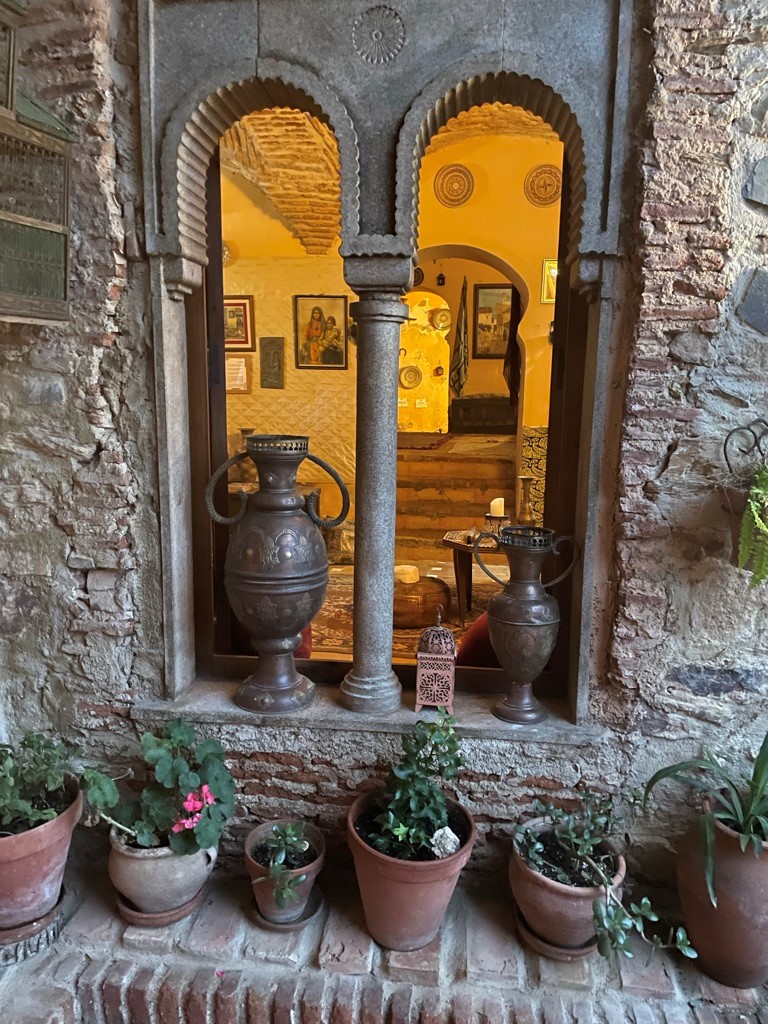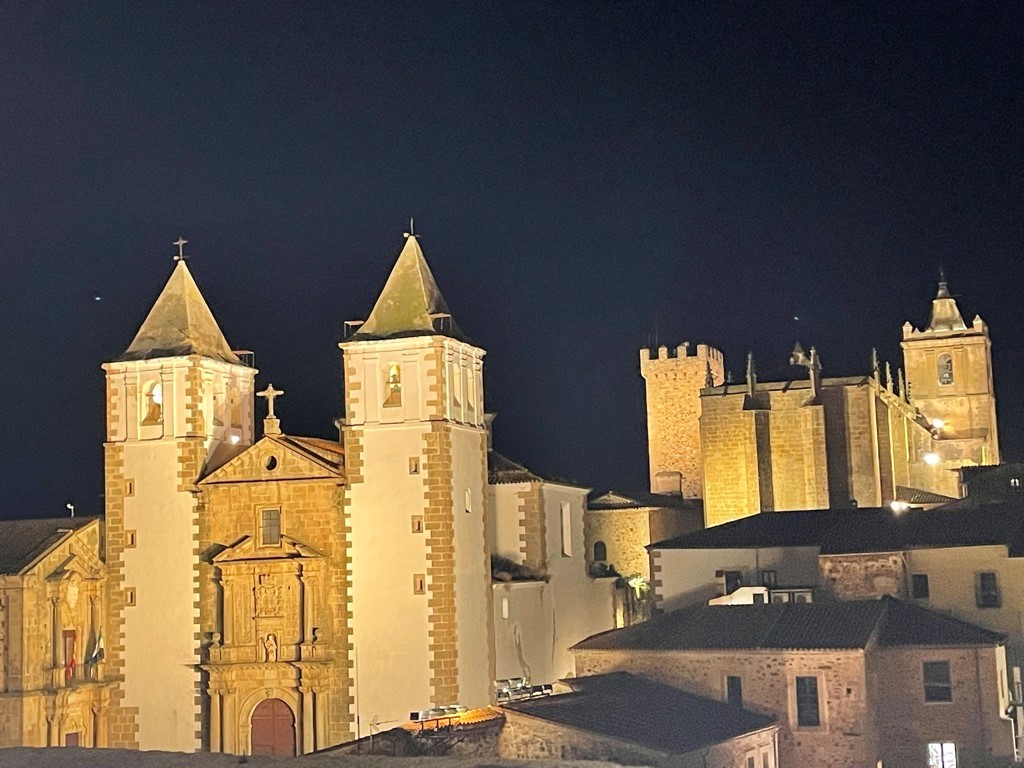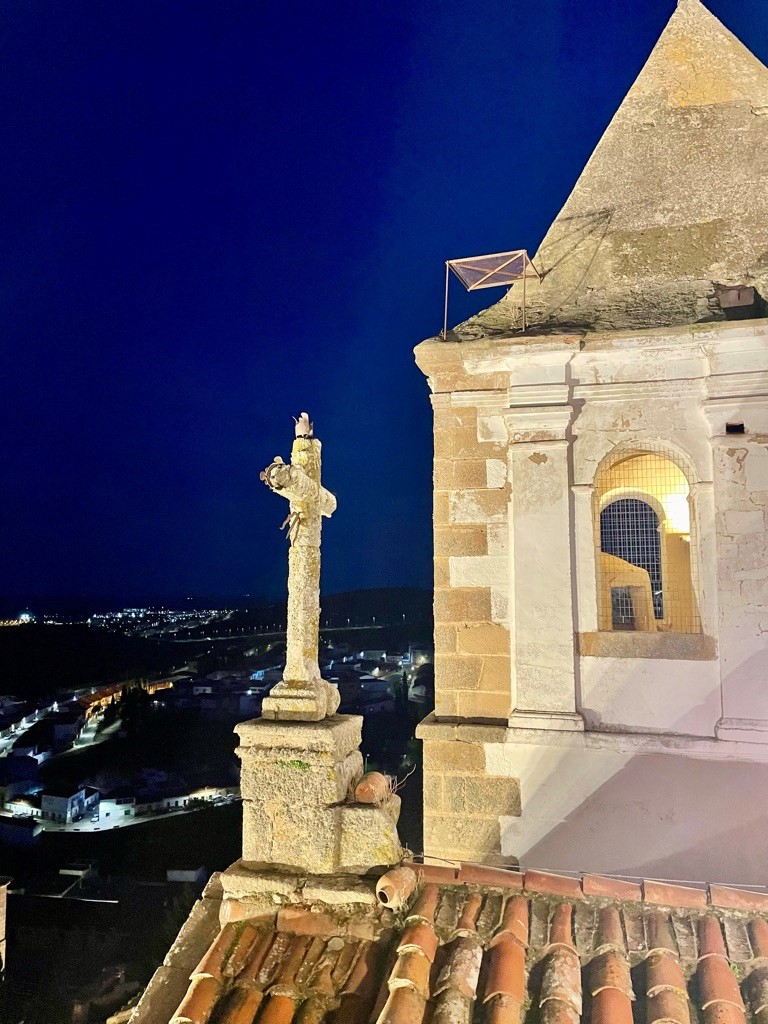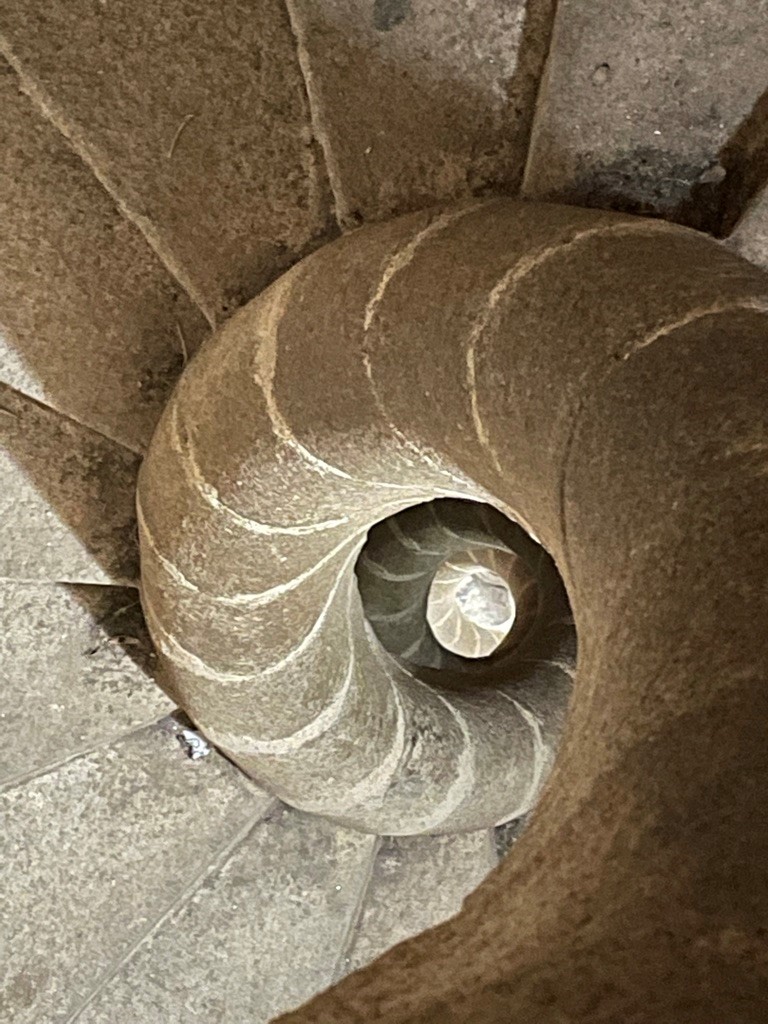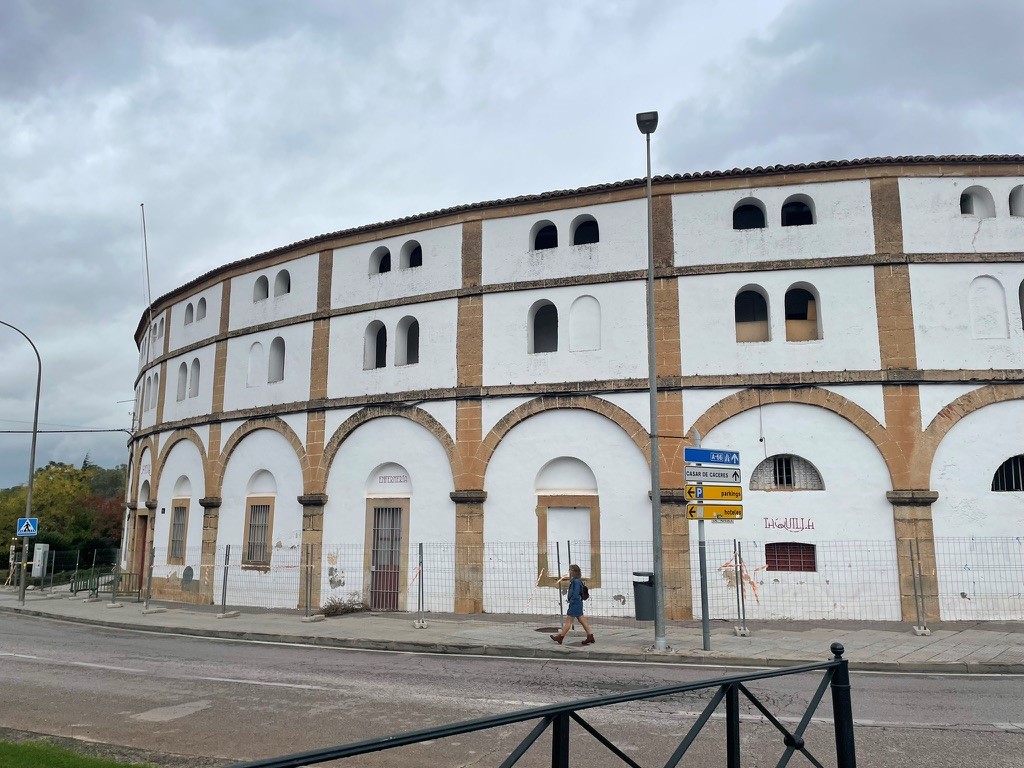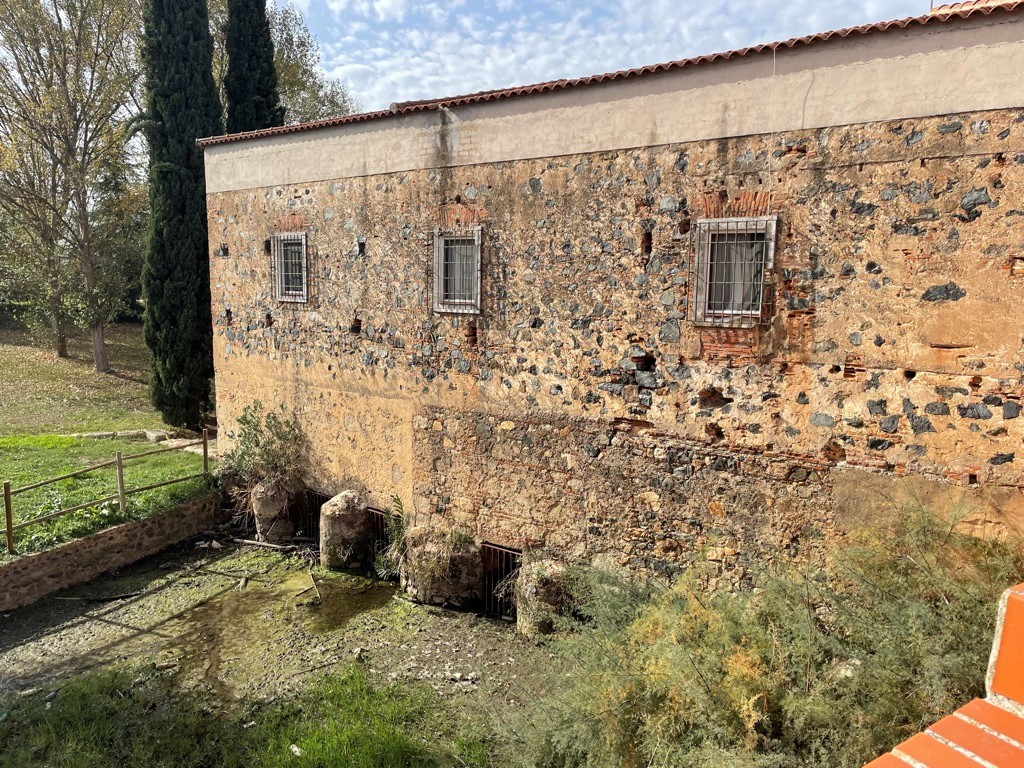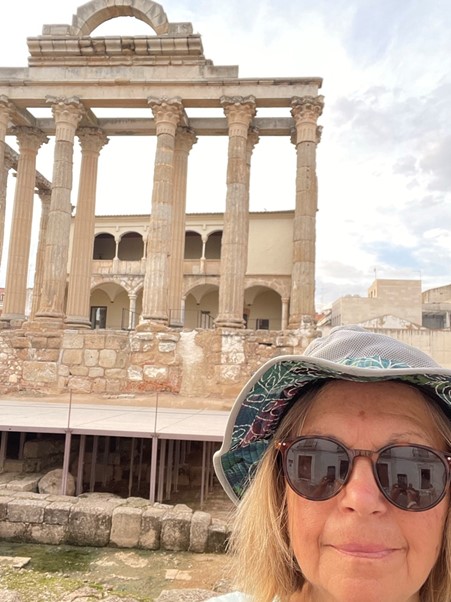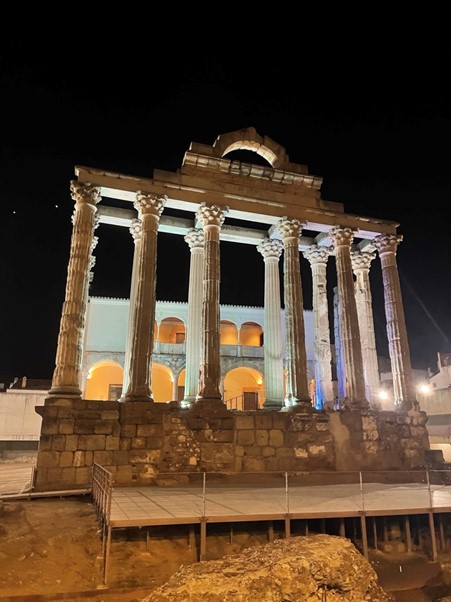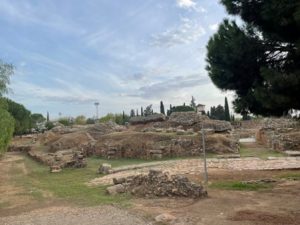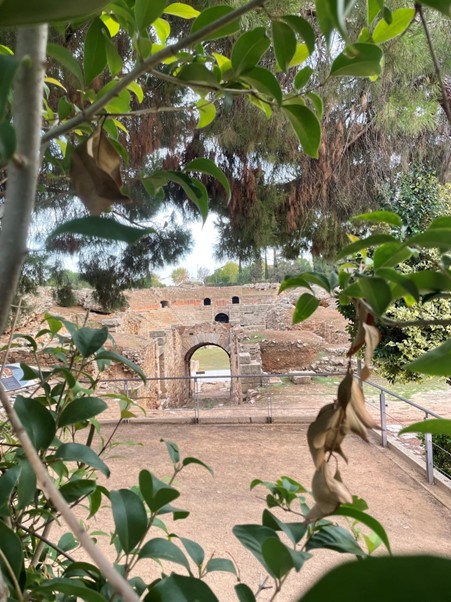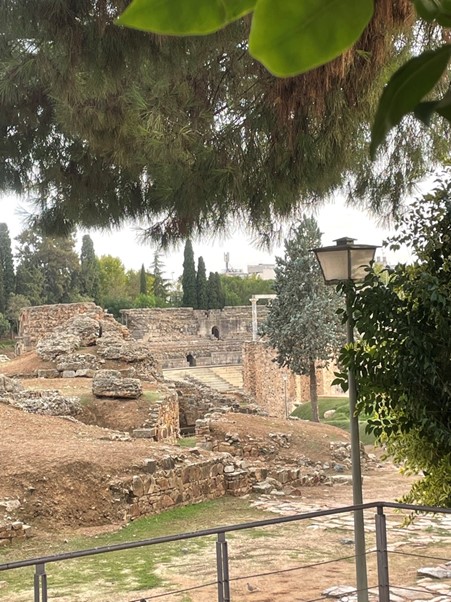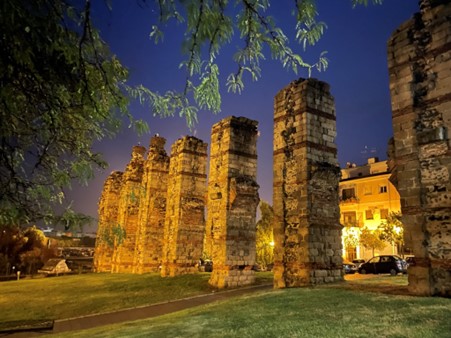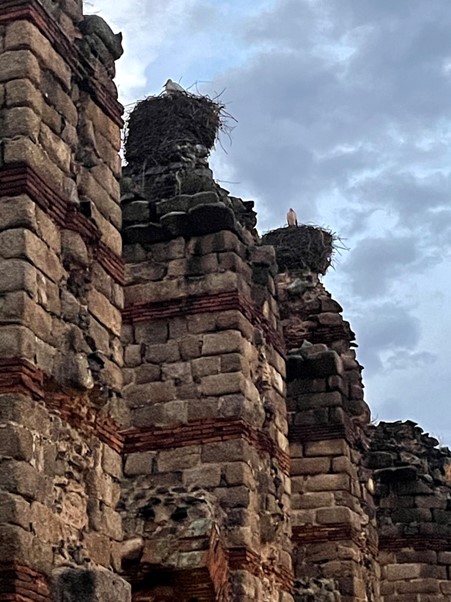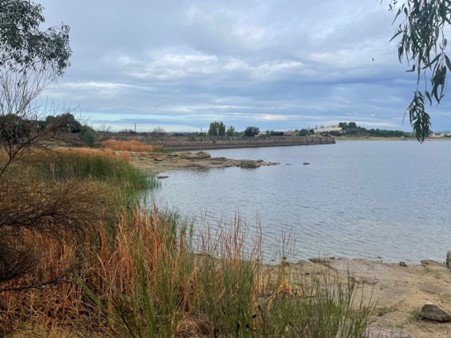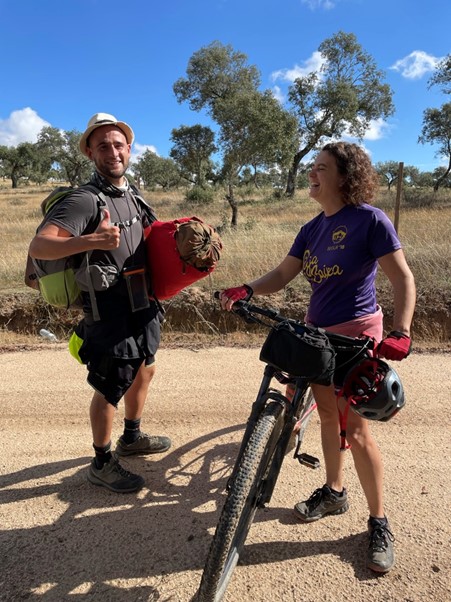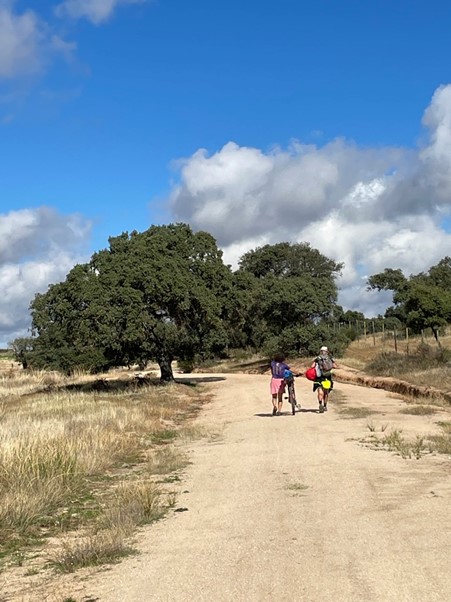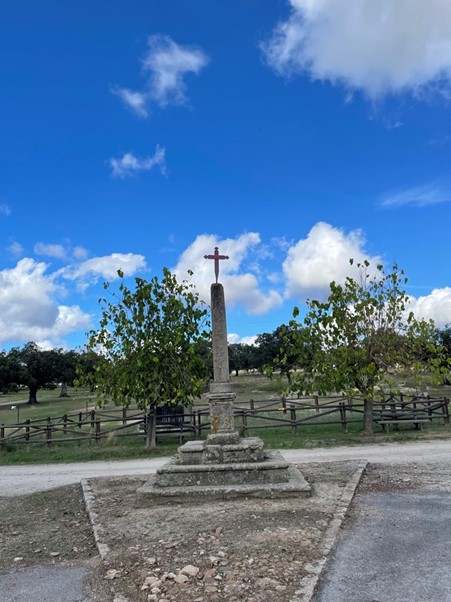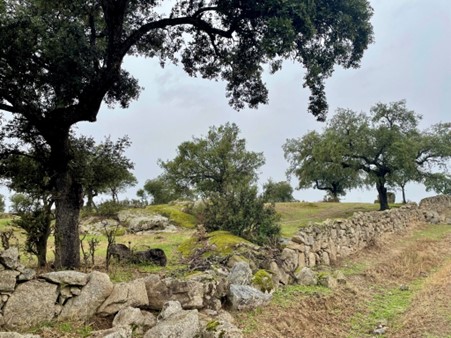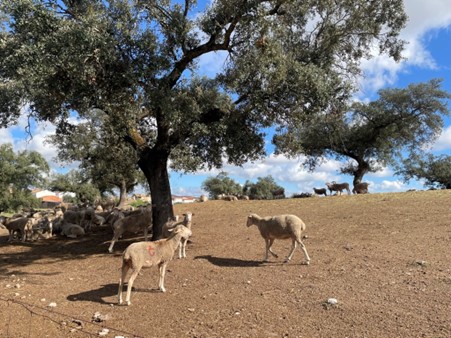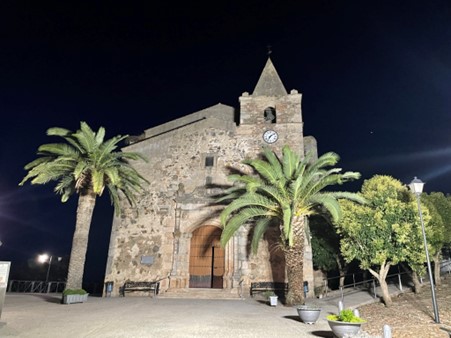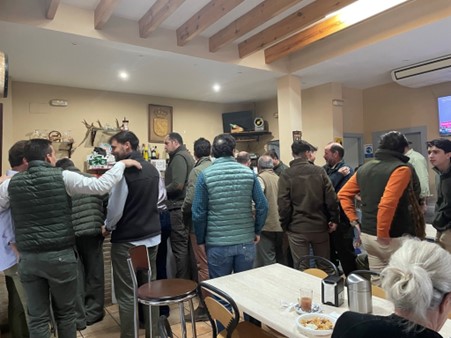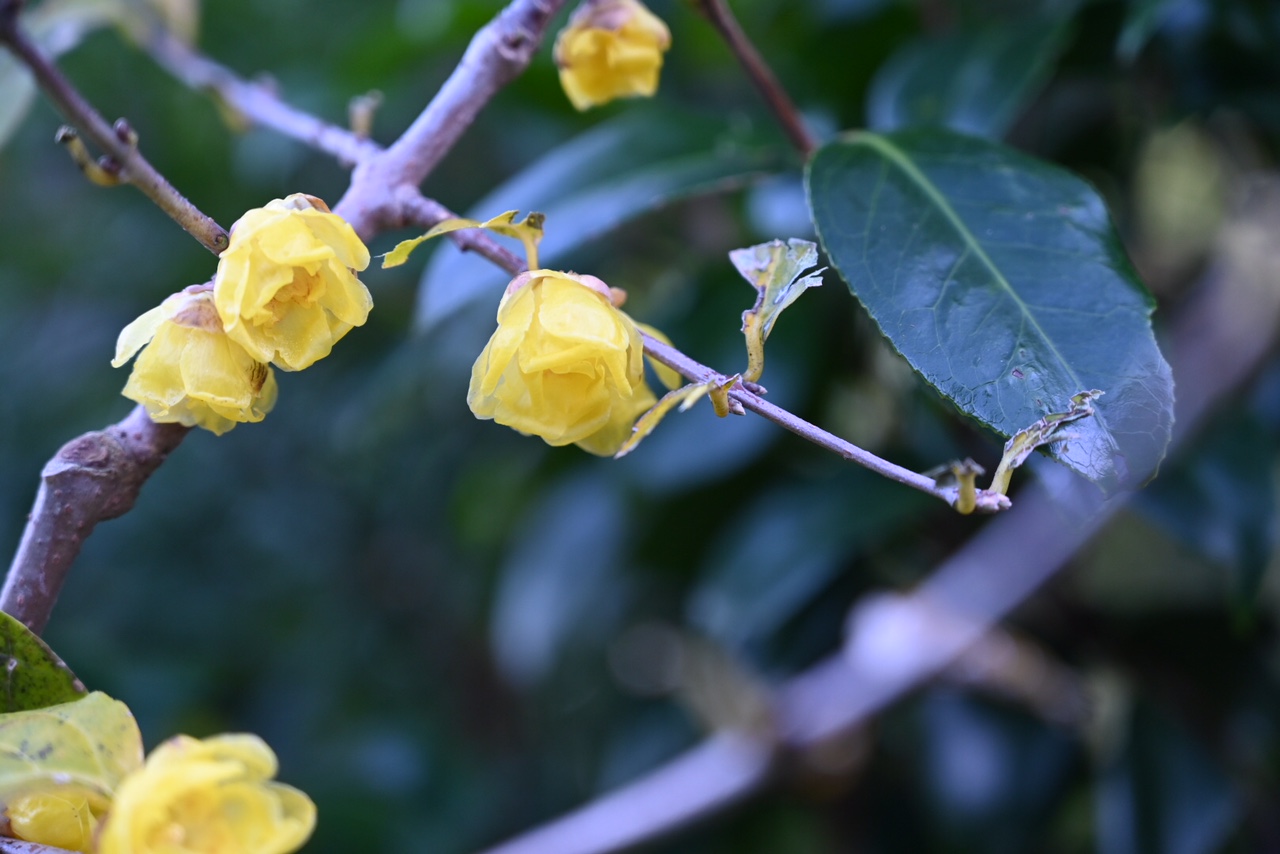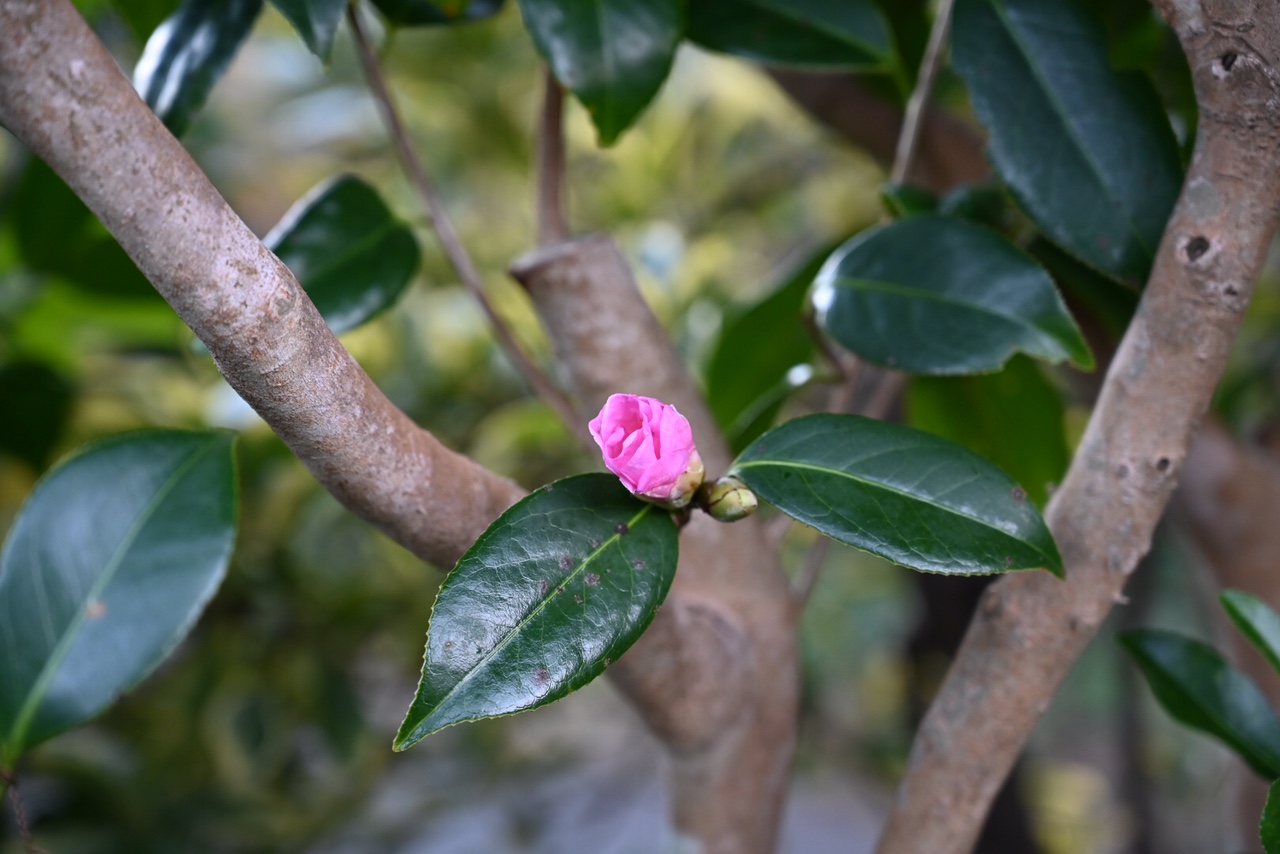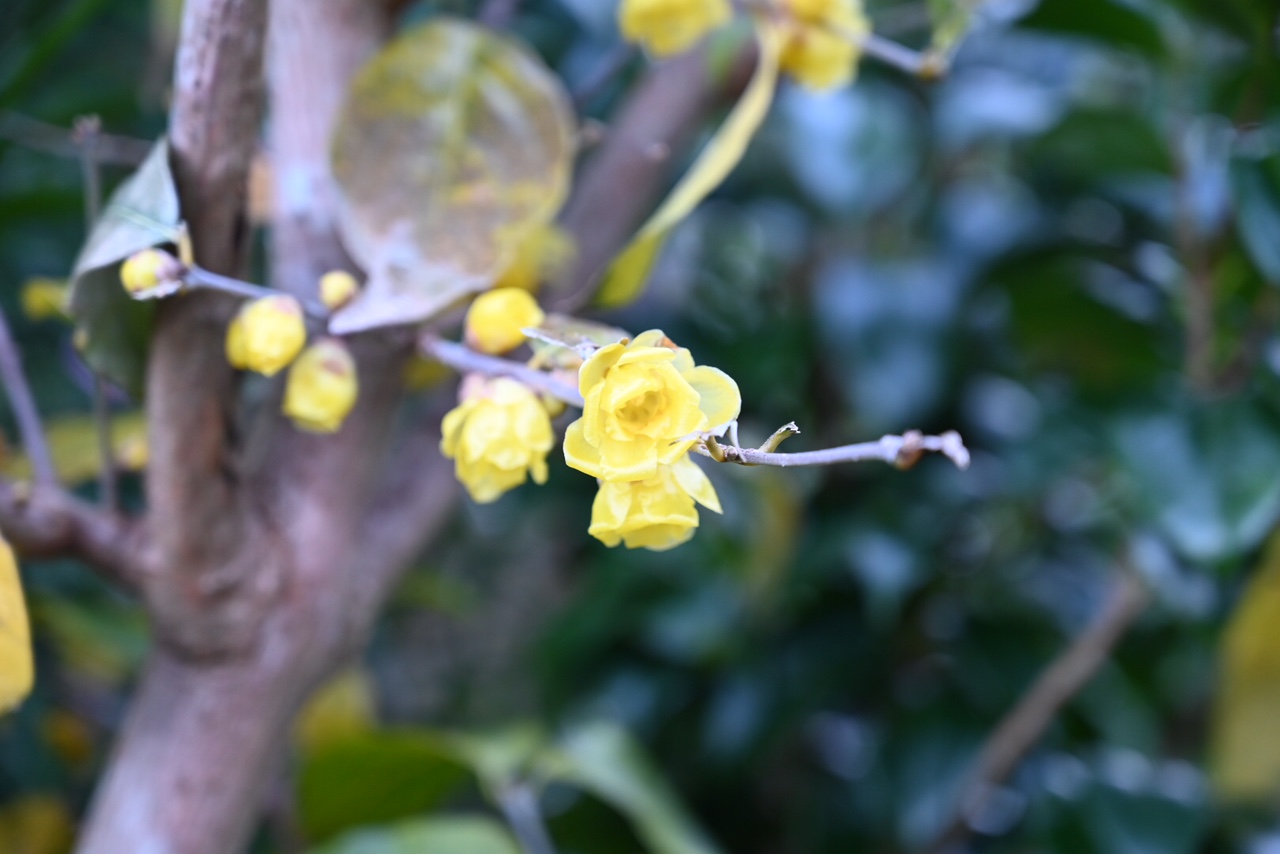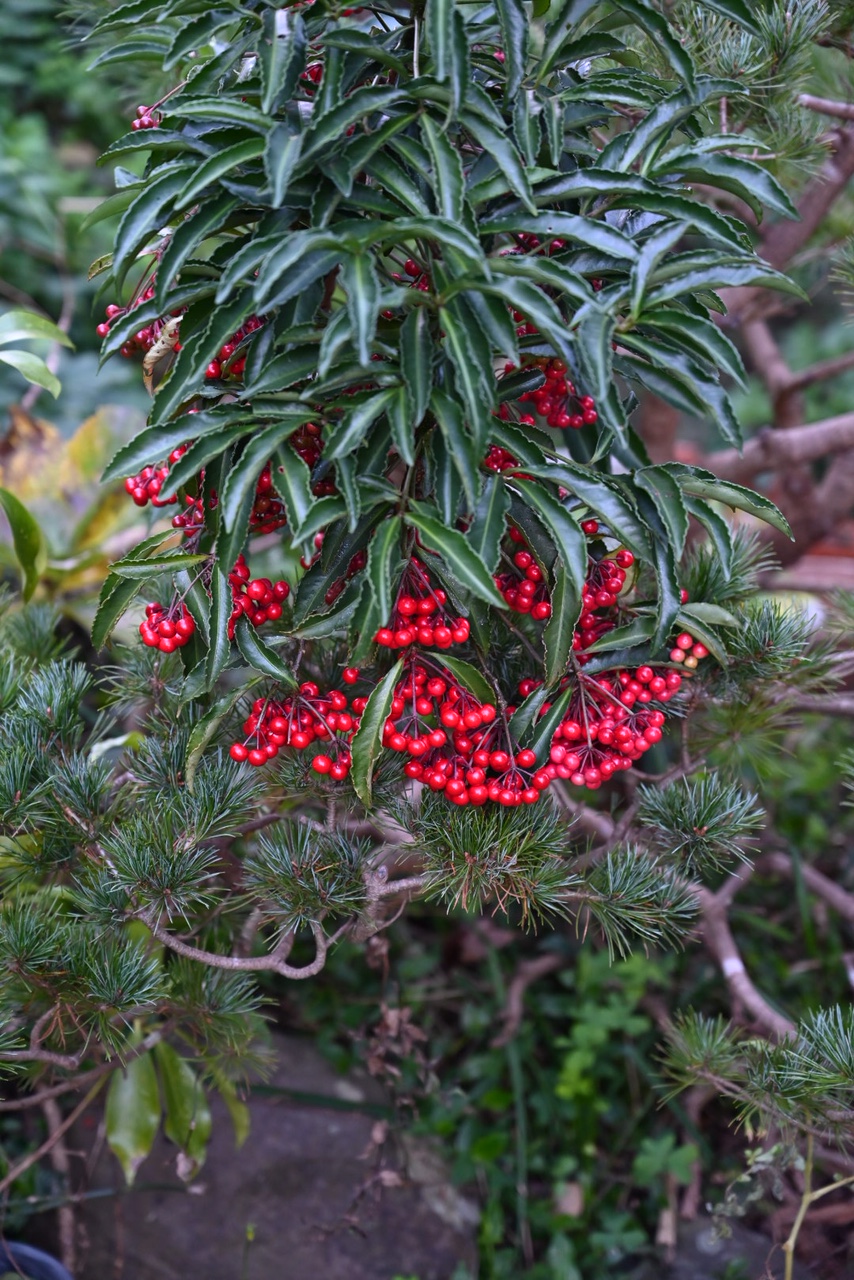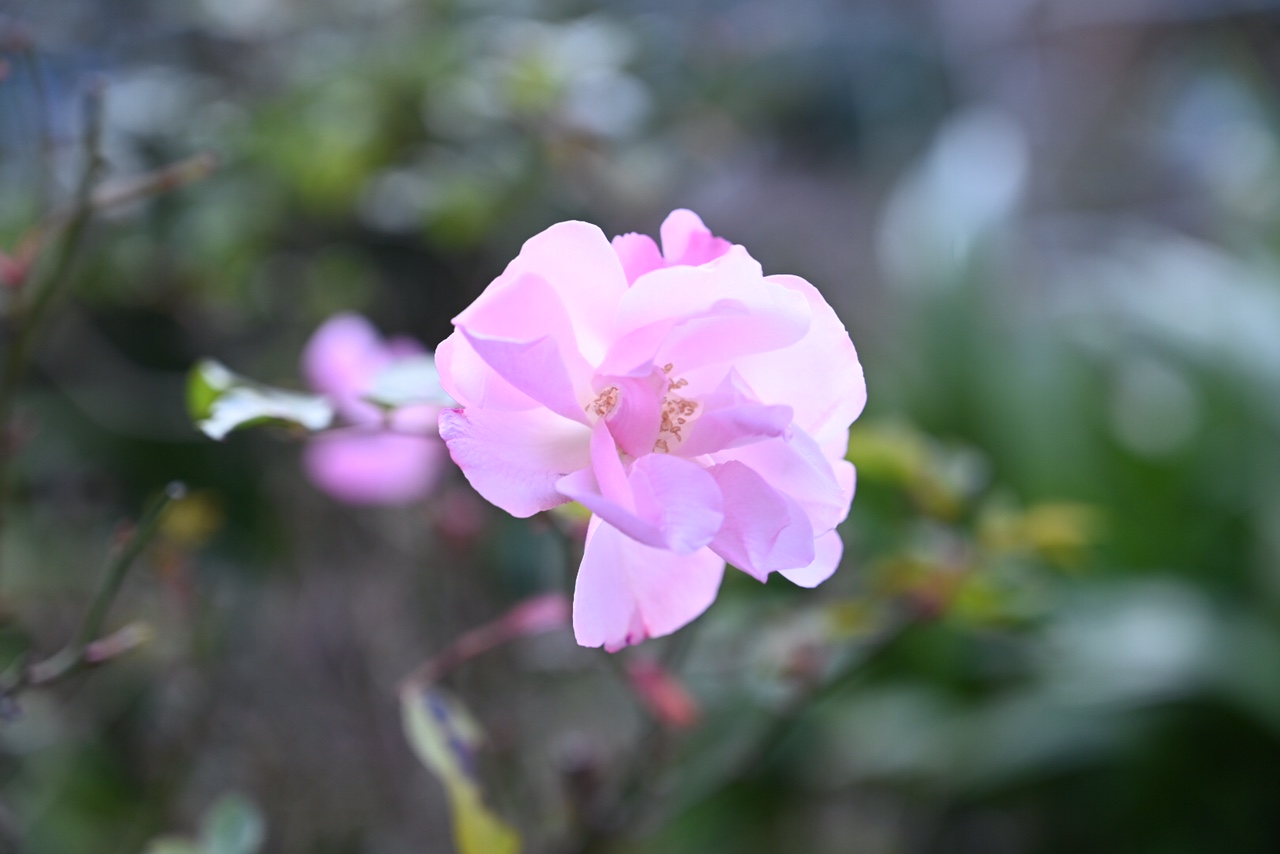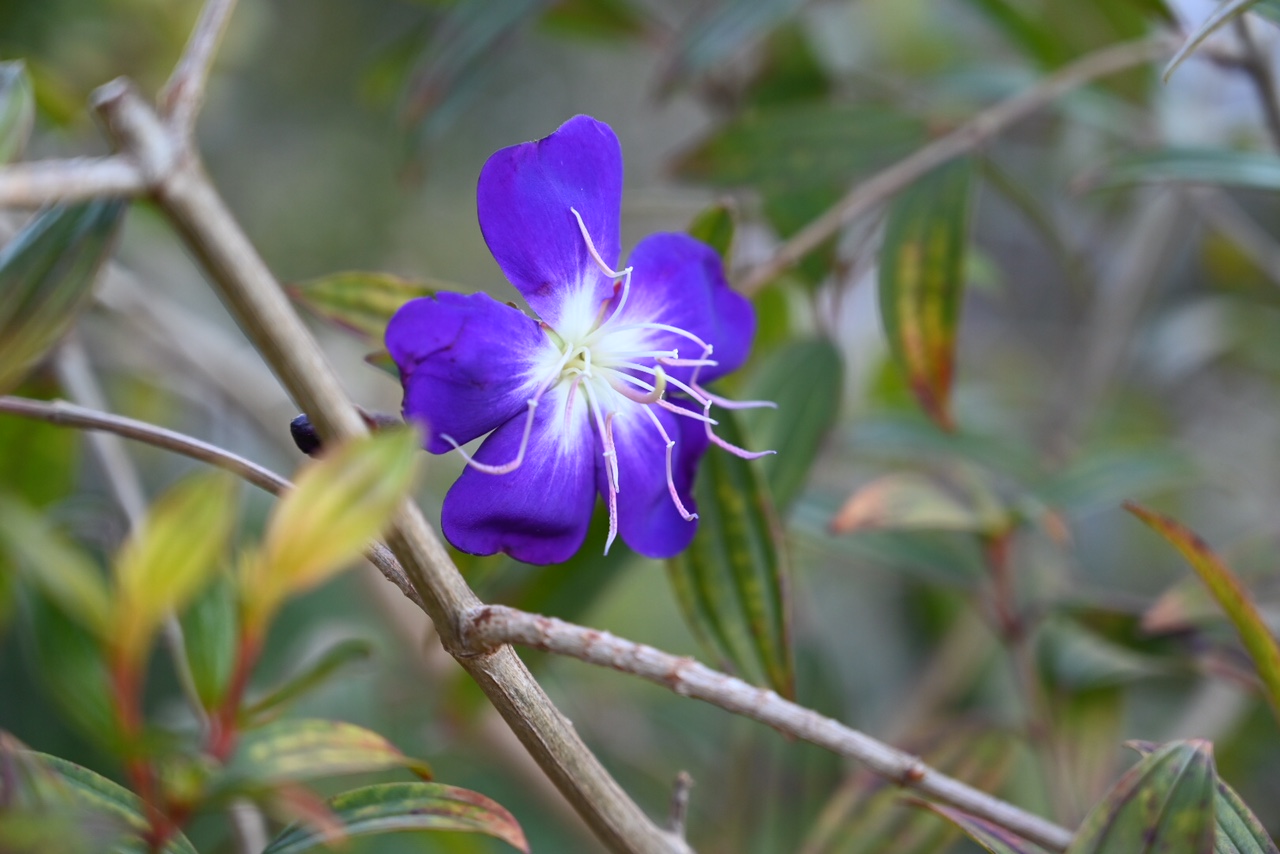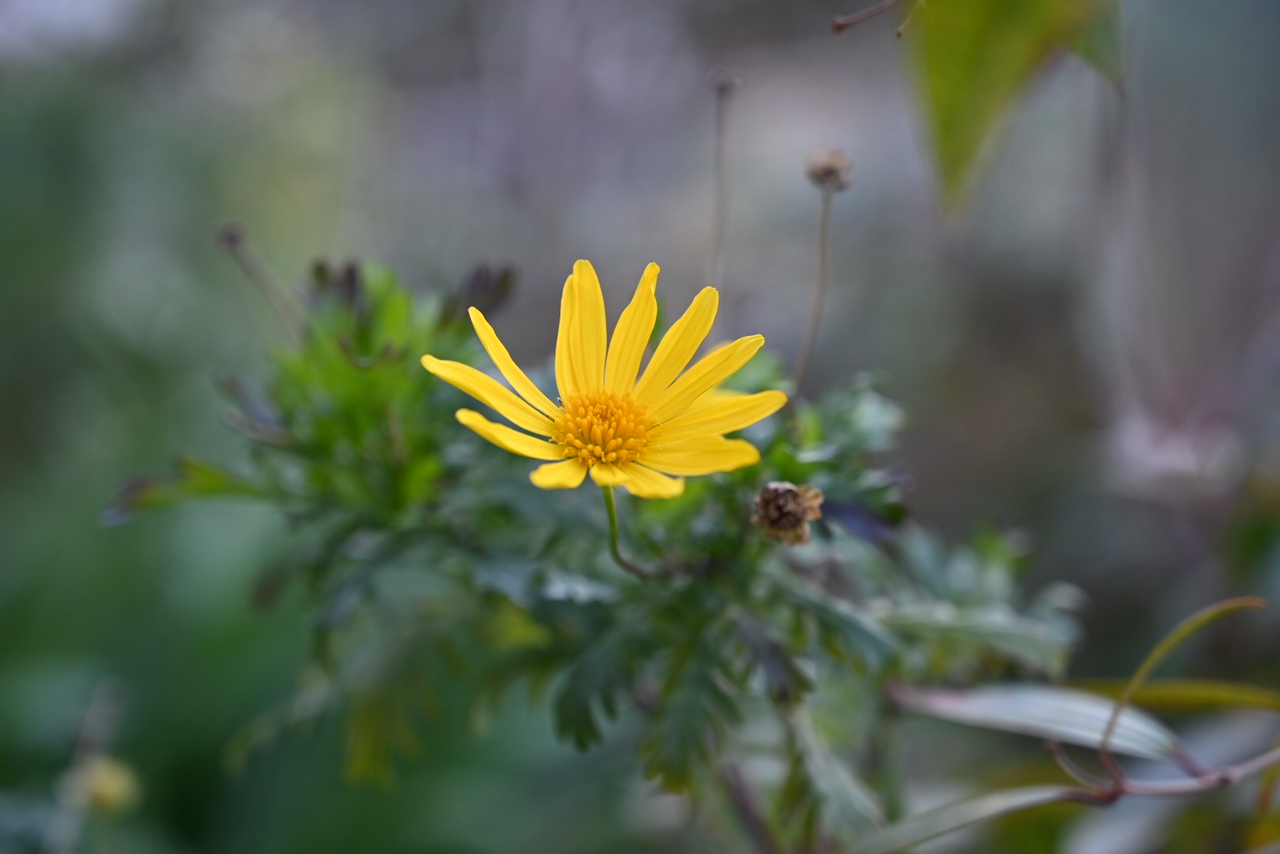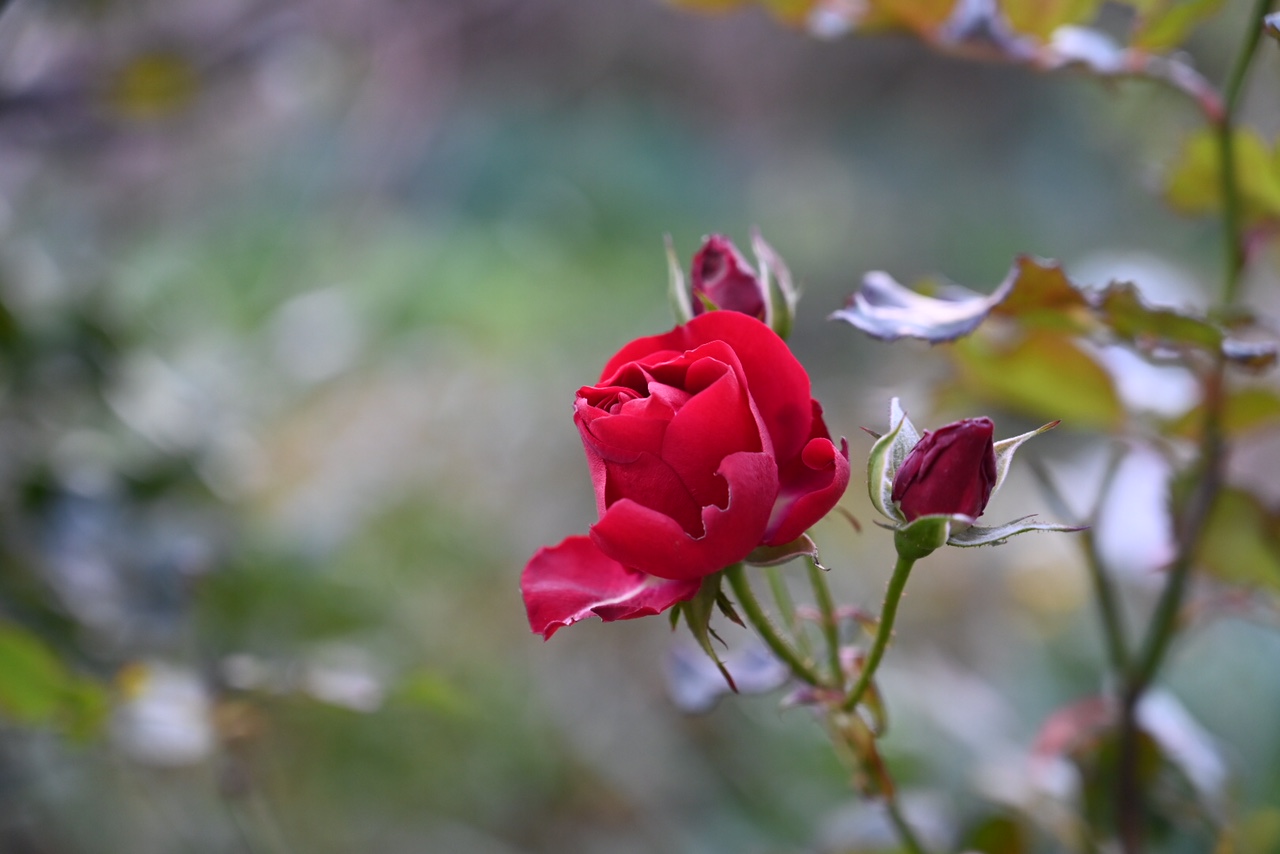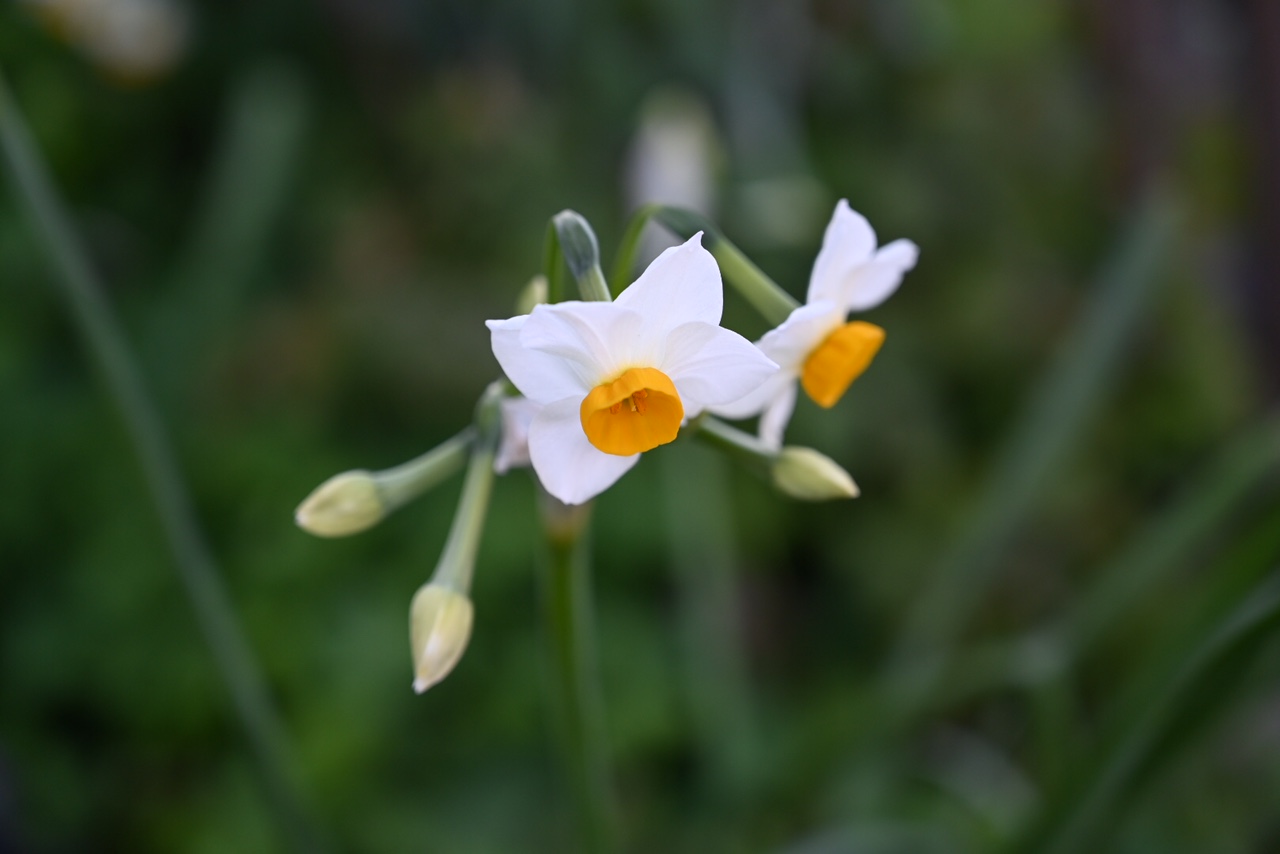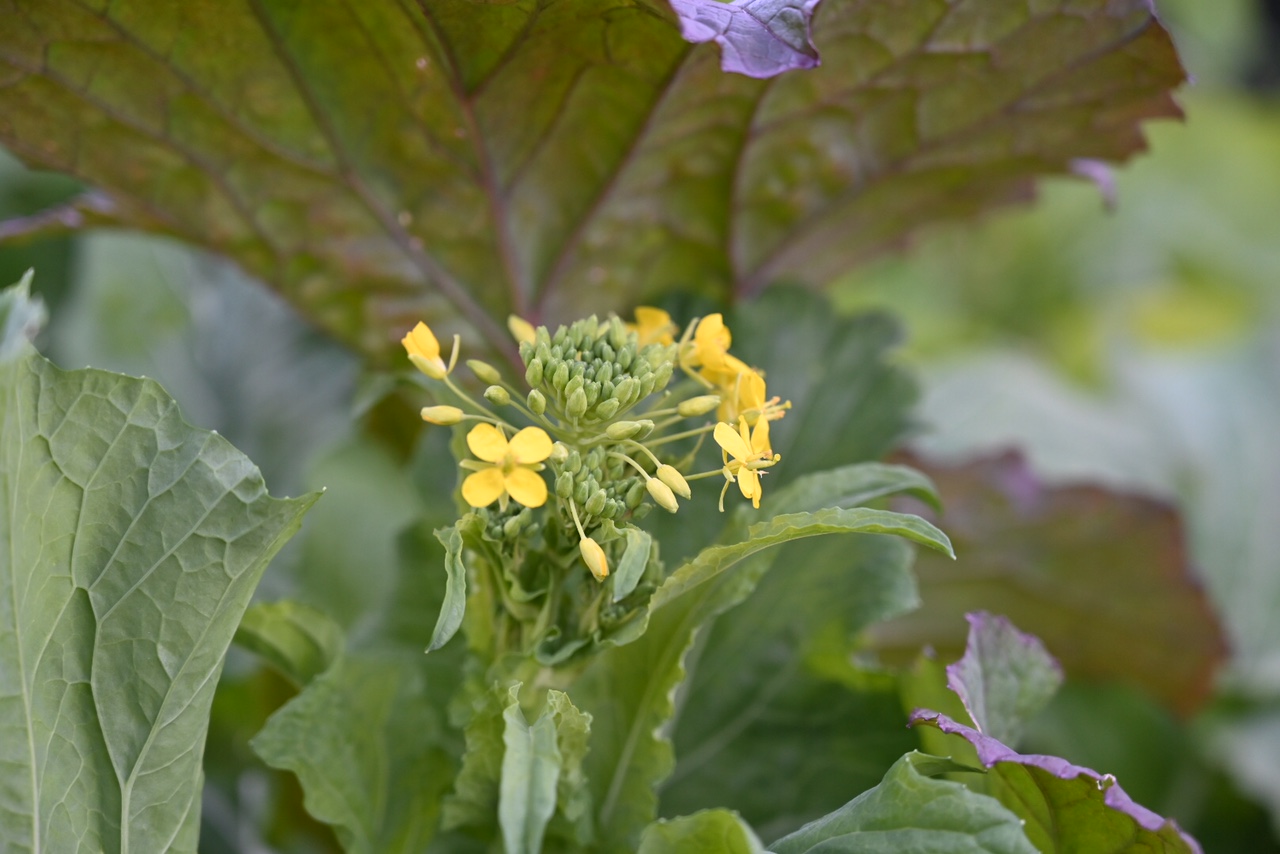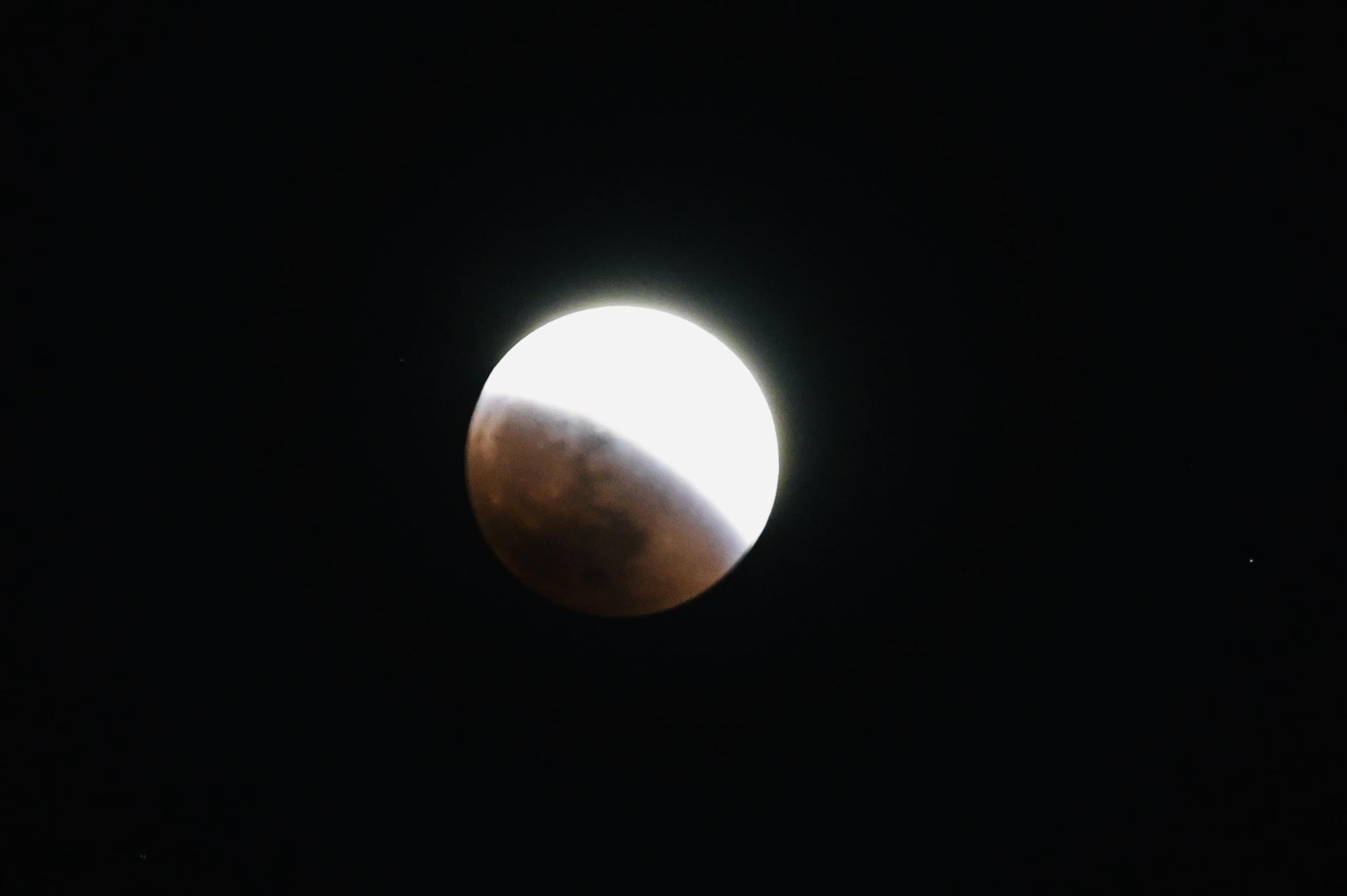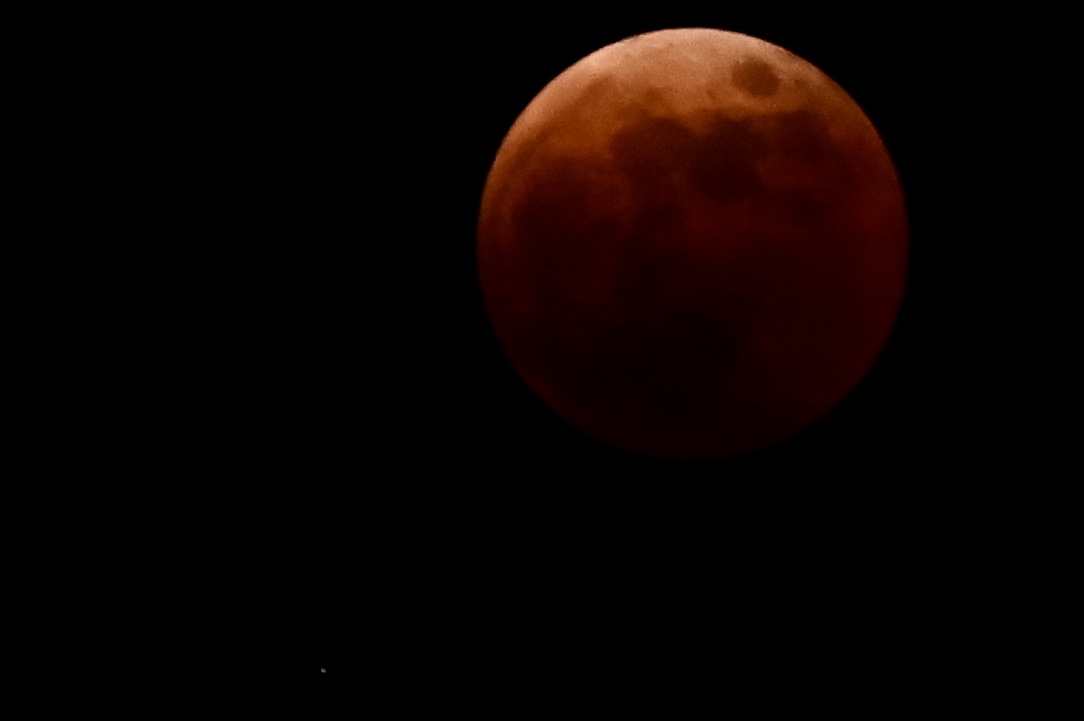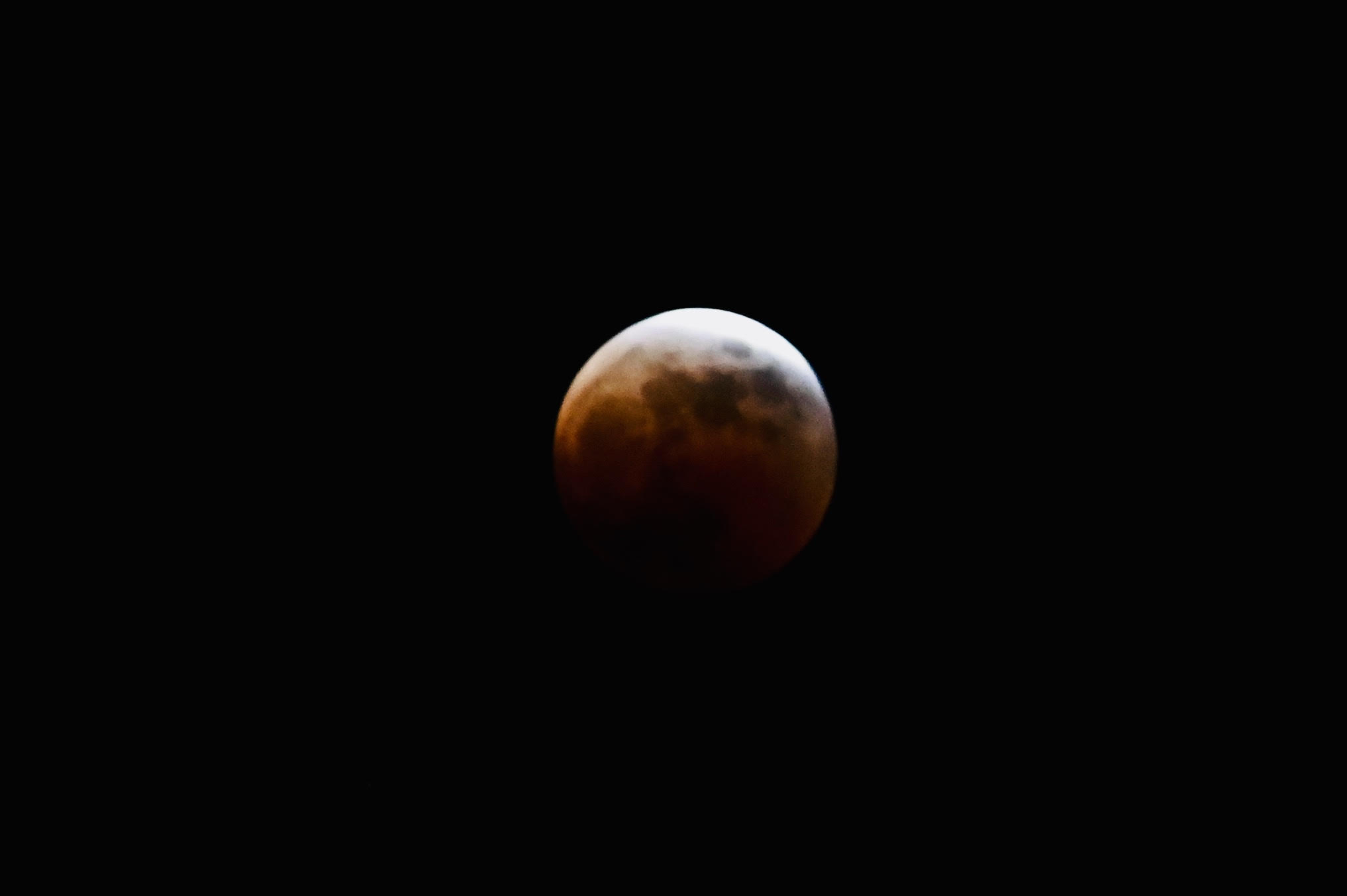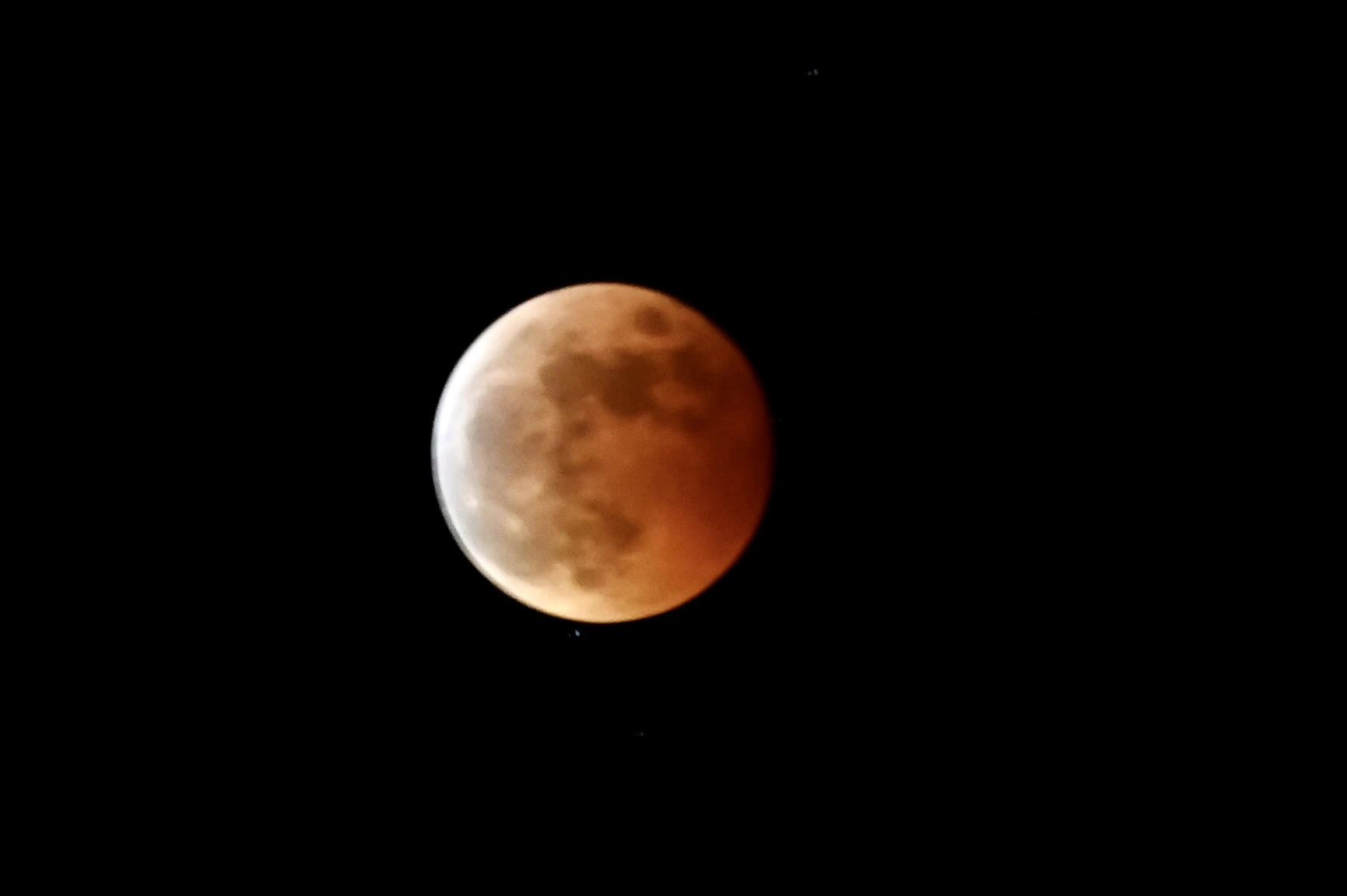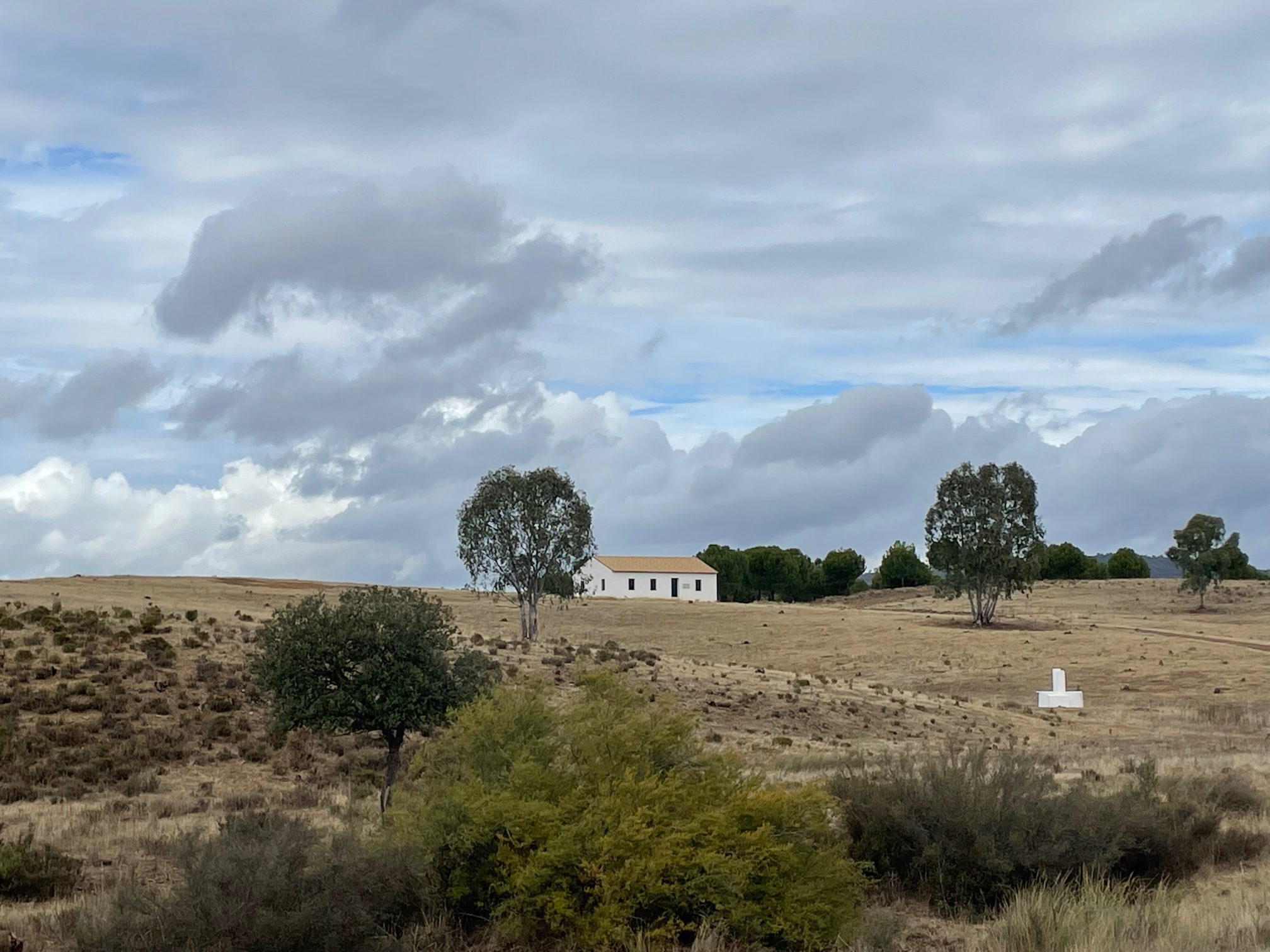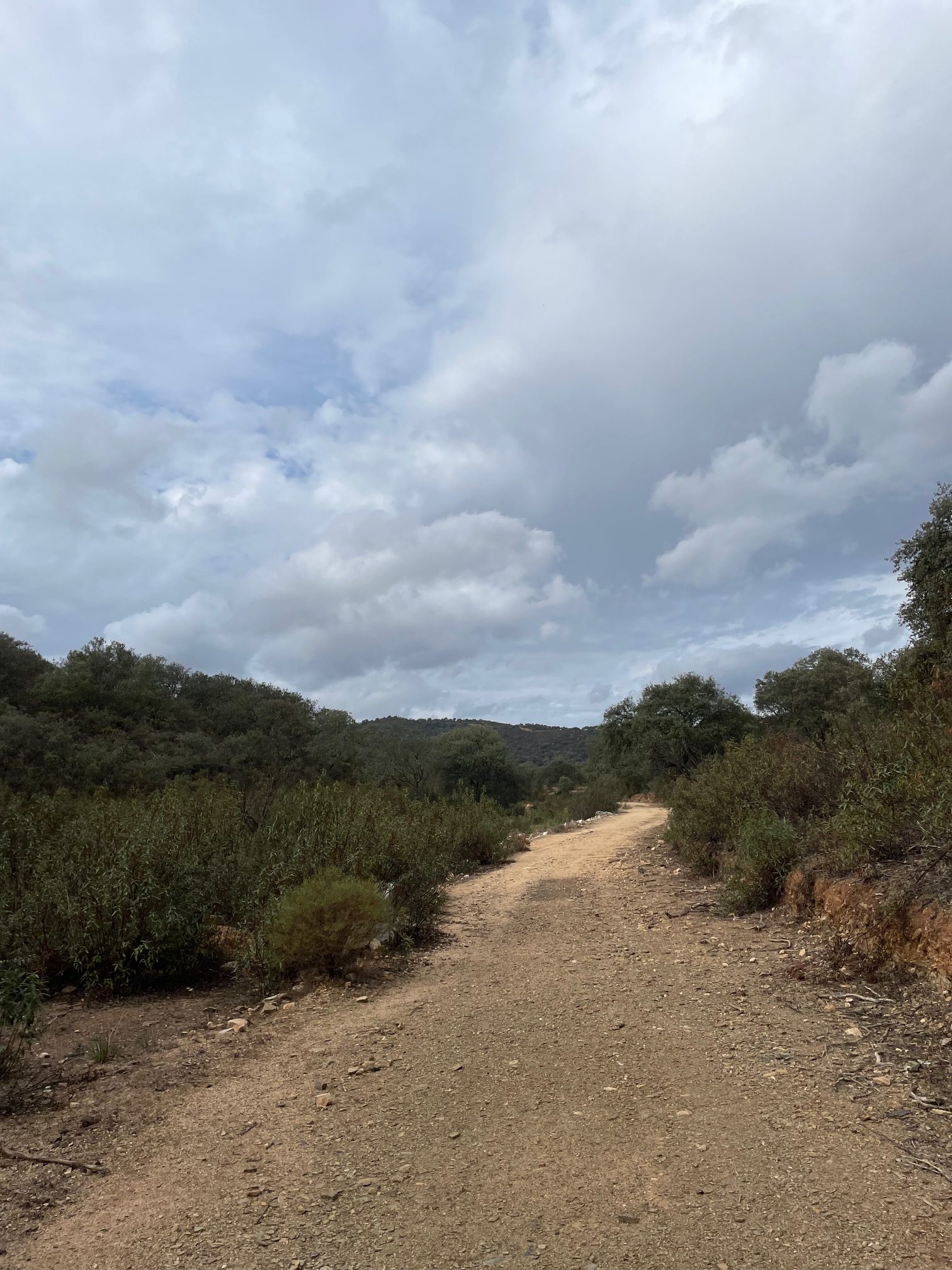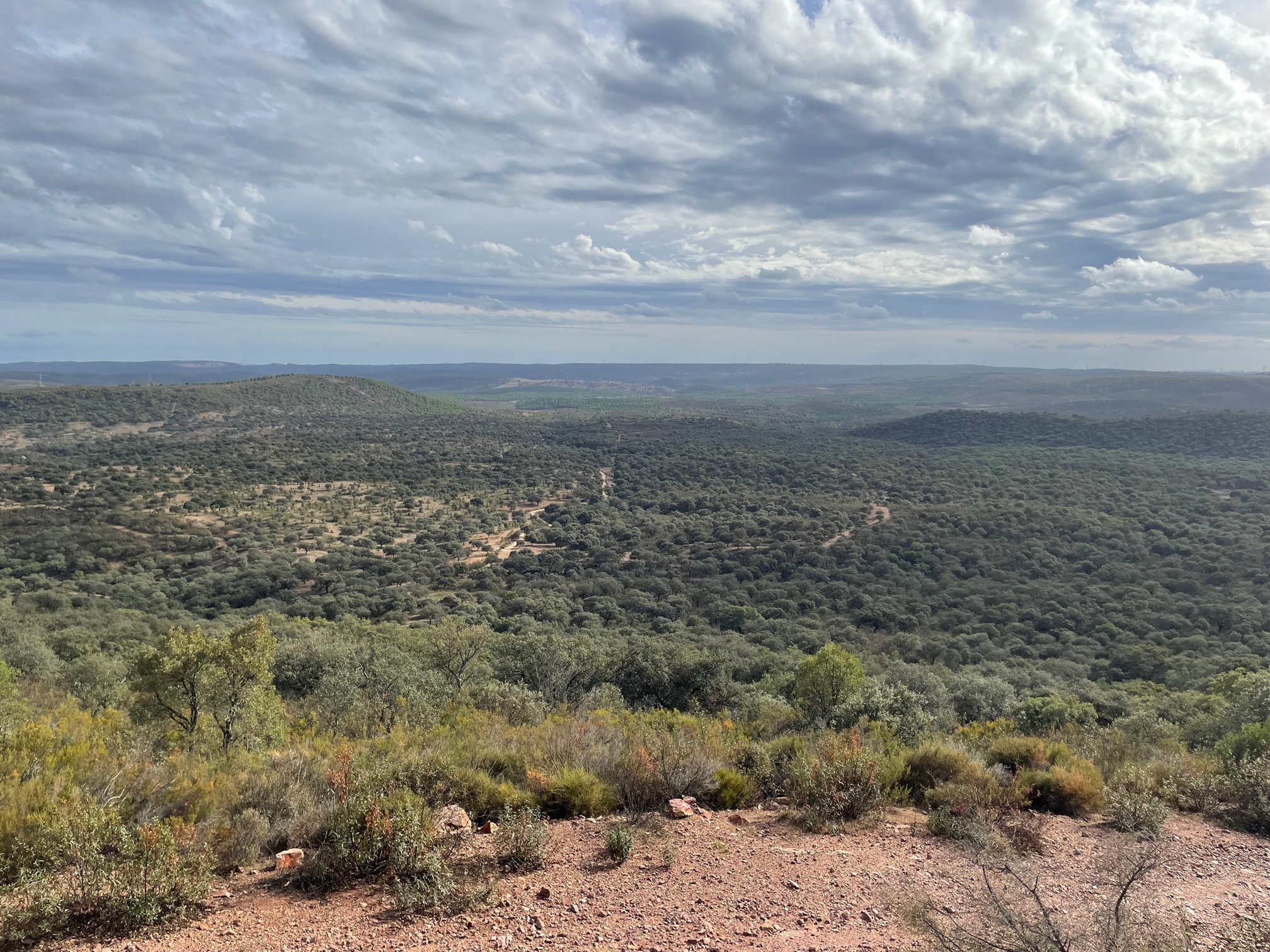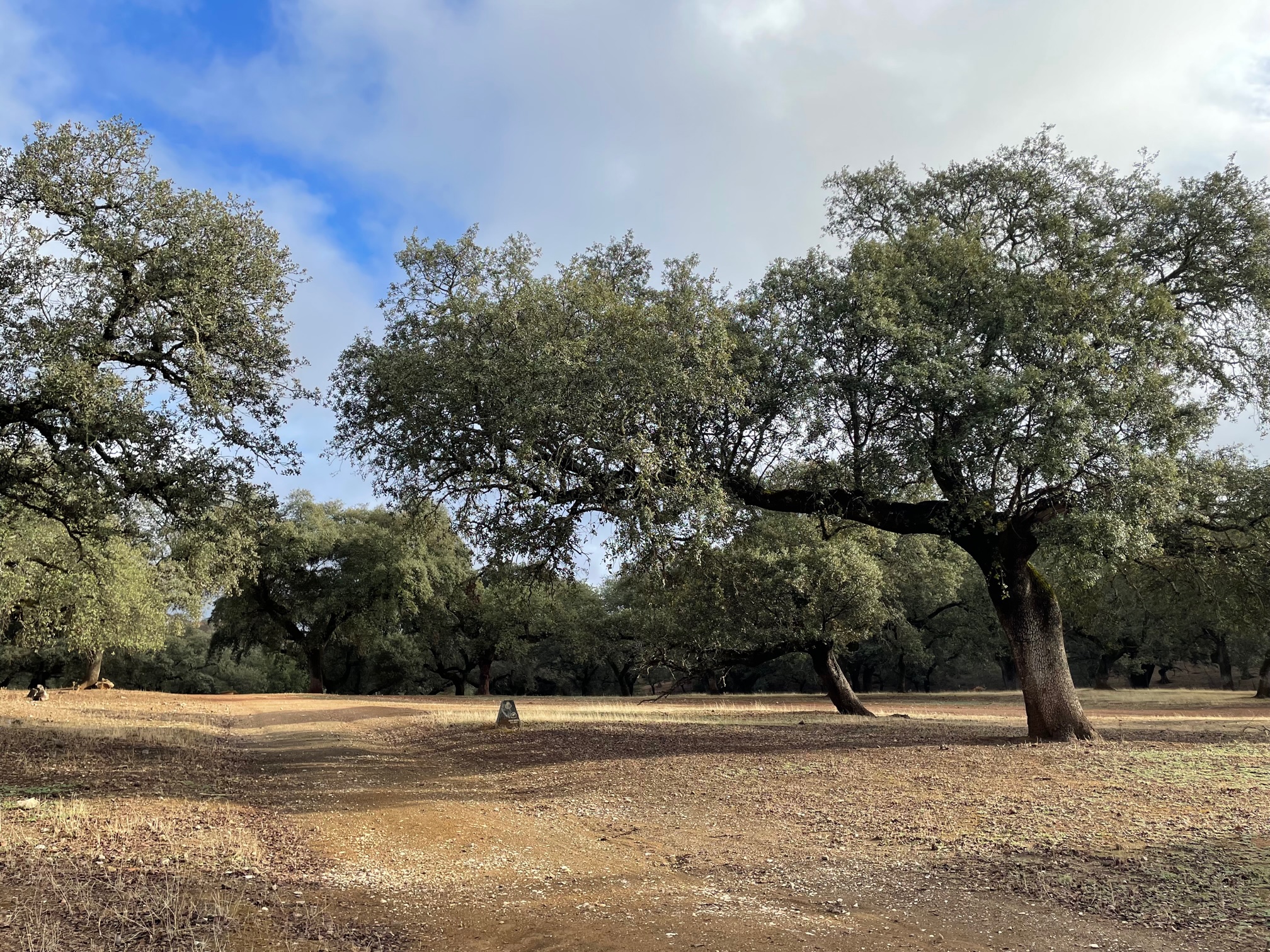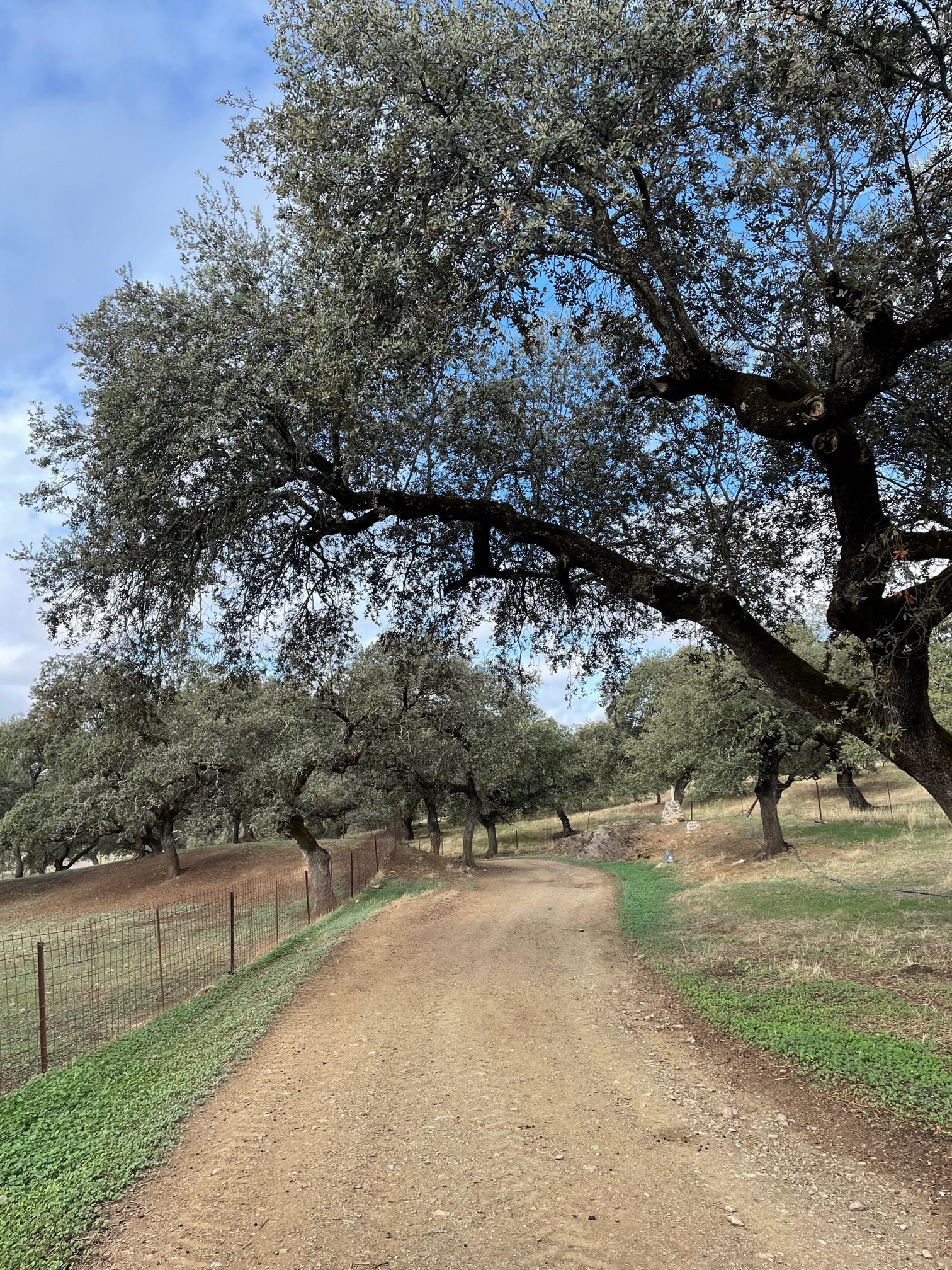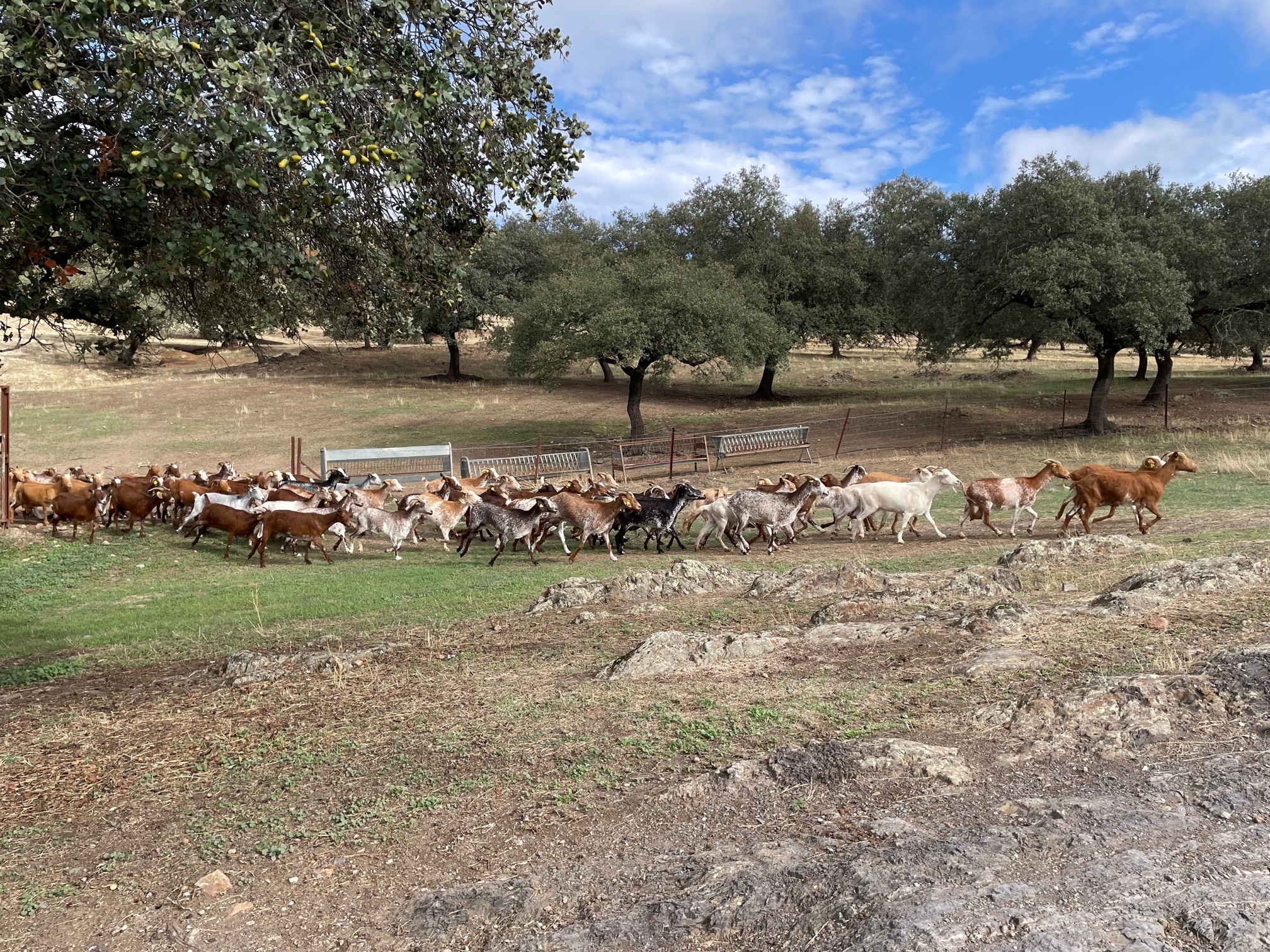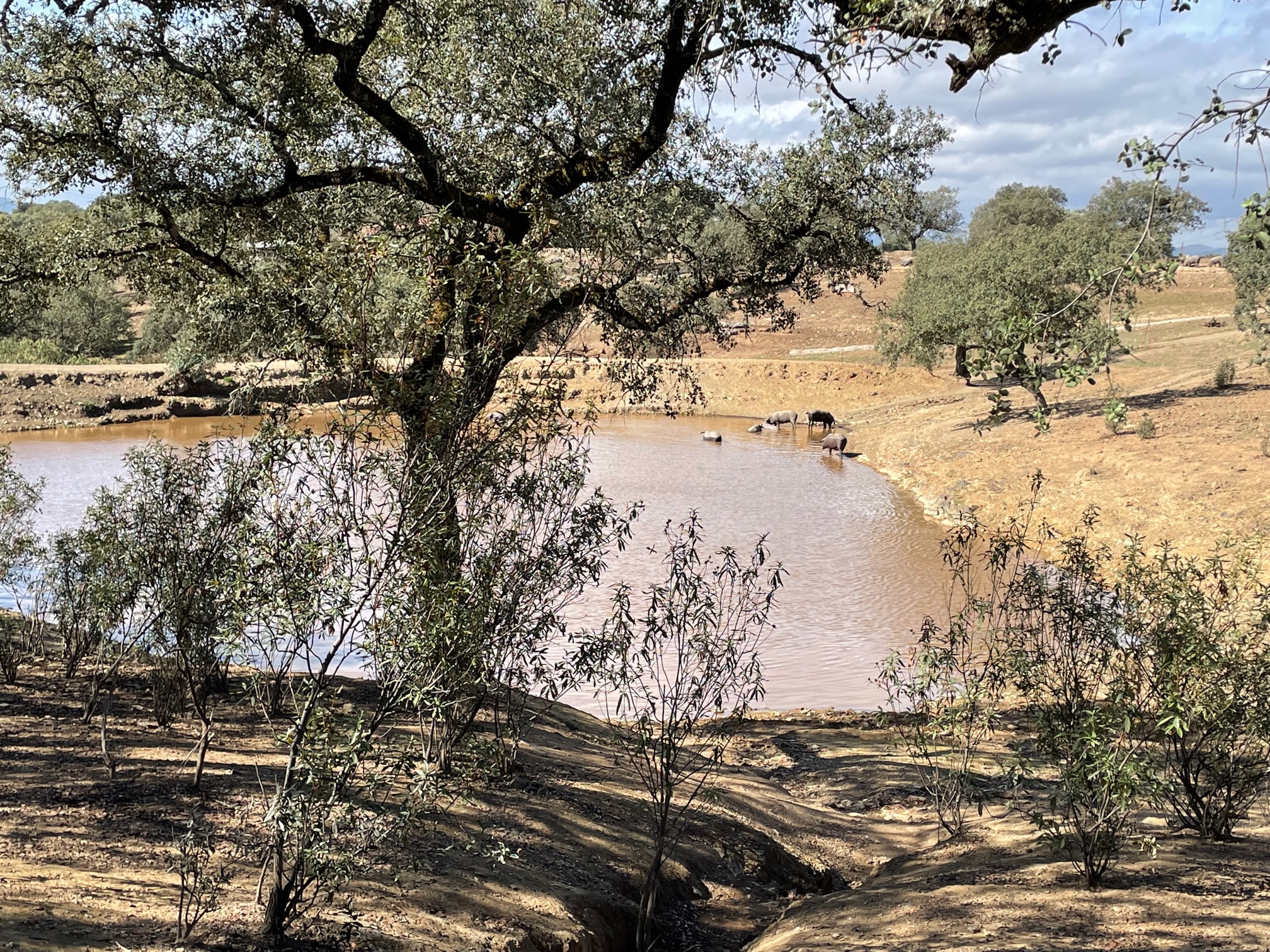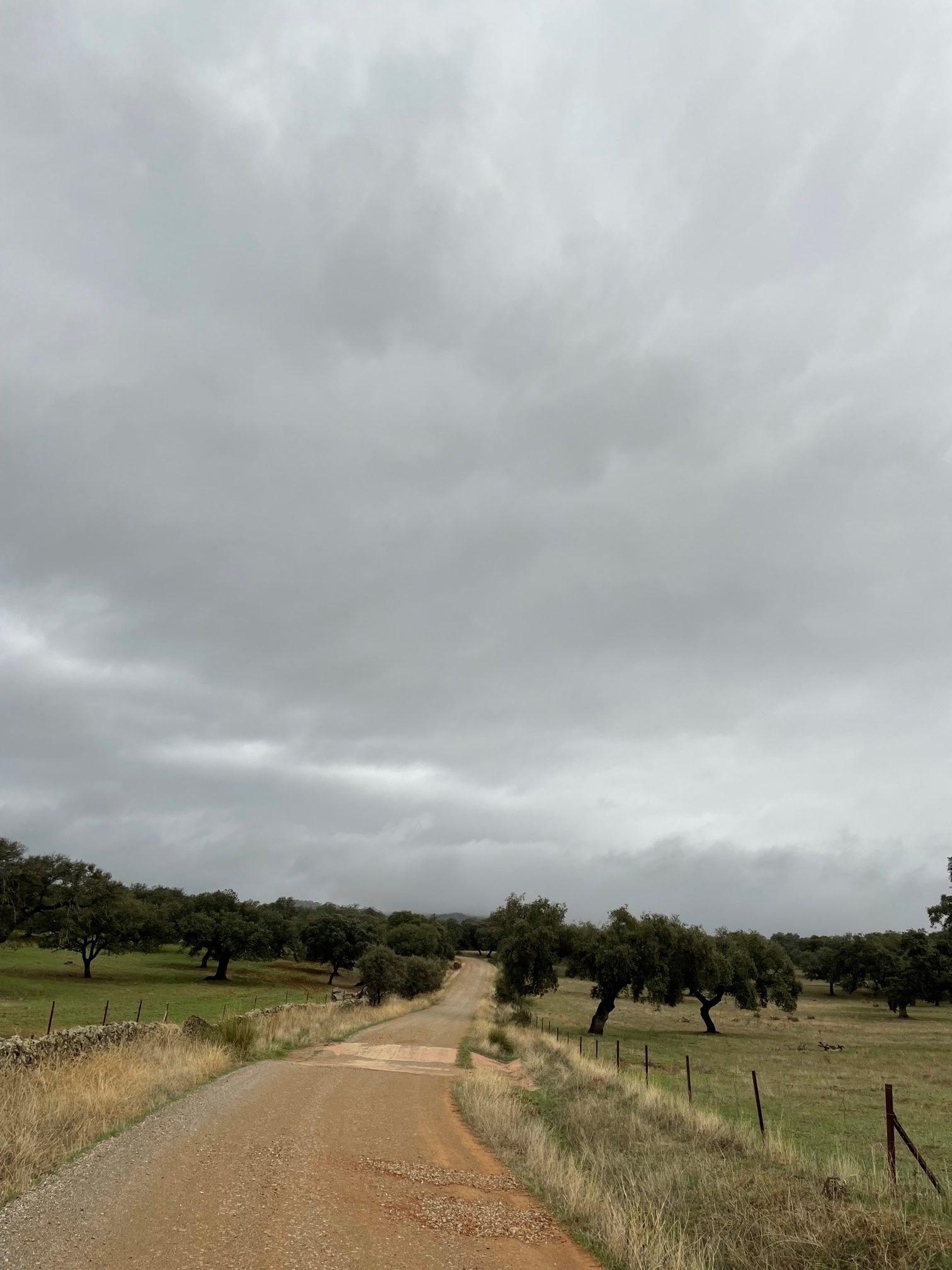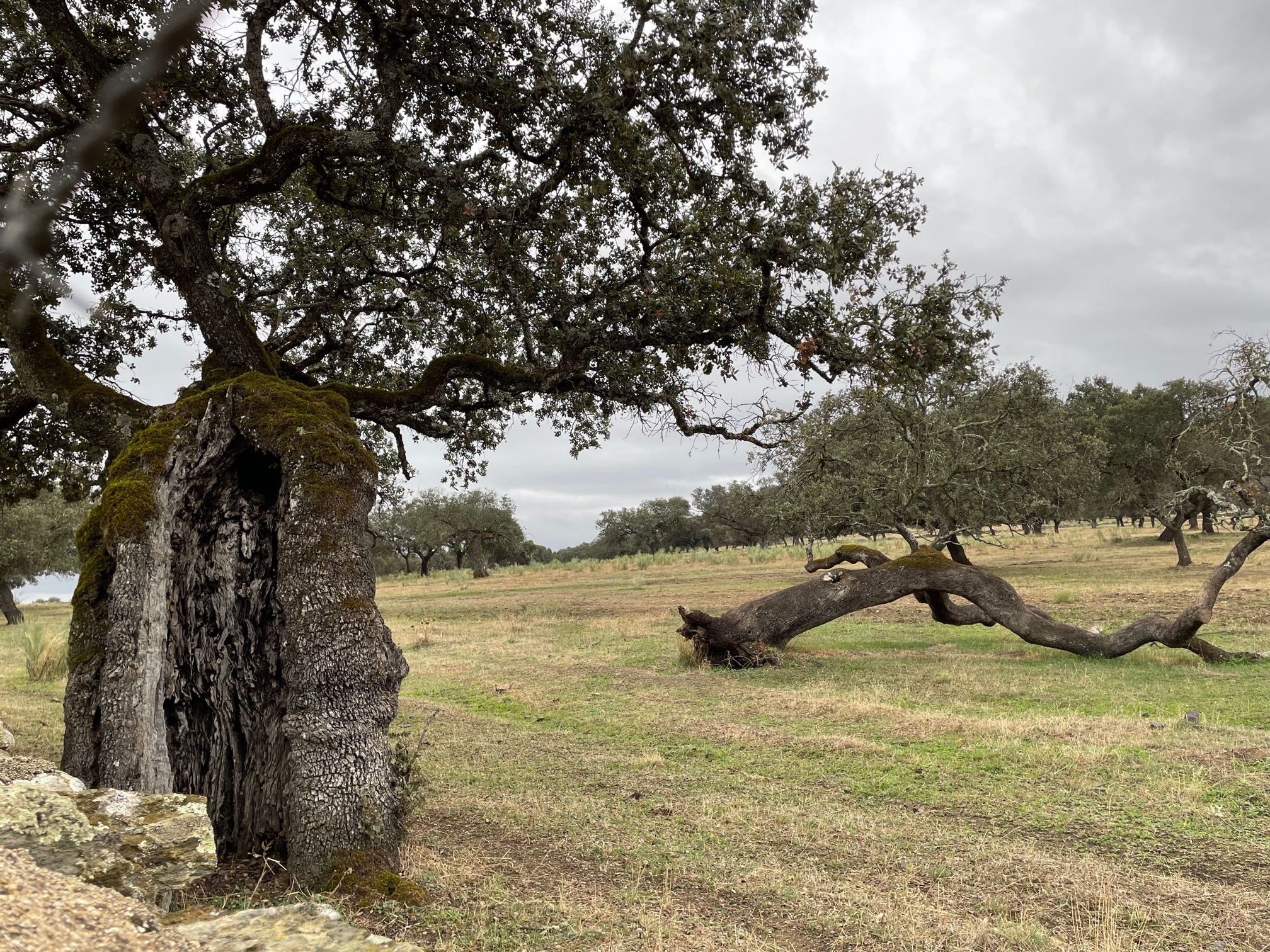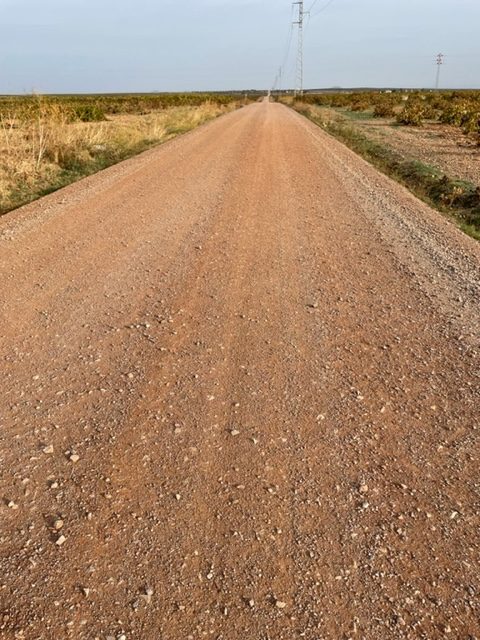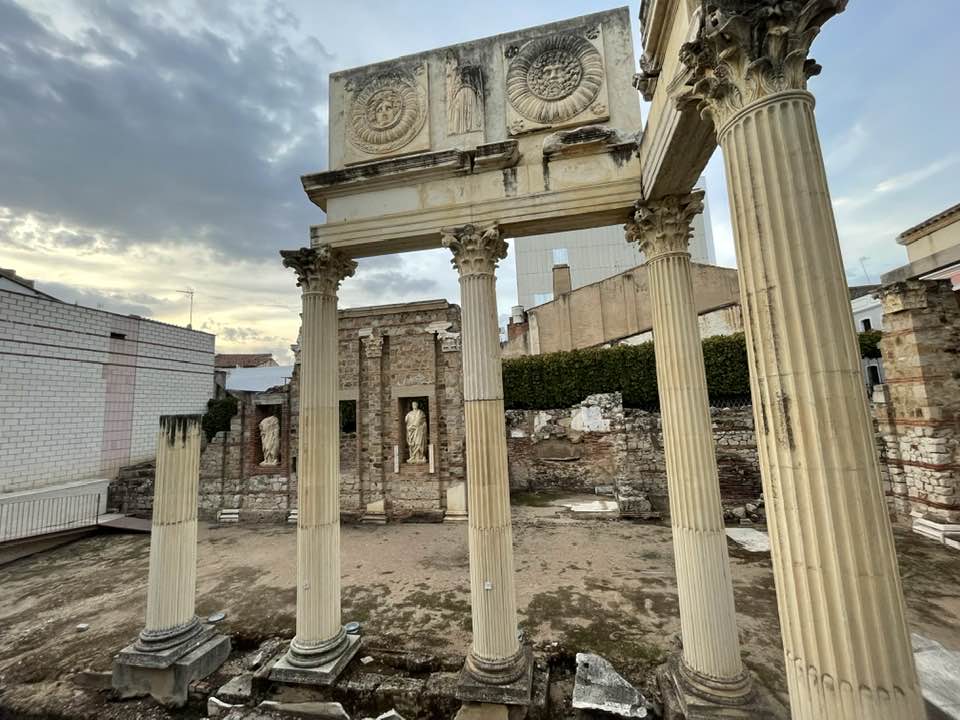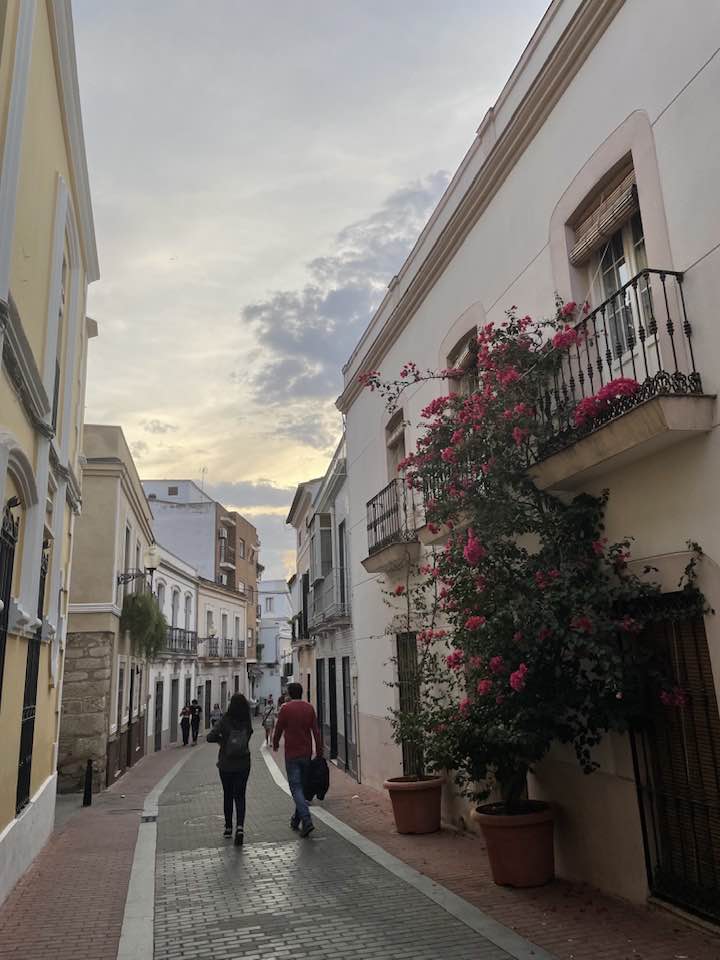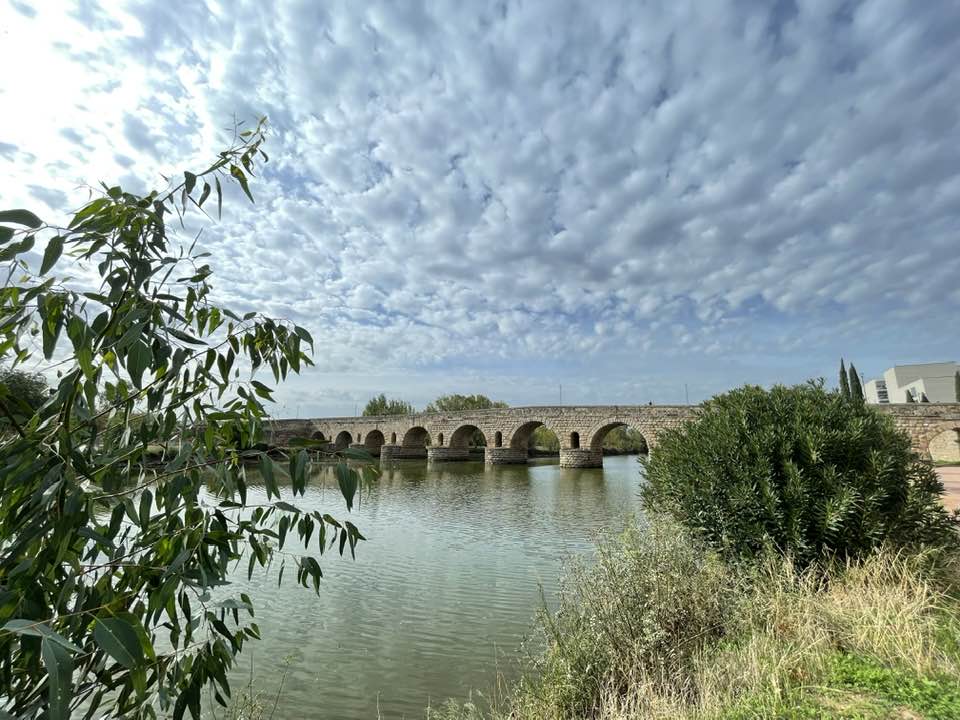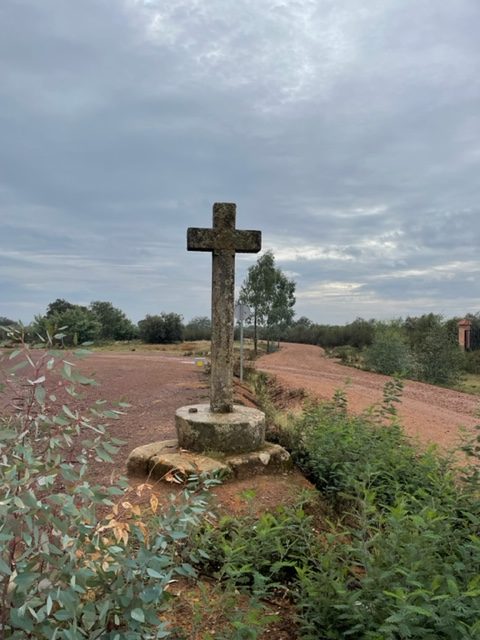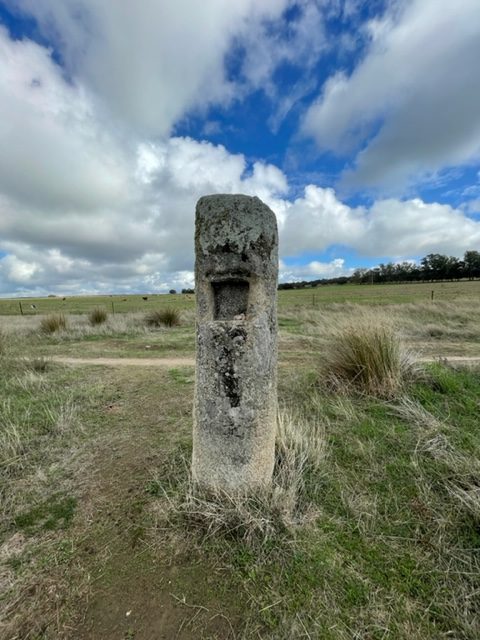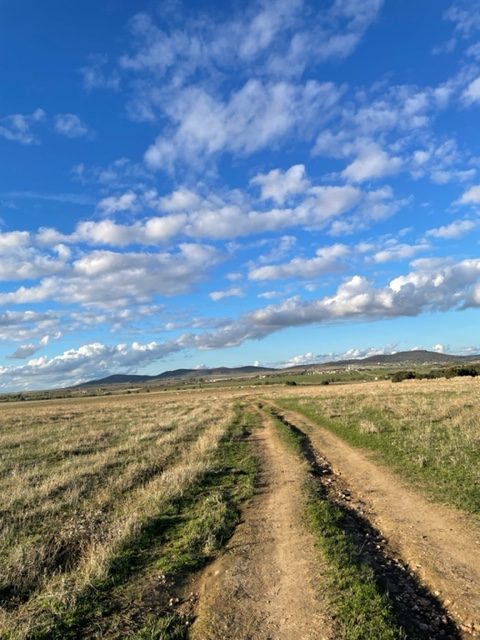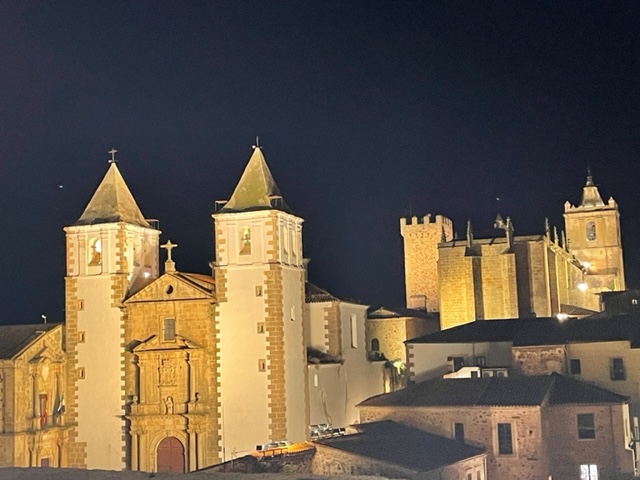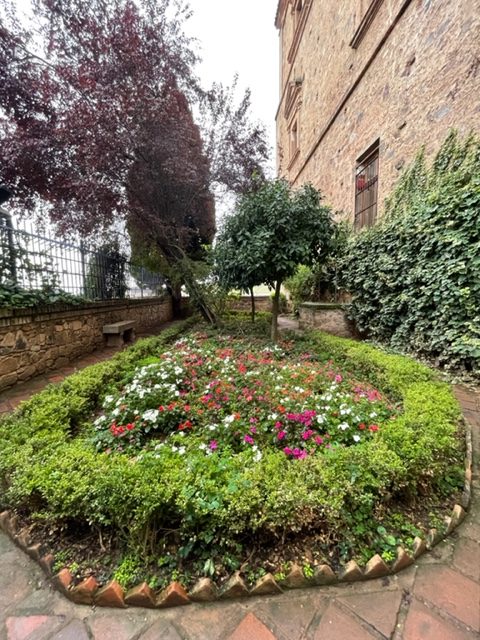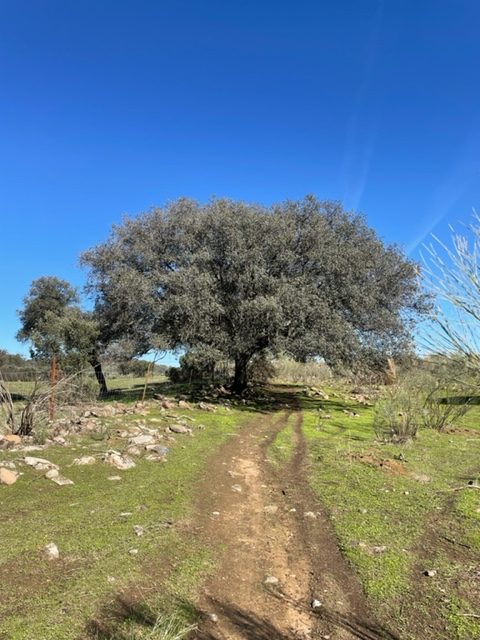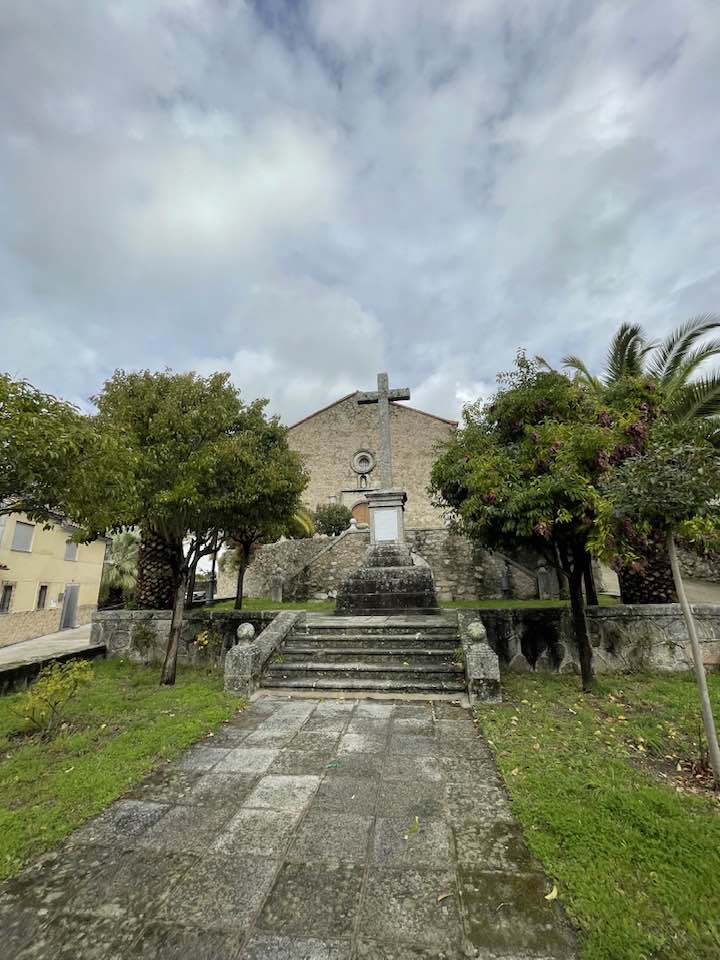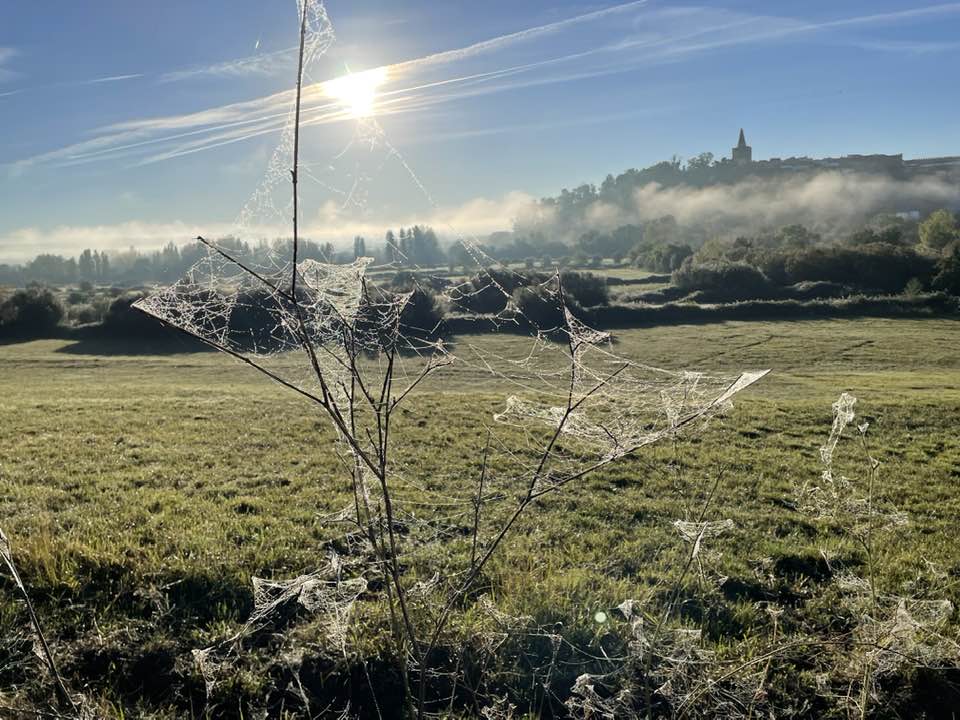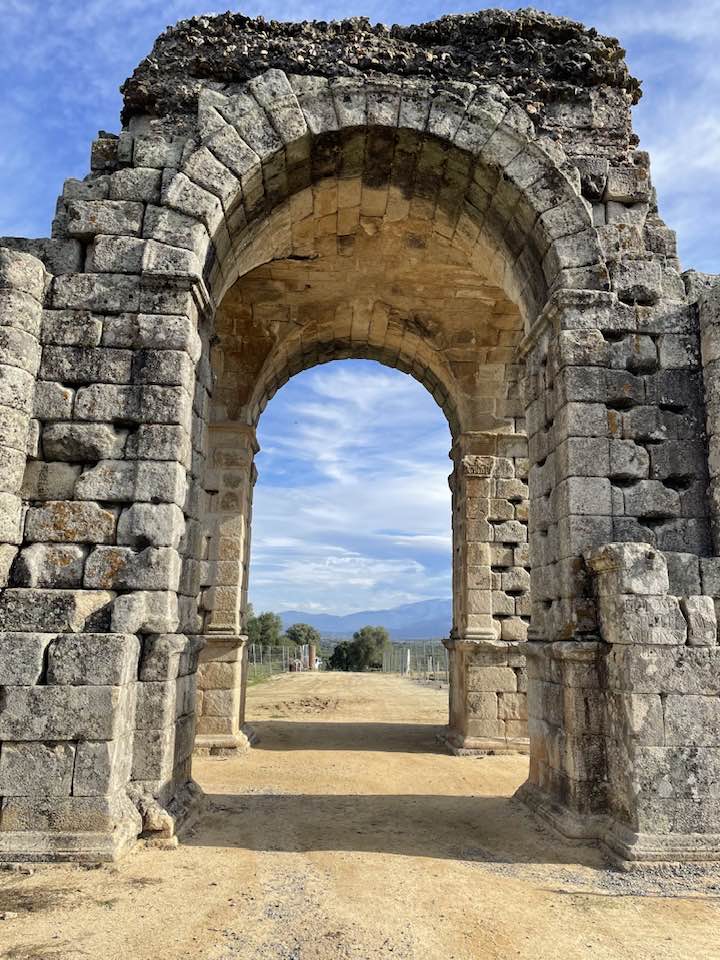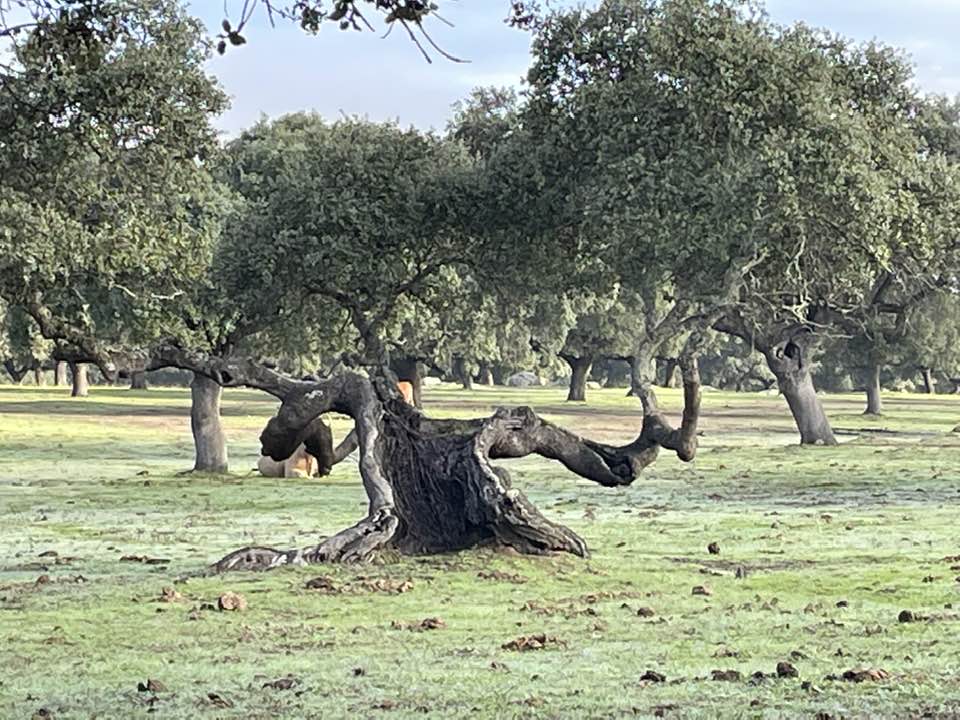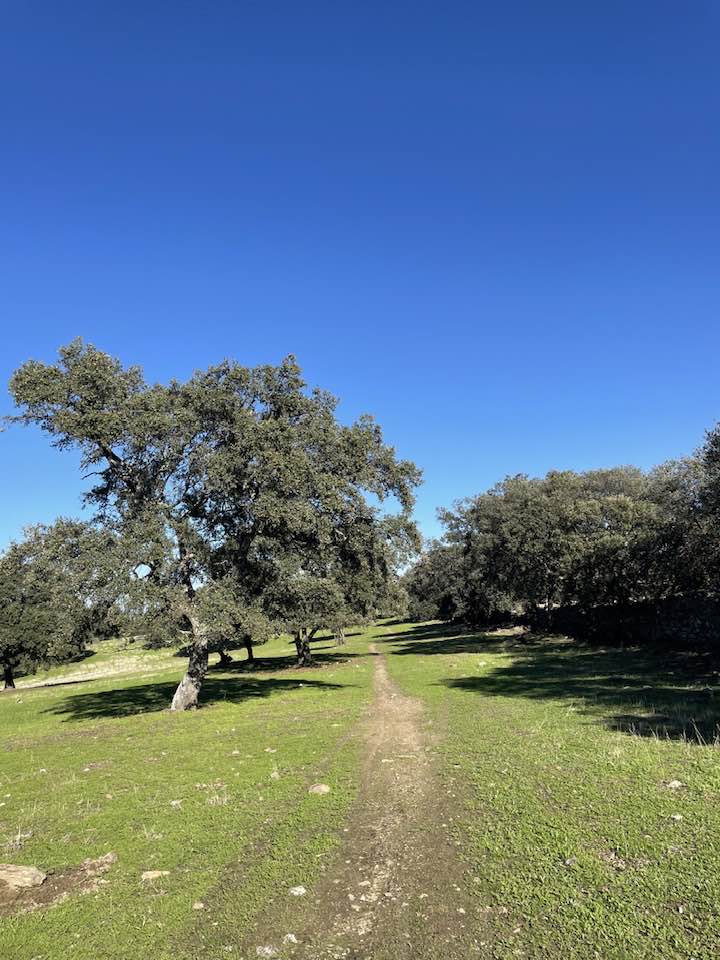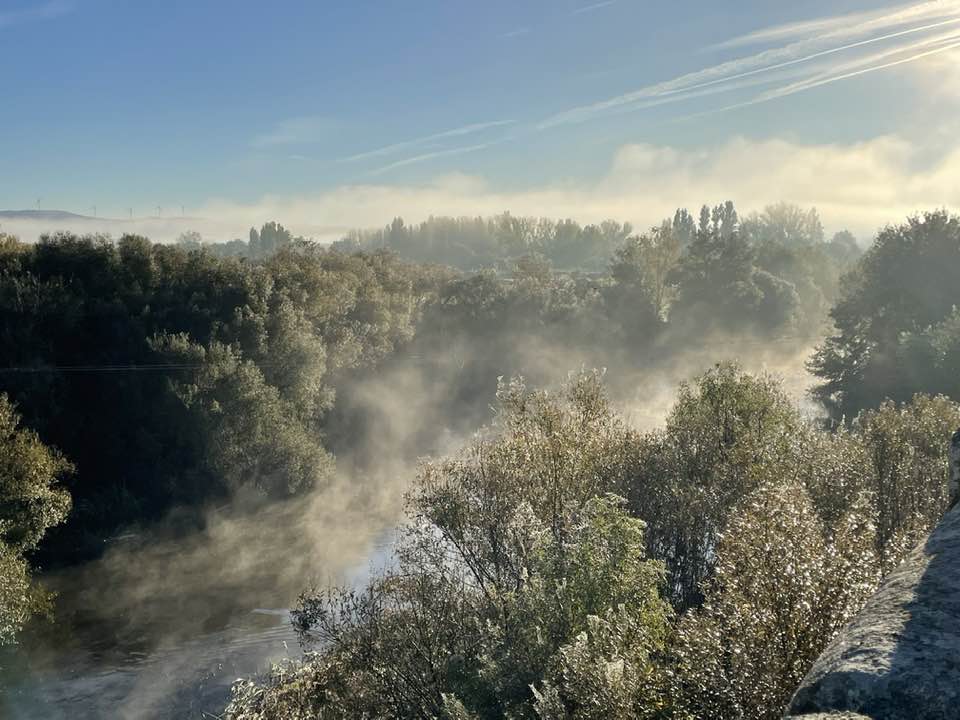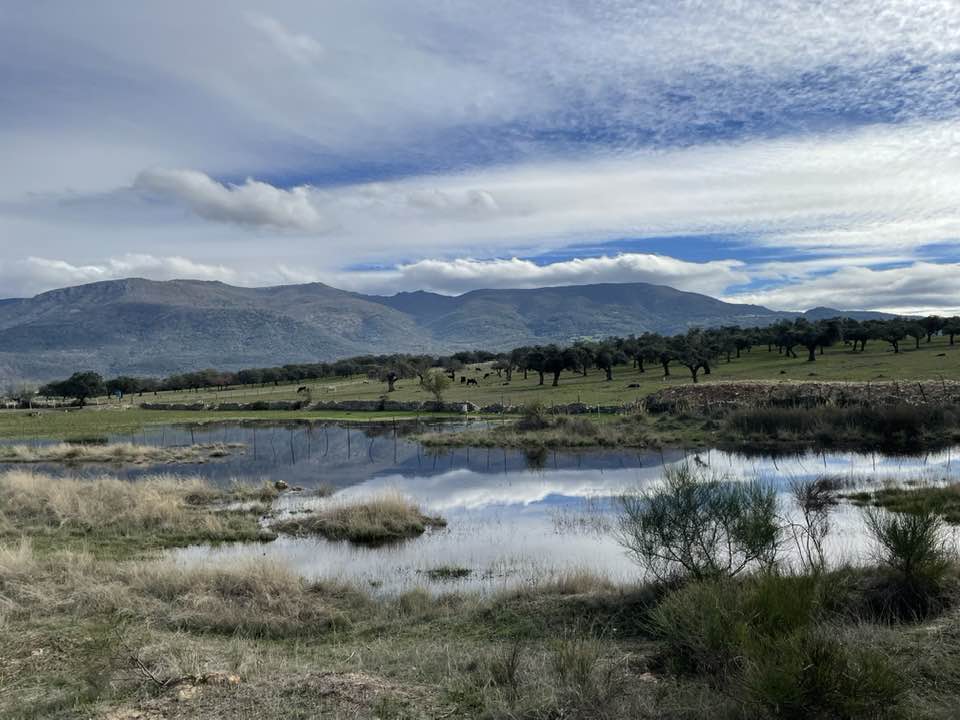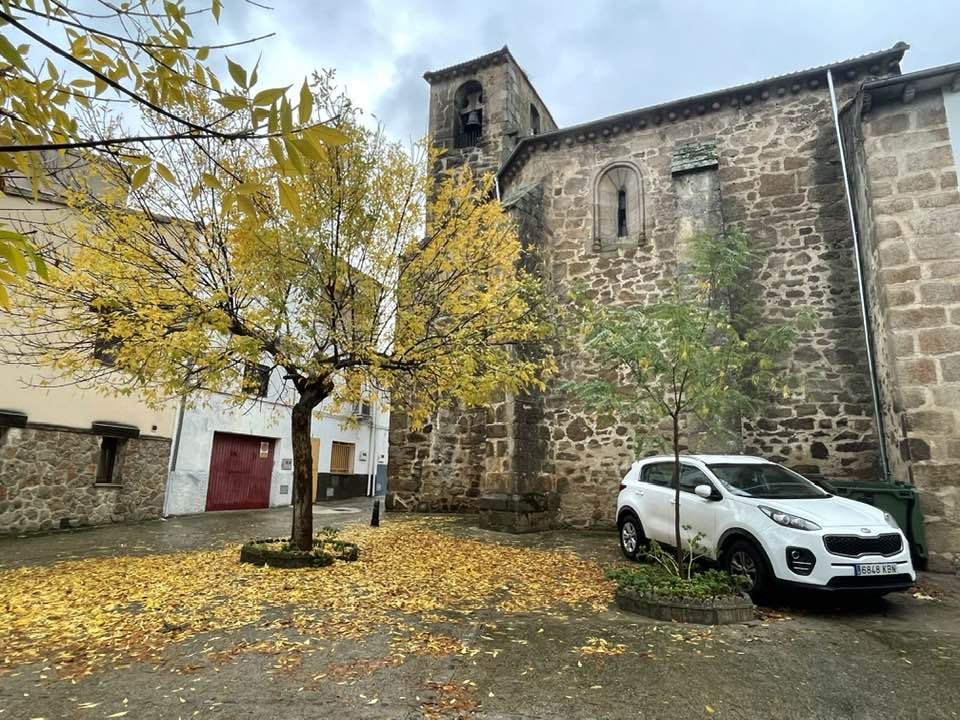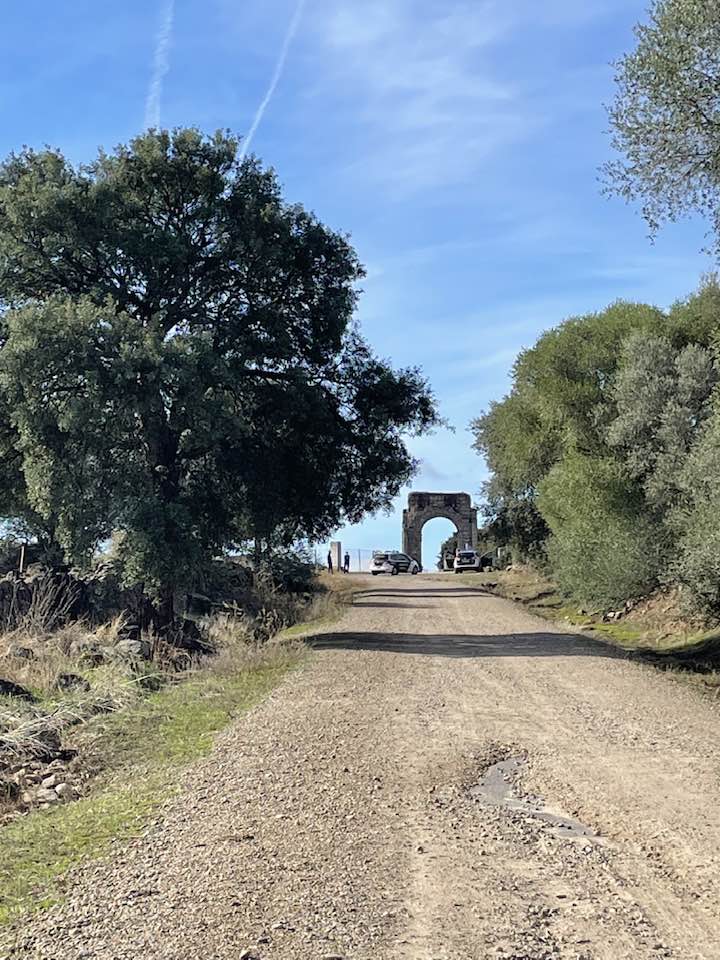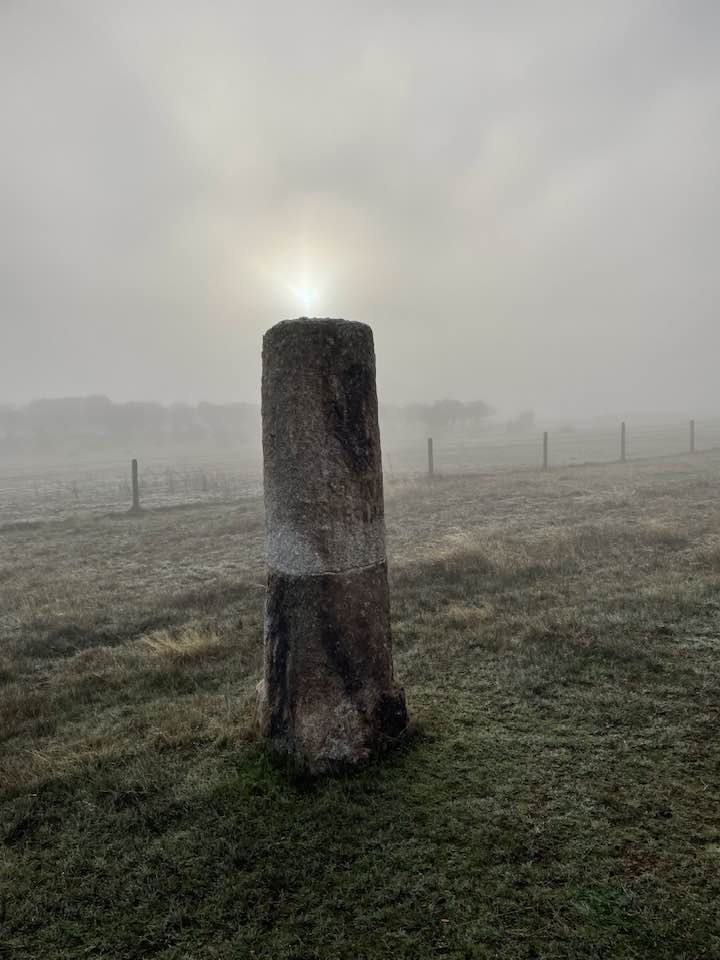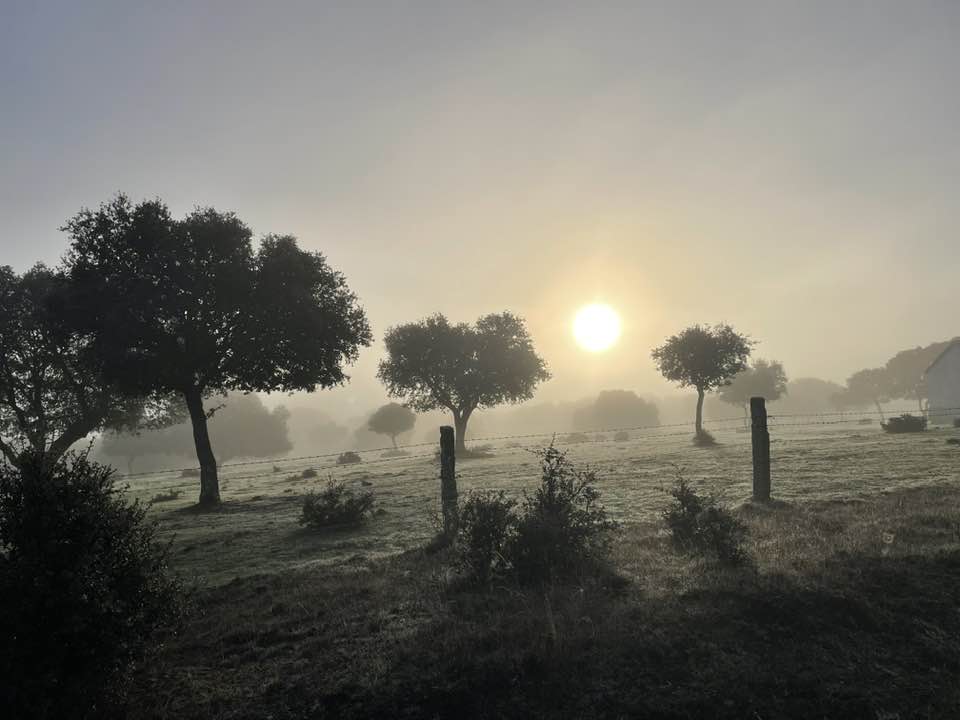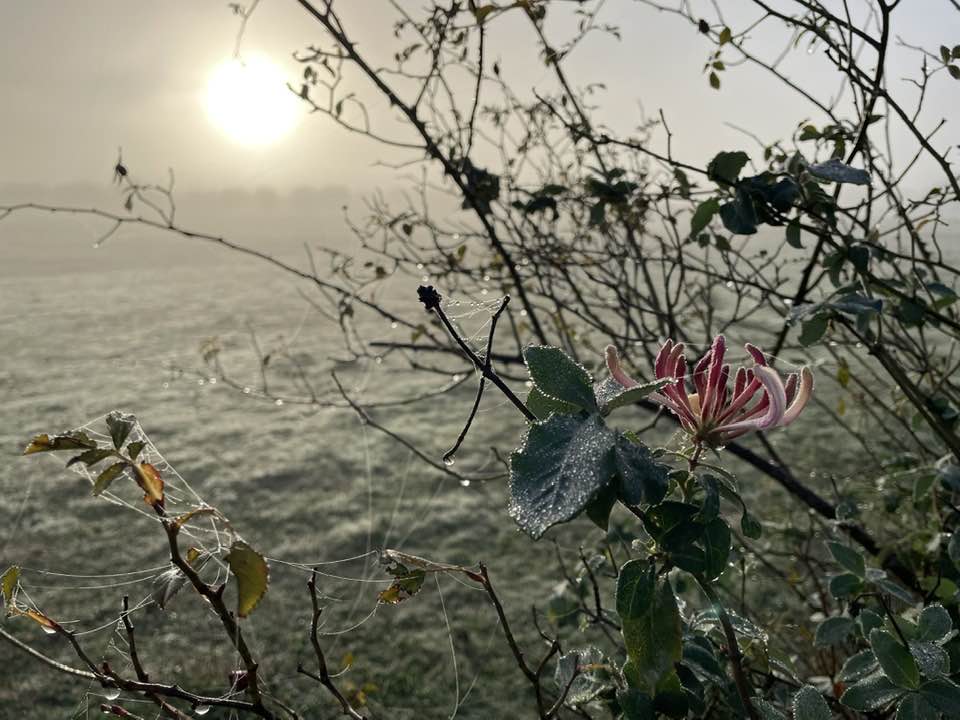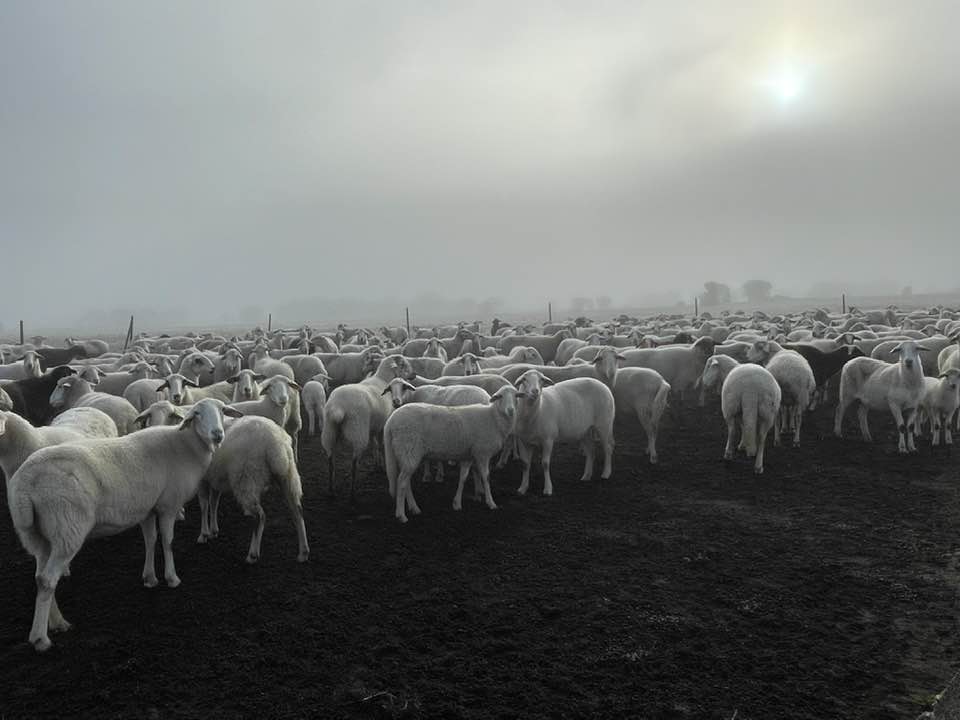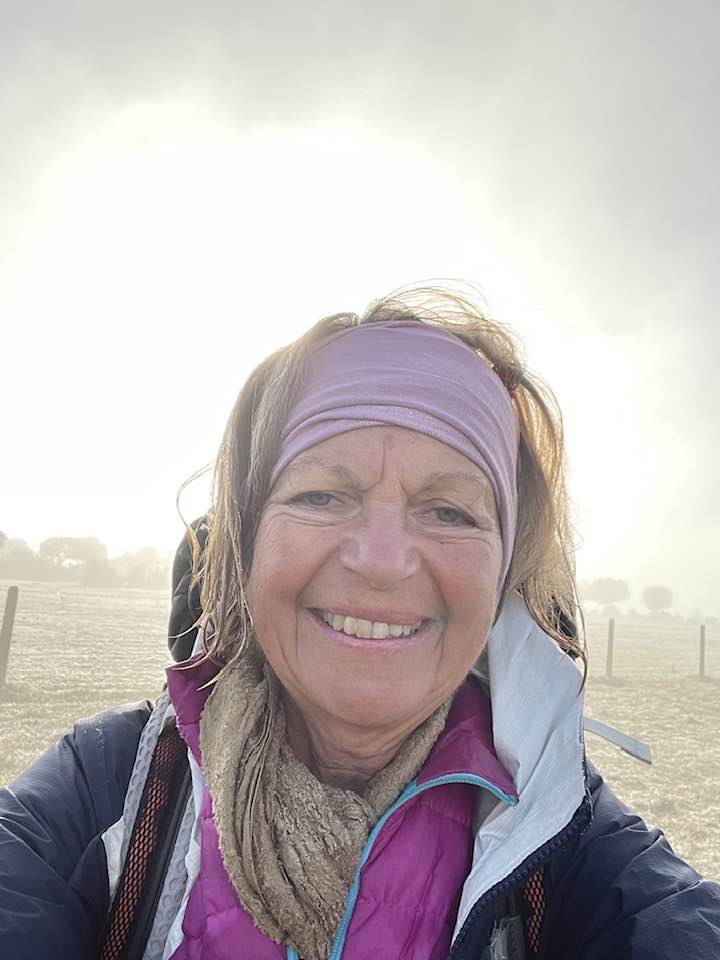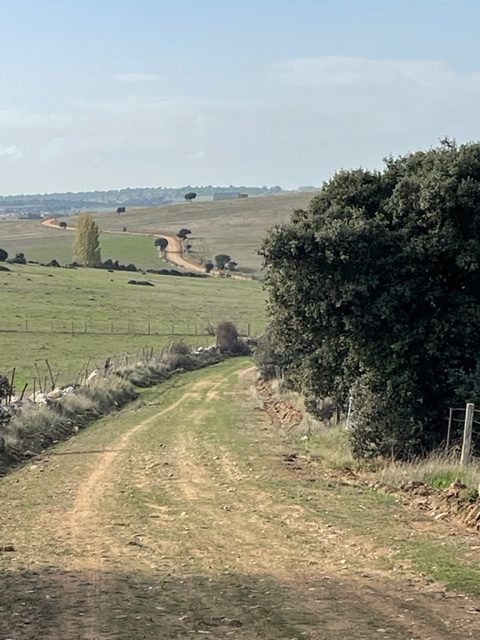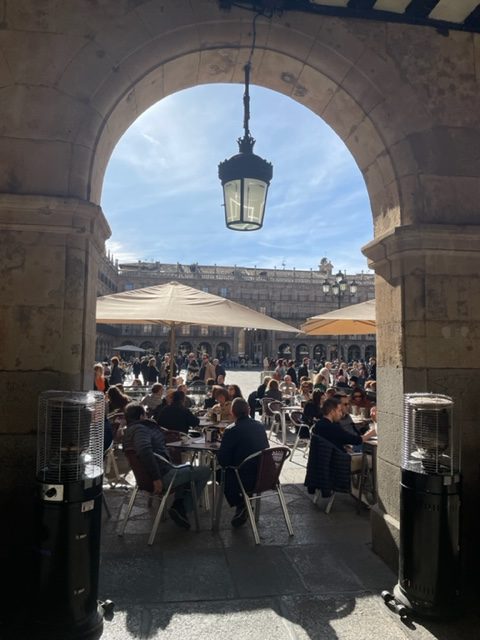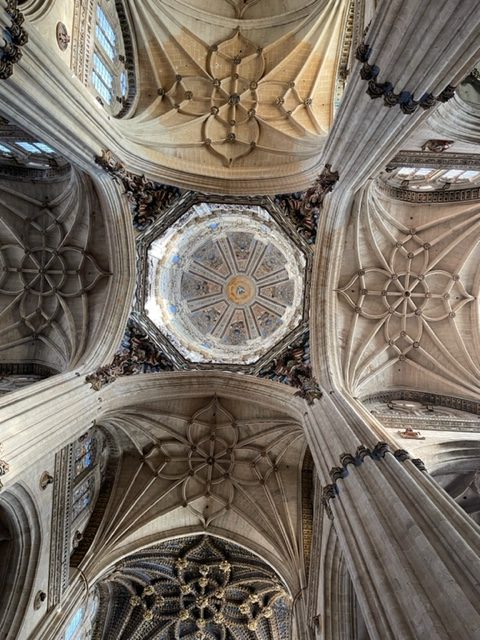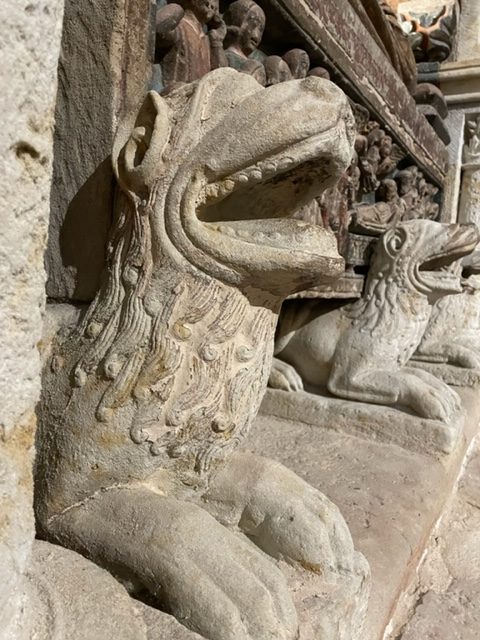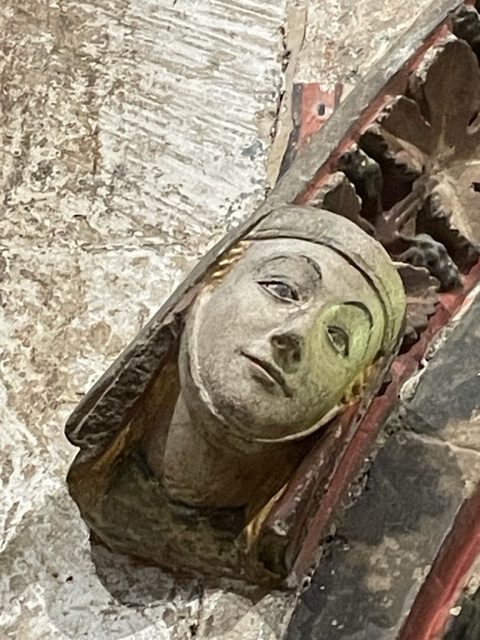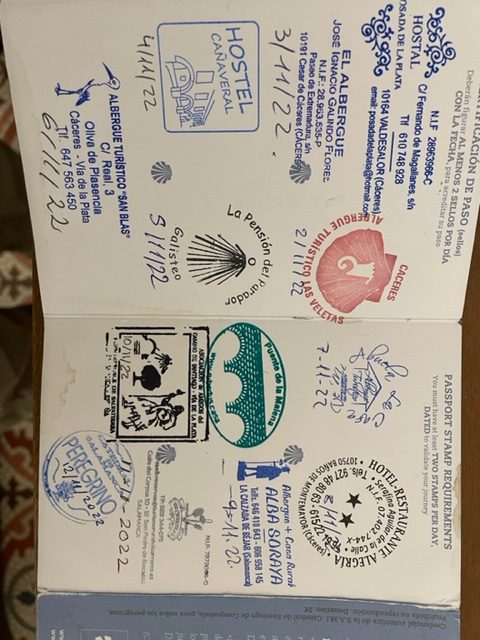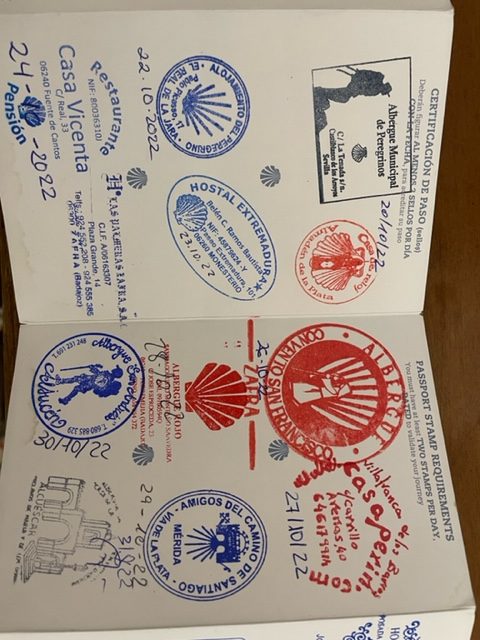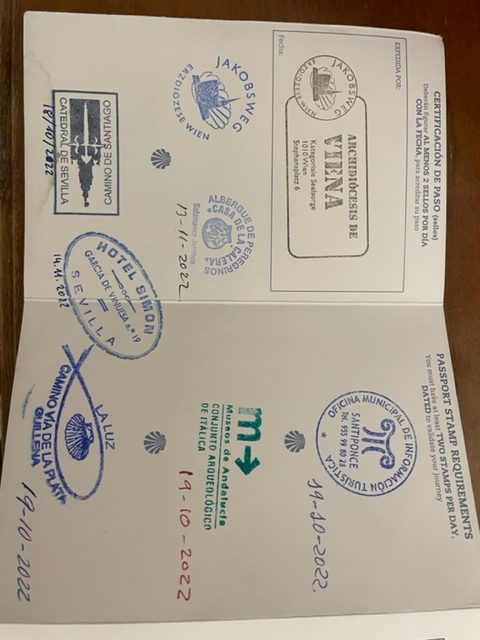Again we are fortunate to travel with our member Garyo
through Vie de la Plata, the Silver Road:
ー----
VIA DE LA PLATA
When I was looking for a possible pilgrimage starting in the middle of October 2022, I was immediately drawn to the Via de la Plata. Not only was the weather still okay for hiking in southern Spain, but the way from Seville to Santiago de Compostela seemed to have everything I loved – long stretches in nature and a richness of history and culture.
.
.
.

.
Map from internet “camino ninjo app”
.
Even before the Romans conquered the Iberian Peninsula in 206 BC, there existed a way from south to north used by hunters, shepherds and later by Phoenicians and Greeks in search for gold and zinc. The Romans fortified and enlarged the road, built bridges and camps which later became towns. This Roman road was used by the people of the great migration (Goths, Vandals…) and later by the berber tribes of Africa, who conquered the land in 711 AD. The berber tribes called the road Balath (meaning fortified street) which developed into Via de la Plata (silver road). The Islamic culture left a rich heritage, especially in the southern part of Spain
The “discovery” of the grave of apostle James in the field of stars (campus stellae) in the beginning of the 9th century started the “Reconquista”. Santiago de Compostela became, besides Rome and Jerusalem, the most important pilgrimage destination. Masses of people were motivated to fight against the “heathen” and liberate the Iberian Peninsula from Islamic rulers. By 1492, the last Islamic stronghold, Granada, was conquered and the “Reconquista” ended. During all this time, the Via de la Plata was used as the main connection between northern and southern Spain by millions of people over thousands of years.
It was intriguing to think that I could follow the footsteps of people walking this road since ancient times, that I was just a drop in the bucket joining millions with one step at a time, disappearing into the past like everybody before me. Due to time restrictions, I could not walk the entire path to Santiago de Compostela (1000 km), but I decided to end my pilgrimage in Salamanca. The distance from Seville to Salamanca is about 600 km.
I walked for 26 days with 2 days of rest. During this time, I hardly met any other pilgrims. Not only is the Via de la Plata a less frequented pilgrimage route due to extreme weather conditions and long distances to the next possible accommodation, but most of the pilgrims walk in spring when the weather is nice and everything is in bloom.
Walking a pilgrimage for me is always an opportunity to practice staying in the here and now, to be fully present in my body, to have my senses wide open and live every experience as fully as possible. I took koans, poems and words of wisdom with me in order to clear my mind. They were given to me by friends. I also packed light, but the decision to take only one pair of shoes with me became problematic.
Overall, this pilgrimage was a beautiful experience, but with challenges I did not expect. Every day, I wrote a diary about my experiences, my thoughts and feelings. Especially in the beginning, I composed haikus (most of them I wrote in German) in order to capture the moment – beside making many photos. It is a pleasure for me to share my journey with you. Please walk with me the Via de la Plata, the silver road to Santiago de Compostela.
VIA DE LA PLATA
When I left the village Castillblanco de los Arroyos at 5:30 am, it was pitch dark. I had to leave so early because my next destination was more than 10 solid walking hours away.
.
.
.

.
.
By stepping out into the night, a sweet smell like rose, jasmine or oranges filled the air. I could not figure out which plant emitted this wonderful fragrance. It was the start of a magical walk through the dark, mysterious night. Roosters announced the day in the distance, dogs communicated with each other far away, glowing eyes stared out of darkness from a curious cow, a flock of birds lifted off from the night’s rest and a wild animal rushed through dense vegetation beside the road. It did not bother me to walk on the asphalt street with hardly any traffic on it. However, with the daylight approaching around 8:30 am, it started to rain and the first part of my day’s trek was becoming more difficult.
.
.
.

.
16 km long walk on asphalt street
.
.
.

..
It was an incredible relief to reach the entrance to the nature preserve “Monte Publico Navas-Berrocal” a hilly landscape and home to cork oaks, pine trees and little creeks. It stopped raining and I had lunch in a rocky area beside a little creek,
.
.
.

//
Still a bit wet from the rain
.
.
.

.
Typical lunch I carried with me
.
.
.

.
Floating in the sky
above the ancient oak trees
a group of six birds
.
.
.

.
Treated oak trees after the bark was harvested.
I always felt uncomfortable to see the protective skin taken away from the tree.
.
.
.

.
Looking back where I came from – an endless area of cork oaks and meadows without any houses.
.
.
.

.
After 60,000 steps walking this day, I arrived dead tired in Almaden de la Plata, a village known already by the Greeks and Romans for its blue marble. I had booked a bed in the charming house “Casa Del Reloj” and enjoyed being the only pilgrim.
.
.
.

.
My room with a view to the main plaza of the village
.
.
.

.
Church built in the 16th century
.
The next day I could relax a bit – the distance to the next village was only about 16 km. I walked through a hilly area with gorgeous vegetation – pastures with oak trees, bushes of thyme and anis and little ponds where the Iberian pigs were able to take a bath. I also met the two pilgrims I had seen before – the French cook Yannik and the Italian cook Lorenzo.
.
.
.

.
On my pilgrimage, I saw many black Iberian pigs running around freely in search of acorns. They are treated in a way animal should be treated – with respect. These in the photo above have their own pond where they could swim.
.
.
.

.
Whenever I went along a pasture of pigs, they came to the fence to figure me out. Very often, they accompanied me and were running beside the fence as long as possible.
.
.
.

.
Lorenzo and Yannik, the first pilgrims I met. Yannik, a passionate meat eater and chain smoker, made fun of me when I admired the pigs in their natural beauty. He, as a cook, only saw in them a provider for food. However, he suggested harvesting the wild thyme, which I did. I used it to make thyme tea on my trek.
.
.
.

.
On the lonely street
bushes of blue-green
speak of yellow spring
.
The goal for the day was the village El Real de la Jara. It is on the border of the region Asturia and the vast area Extremadura. Extremadura is as large as Switzerland and very thinly populated. It consists of many natural areas and nature parks, where black storks and large colonies of vultures floating in the sky still can be seen. Entering Extremadura means for pilgrims many long stretches of walks with few possibility to stay overnight.
.
Hiking through the region Extremadura
The name of the region reveals that Extremadura is an area of extremes, not only historically but also geographically. During Roman times, Merida in Extremadura was the most important Roman town on the Iberian peninsula. A network of Roman roads connected it to other cities. As the Via de la Plata follows the Roman road to the north (Calzada Romana), it leads to towns with a lot of Roman architecture. After the Romans left, the area lost its importance and was falling into poverty. For several centuries, Extremadura was the main region of emigration to S-America. Francisco Pizarro and Hernan Cortez came from this region.
Extremadura is known for the large Dehesas, which are huge pastures were cork oaks and holm oaks provide the “bellotas” (acorns) especially for the very high prized Iberian black pig.
Without much infrastructure, the long stretches of walks between settlements can be a challenge for pilgrims walking the Via de la Plata through Extremadura (nearly 400 km).
.
.
.

.
Between the stone walls
not yet alone anymore
a little black bug
.
.
.

.
This beautiful horse was checking me out.
.
.
.

.
Castillas de las Torres (13th century) built by the knights of the order of Santiago. They provided safety for pilgrims and also for the drovers leading animals (mainly sheep) on the Via de la Plata. The Canadas Reales (walkways for animals protected by the king) followed the Via de la Plata.
.
.
.

.
It had recently rained and some pastures looked like meadows in springtime
.
.
.
My first destination in the region of Extremadura was a town called Monesterio (got its name from a monastery founded by the knights of the order of Templar), but the monastery is not there anymore. Instead, the town is the most famous center of the highly prized “Jamon Iberico de Pata Negra”. Just before entering the town, I walked through a forested area with a dead, rotting pig – an interesting introduction to the town.
.
.
.

.
Rotting, dead pig beside my path
.
It was rainy when I arrived in Monesterio and I followed the instructions of my navigator to lead me to the recommended Albergue municipal. It was closed! I could not believe it!
.
.
.

.
I had a bad headache (maybe by not drinking enough water), needed urgently to use a bathroom and wanted to just have a place to rest. I called several places, but everything was closed. Finally, somebody who could speak English recommended Hostal Extremedura. They had a room for me – what a treat! I had a private room, a bed with pure white cotton bedding, a bathtub and a wonderful, big towel! Being grateful for simple things is something I had learned on a pilgrimage. The owner also recommended an actualised app for pilgrims looking for accommodations – very helpful!
.
.

.
A loyal watchdog guarding a herd of sheep
.
Although seemingly boring, I loved the walk on the wide open fields of the Dehesa for the next two days (about 50km). On the High Plateau, endless fields of brown, warm earth stretched to the horizon and merged with the sky above. Sometimes, only broom bushes were growing beside the road, speaking of spring when everything is in bloom. Now they were resting.
.
.
.

.
.
.

.
.
.
.

.
.
Every so often the dried blossoms of thistles merged with the dry, golden grass beside the road, enjoying the beauty of the fall season.
.
.
.
.

.
Olive orchard in the distance
.
.
.

.
A long time ago, a goat was caught in the fence, but even the skull was beautiful!
.
.
.
.

.
However, not really visible by seeing but by hearing and smelling, was the industrial food production in this area. Pigs were kept in large halls and even from a far distance, I heard their heartbreaking cries. Sometimes, the smell of manure was unbearable. It was probably spread on the fields.
.
.
.

.
The route of the pilgrimage is well marked, especially in Extremadura. It would be dangerous to get lost without any water source or settlements for miles and miles. These granite cubes show not only the direction of the way (yellow arrow and shell), but indicate also if the route follows the former Roman road (yellow-green square).
However, after walking so many miles on a flat surface with my barefoot shoes, I felt that my left foot was starting to hurt, but I was dedicated to make the pain my friend and walk with it.
.
.

.
Pain in my left foot –
how about we are good friends
one step at a time
.
.
When I arrived in the village of Calzadilla de los Barros, my friend, Mr. Pain, occupied my entire attention and did not stop bothering me. I had to do something and was lucky – I passed a pharmacy! I bought medicine suggested by the owners. They also recommended a hotel in the next town, Zafra.
.
.

.
Despite the healing creme, the pain became nearly unbearable. I tried to put weight on different parts of my foot and not stiffen up. It helped a bit. My speed of walking was extremely slow. By the time I entered the town Zafra, I could not walk anymore. I booked a room in the Hotel Palmeras, a beautiful old hotel in the center of the city, and stayed there for two nights.
Zafra
My feet urgently needed a day of rest and the timing was perfect – Zafra is a town with the narrow, bent streets, radiant white houses with black wrought iron fences on the balconies, Plazas with restaurants and cafes and the birds living in the palm trees chirping all day. I immediately was falling in love with this town!
.
.
.
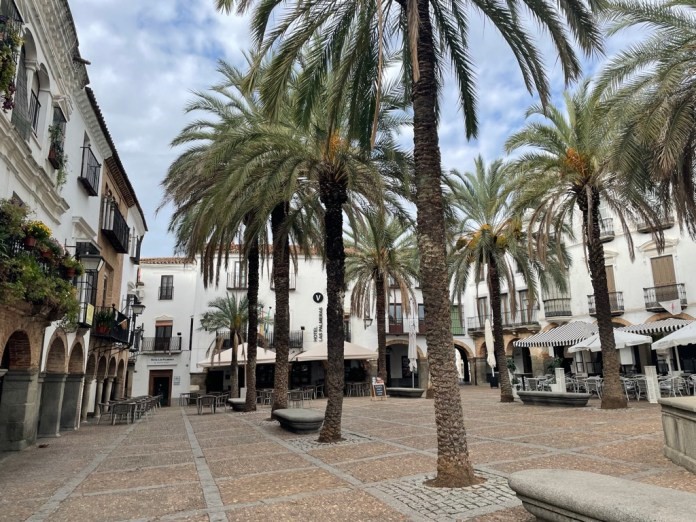
.
Plaza Grande (used for bull fights in the 16th century) with the hotel Palmiras at the far end to the left
.
My hotel room was so charming that I did not mind hours of resting. But I needed new shoes. The receptionist recommended a shoe store very close to the hotel and I bought two pairs of shoes. The owner of the store and his wife were very helpful, provided a box where I could ship my barefoot shoes and other things back to Austria. The owner, Frank, even went with me to the post office and carried the box – a very warm and gentle human being. I was very grateful for his help!
.
.
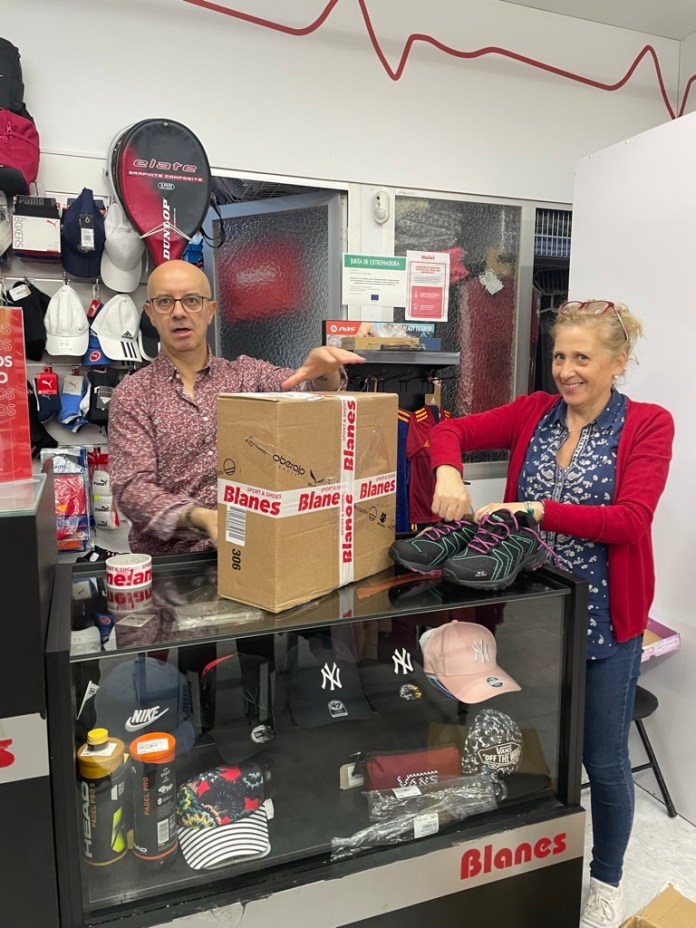
.
Shoe store with husband and wife preparing my box for shipping
.
In the afternoon, I went for a short walk through the city, trying my new shoes. They felt so much better to walk in.
.
.
.
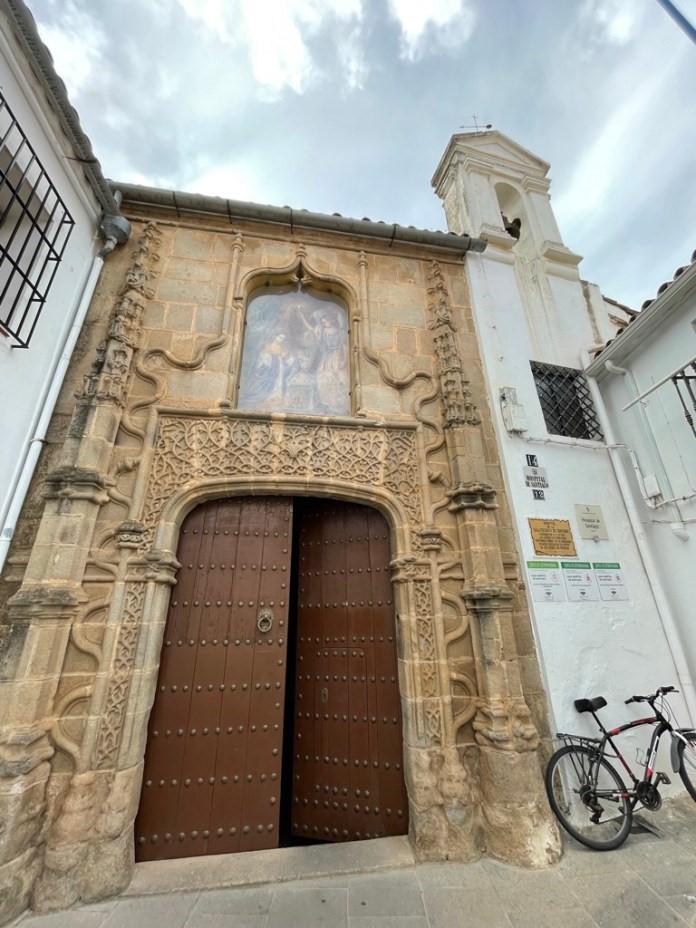
.
I could see this gothic entrance to a hospital from my hotel room
.
.
.
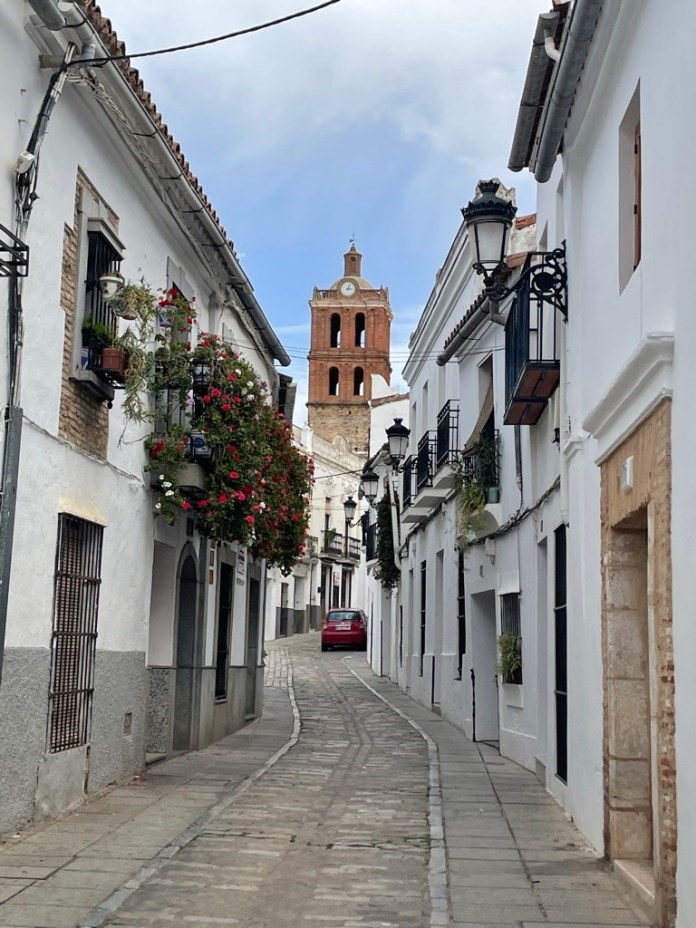
.
One of many narrow streets
.
.
.
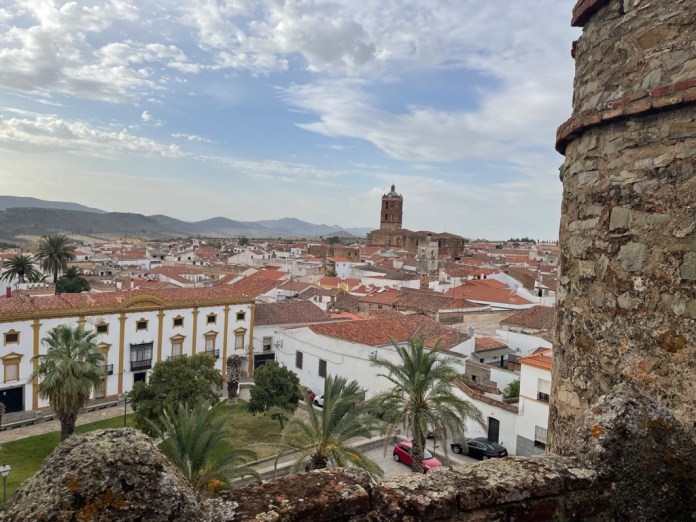
.
View from the Alcazar (castle) built in the 16th century, now a luxury hotel
.
.
.
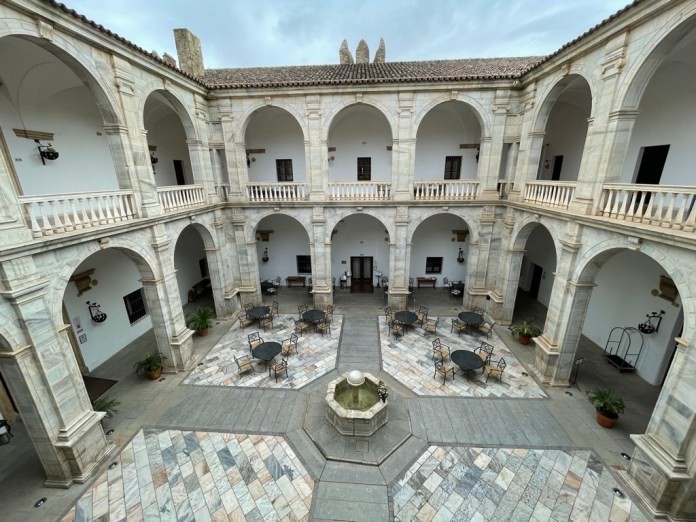
.
Inner court of the luxury hotel Parador
.
.
.
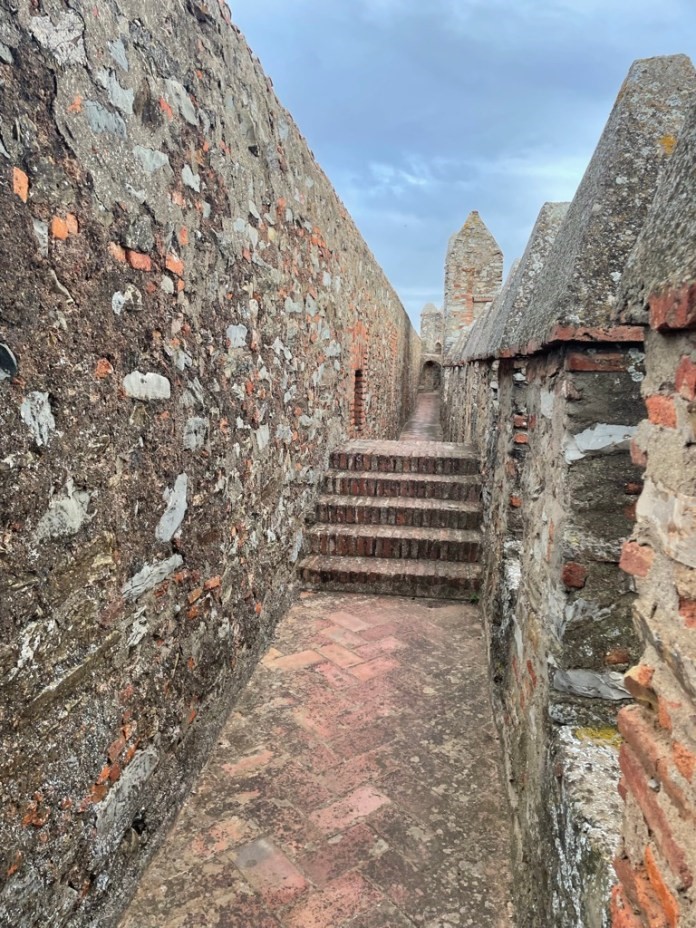
.
Defensive corridor of the former castle
.
I was able to walk all around, but had troubles with the stairs – it was hurtful and I had to hold on to the wall.
.
.
.
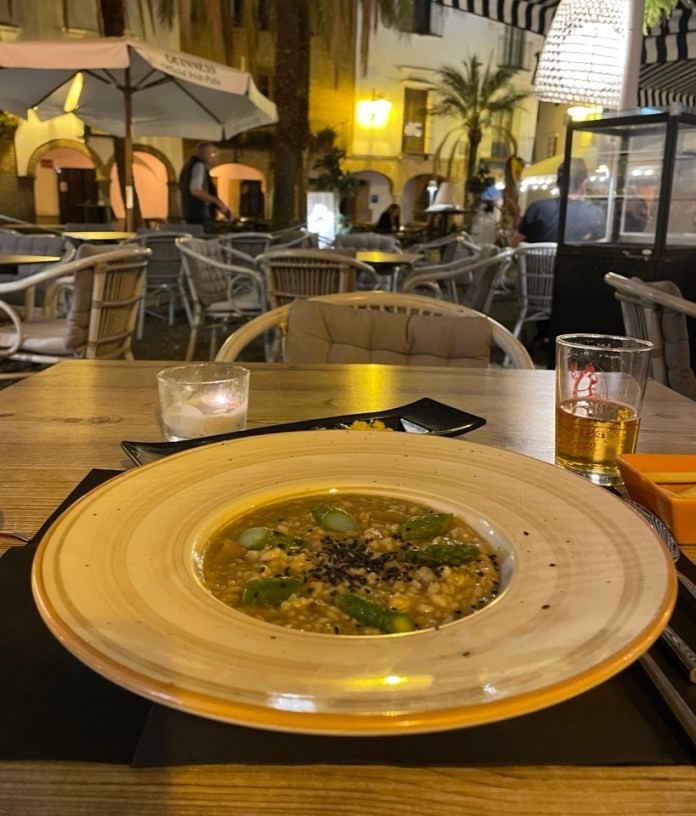
.
Every evening, I enjoyed cerveza chica ( a small beer) with the meal. Most of the time, I had troubles with the menu. I did not speak Spanish and it was impossible to use the google translator for food. For example, Revuelta de la casa was translated as “scrambled house” or 1/4 cabrito as “1/4 of a child”. This was not a country for vegetarian meals. Often, I ordered a hamburger.
Limping and still with a swollen foot, I left Zafra after a wonderful day of rest. The shoes provided a better cushion to the ground and the two walking sticks helped to ease off my weight a bit.
I hiked through a hilly countryside with olive trees. grapevines and meadows. The warm, red soil of some stretches of the path reminded me of Sedona in Arizona.
.
.
.
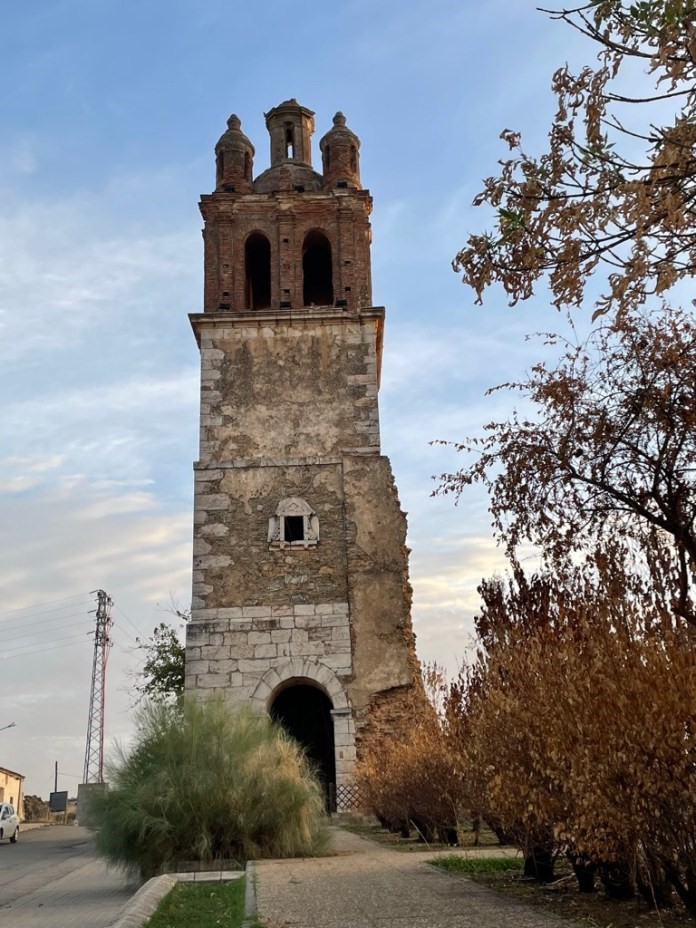
.
Torre de San Francisco, the remains of a monastery
.
.It seemed that this beautiful tower on the outskirts of Zafra was not valued much.
.
.
.
.
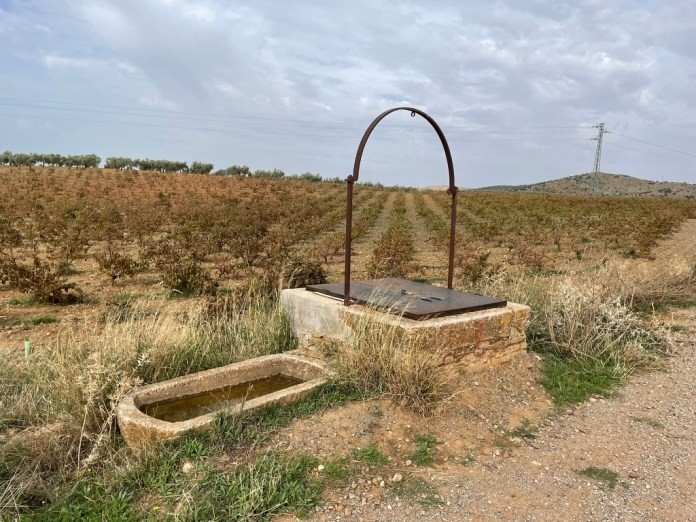
.
Rows of vineyards with an old, covered well
.
.
.
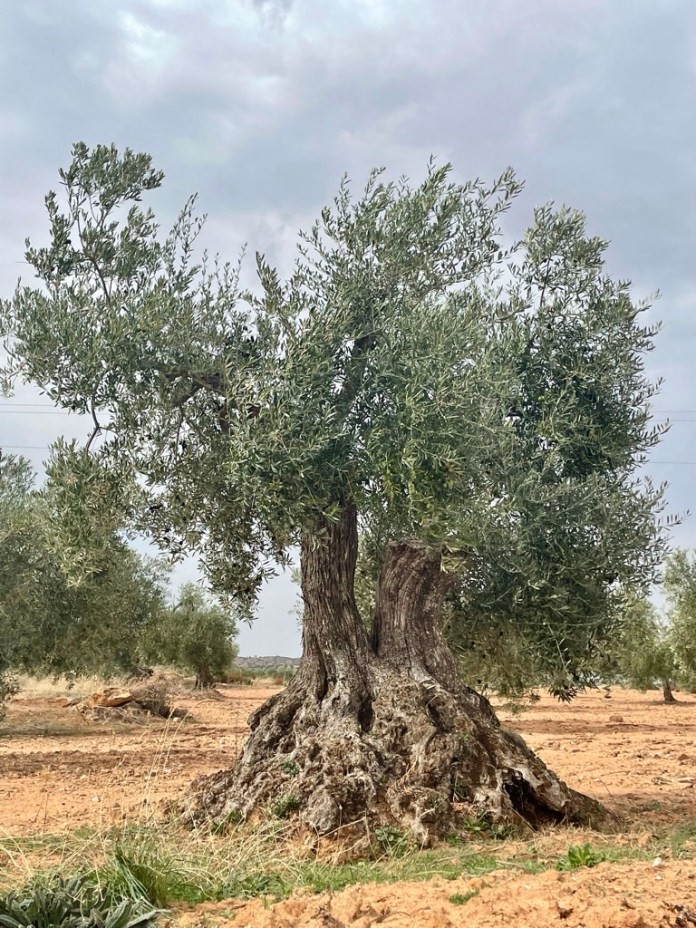
.
The uniqueness of each old olive tree always fascinated me
.
.
.
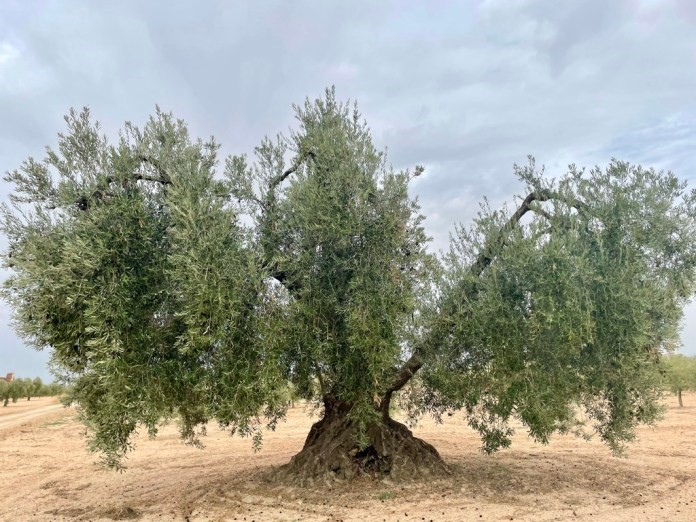
.
Elegant beauty –
Not young anymore
the olive tree beside me
.
.
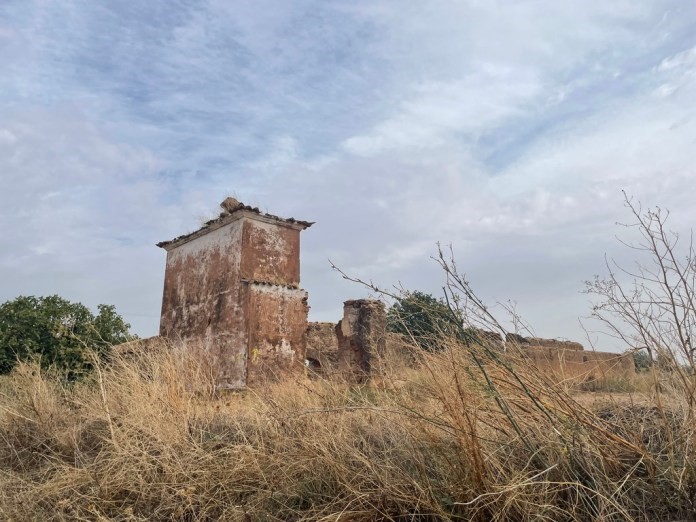
/
The remnants of an olive press
.
.
.
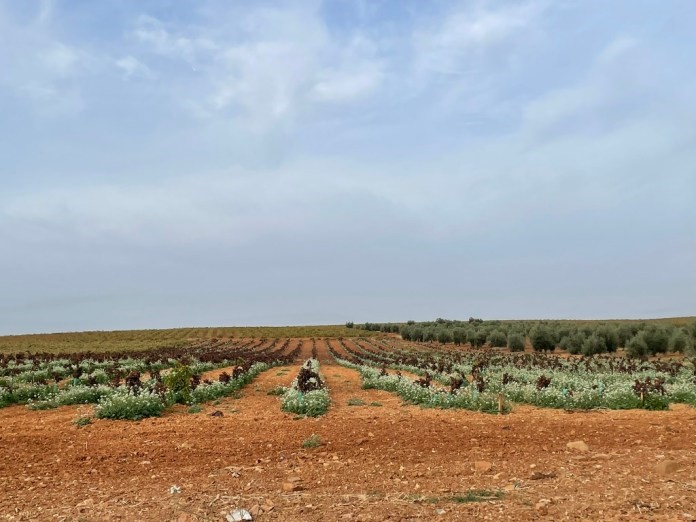
.
Endless red soil with grapevines
.
.
.
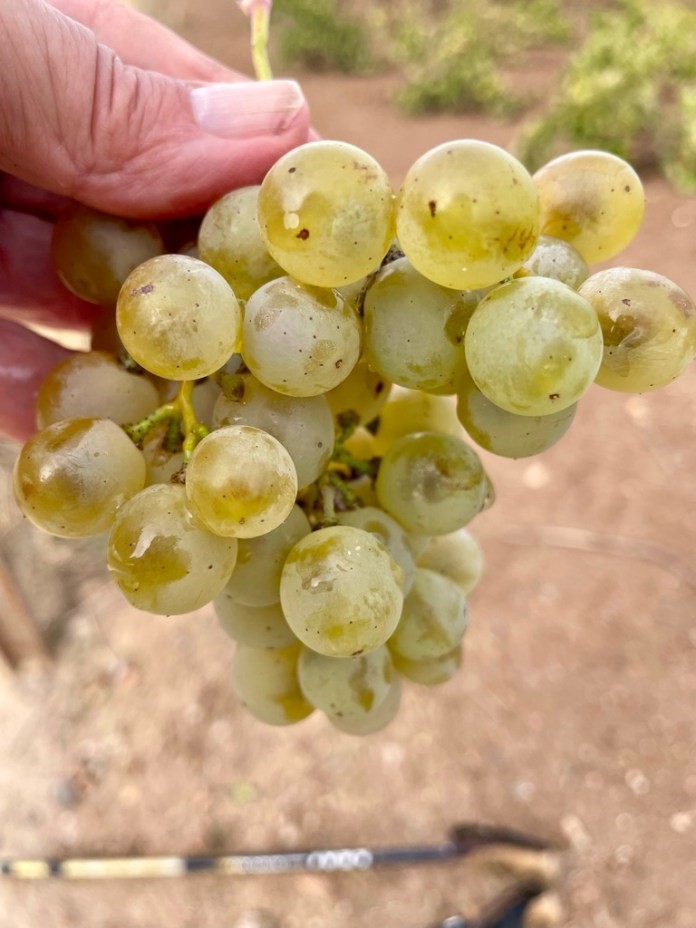
.
Sometimes, I found grapes still on the vine
.
.
.
.
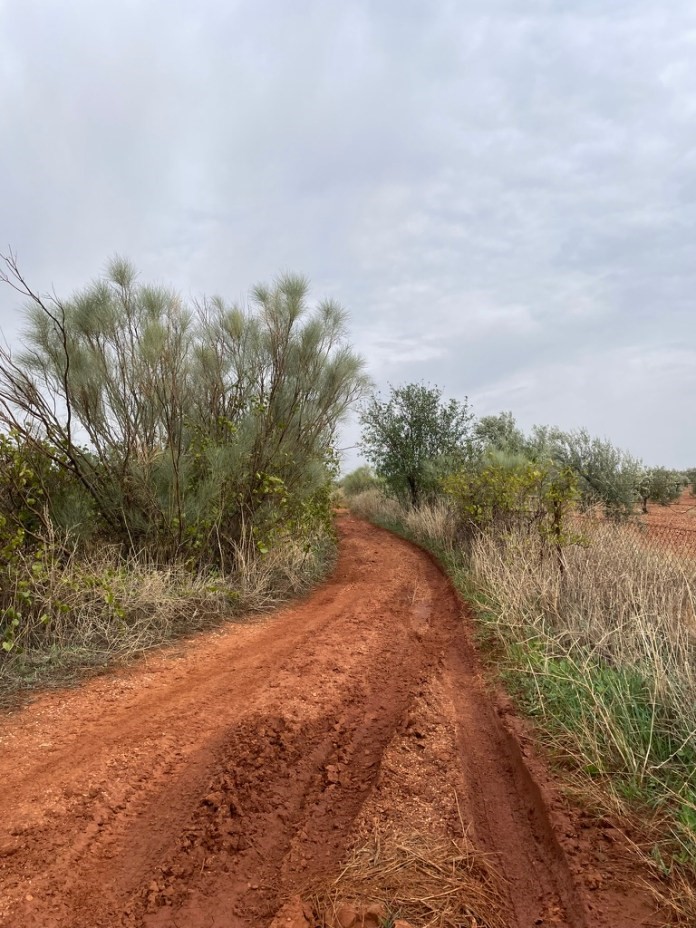
.
After the rain
.
.
.
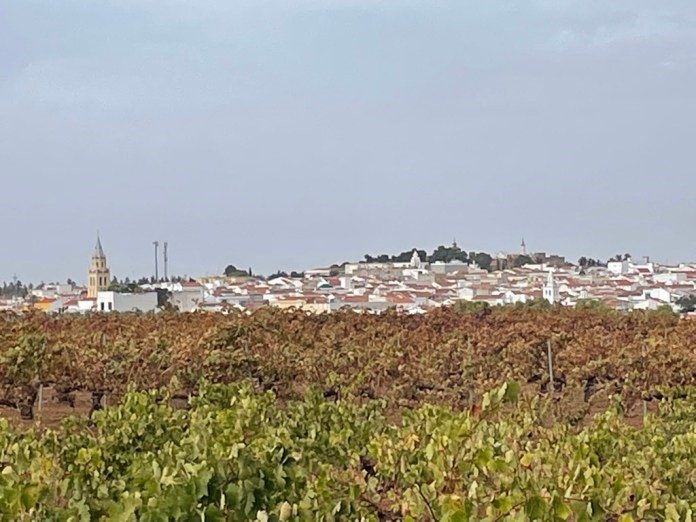
.
Approaching the town Villafranca
.
.
.
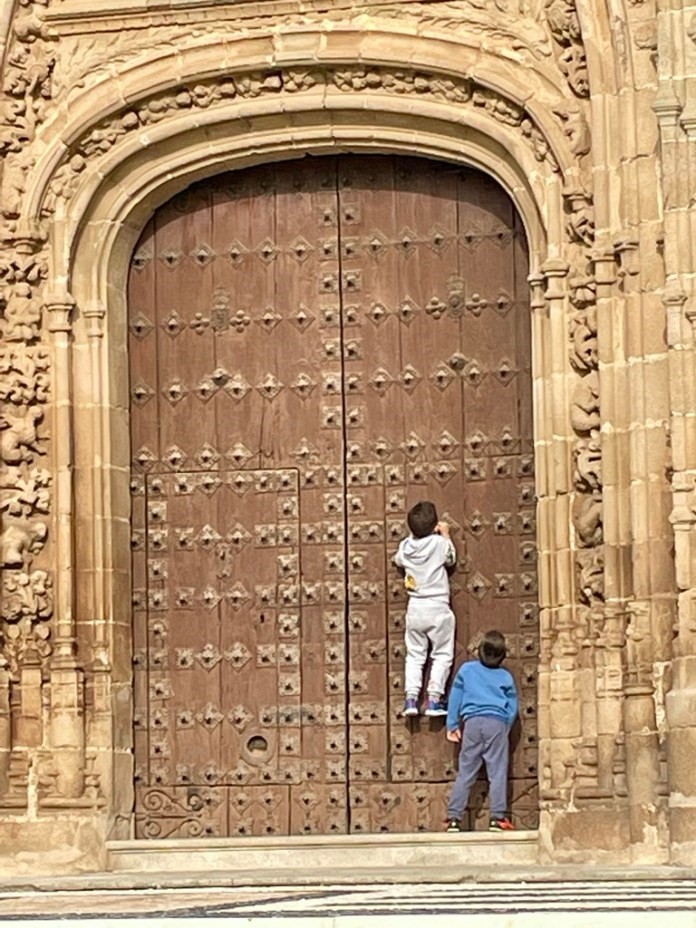
.
Two little boys using the church gate for climbing exercises in the town Villafranca de los Barros
..
.
.
.
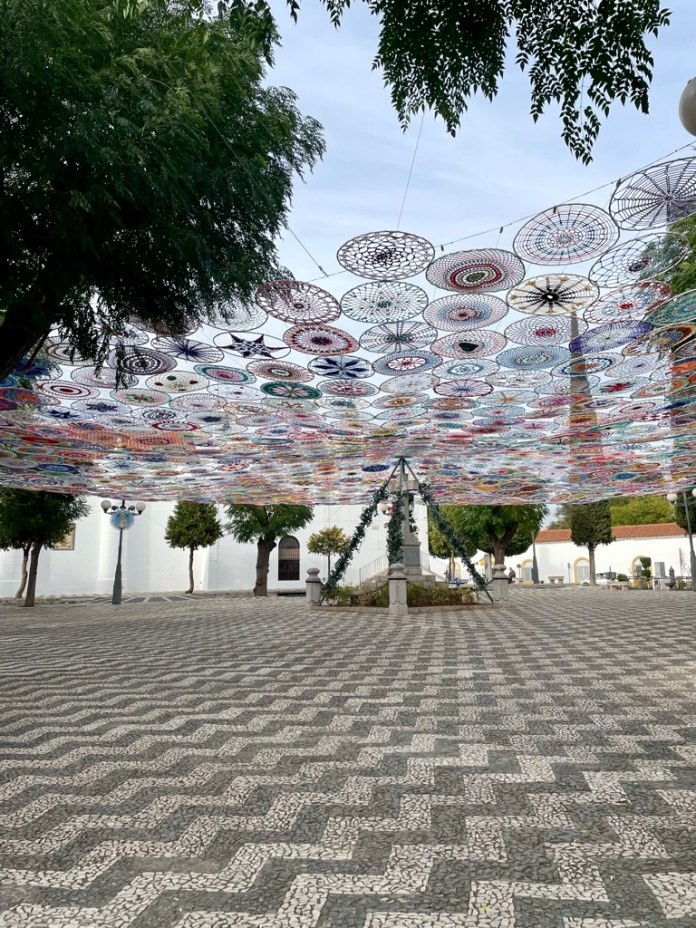
.
A community project of knitting circular pads hanging near the hotel I stayed overnight
.
.
.
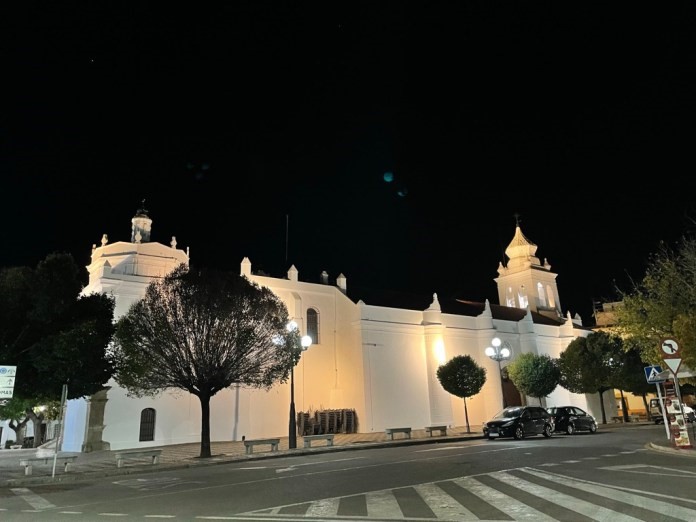
.
It was dark when I left Villafranca for the next town, Torremejia. I had to walk 30km with no houses in between, including a 16 km long former Roman road. Endless vineyards and rows of olive trees stretched to the horizon. Most of the time, no other plants were allowed to grow in between the designated plants and I was reminded of the industrial exploitation of land in agriculture. I used this toneless, unchanging landscape for my meditation practice and focused on breathing, on feeling the ground under my feet, listening to my steps and composing haikus.
.
.
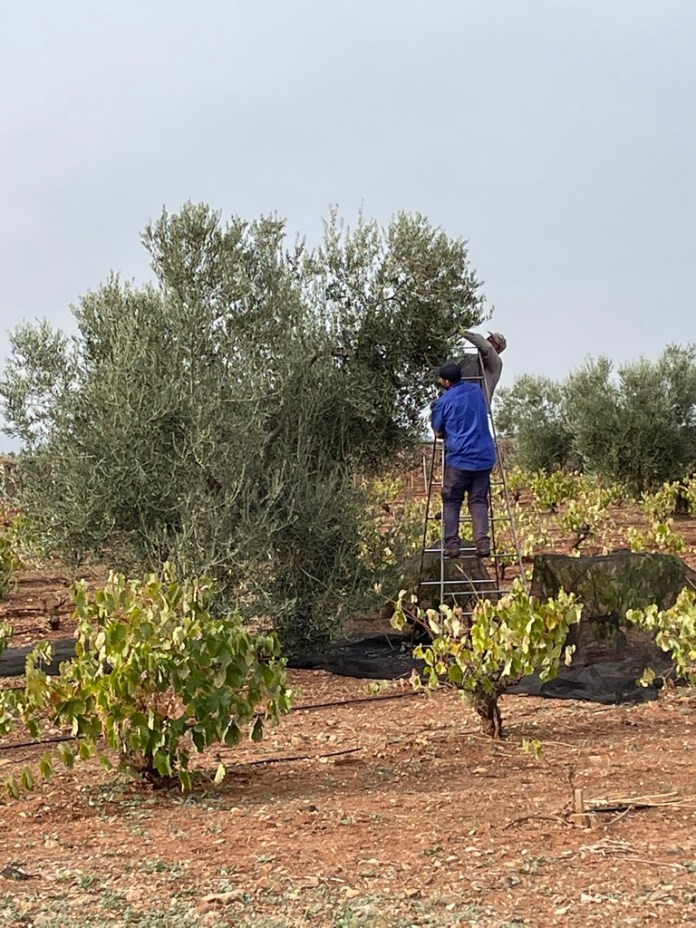
.
Two workers harvesting olives with a tool shaking the branches. The olives are collected in the black fabric on the ground. The smaller plants are grape vines.
.
.
.
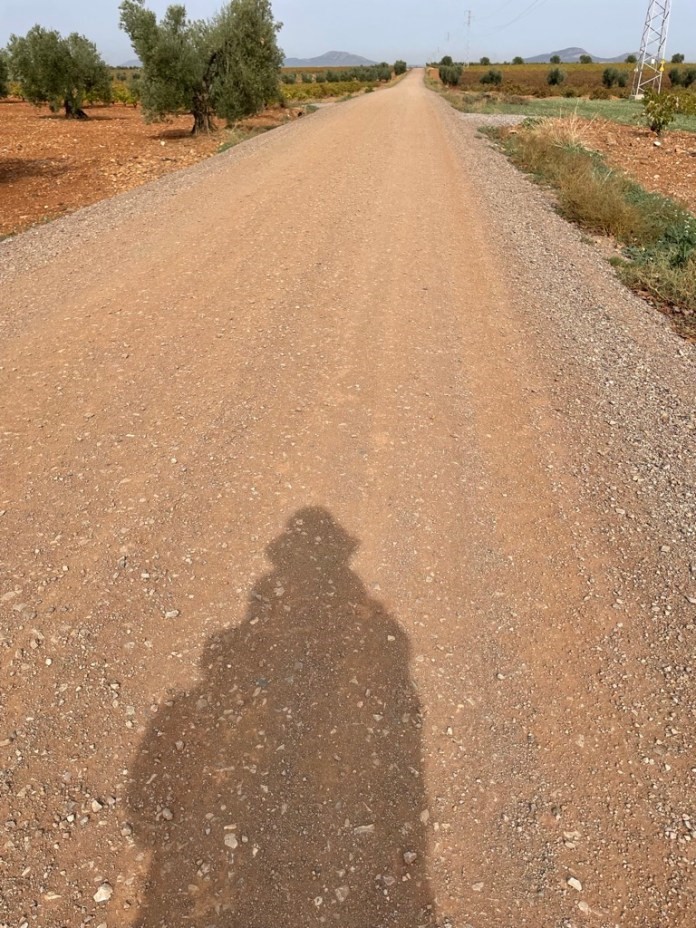
.
This is the former Roman road leading straight to the North (for 16 km)/
.
There was almost no traffic and I walked in the middle of the gravel road for hours. At one point, I wanted to make a photo of my shadow on the street. I prepared my camera, leaned my walking sticks left and right on my hips and was ready to click, when I heard a car behind me. I stepped to the side without seeing the tiny slope, slipped and landed with my full body on the ground. The left side of my head hit the gravel and started immediately to bleed. The driver of the car stopped, said something in Spanish I did not understand and offered me a ride to the next town. I did not need it. The injury was only on the surface.
Walking the long road
with the shadow before me
breathing in and out
/
/
/



























